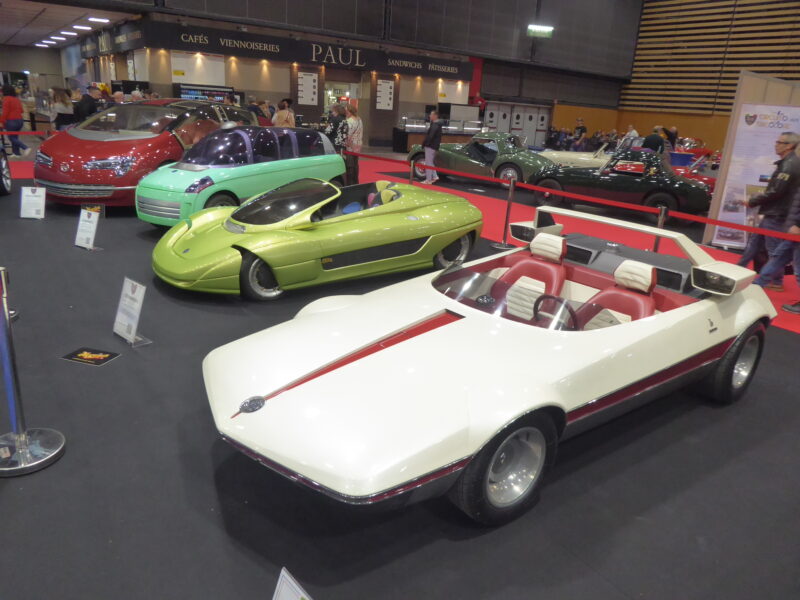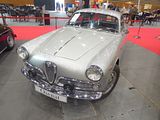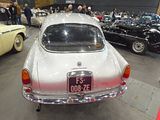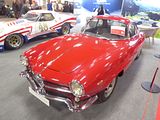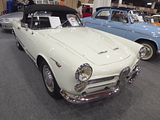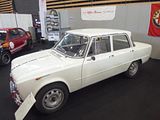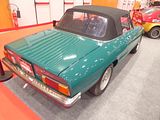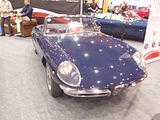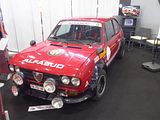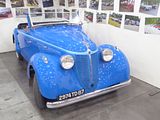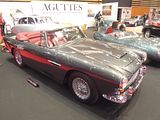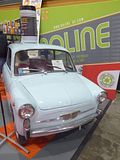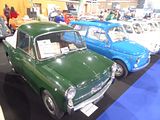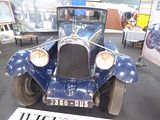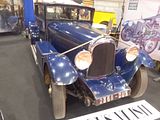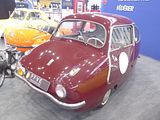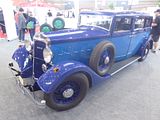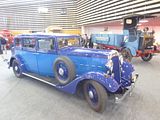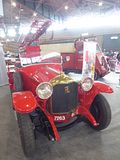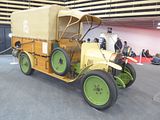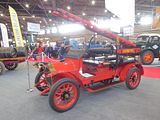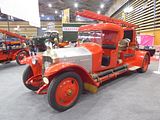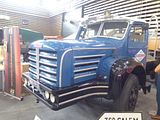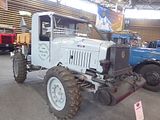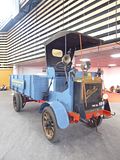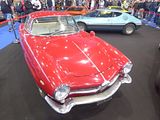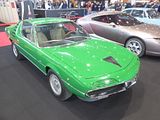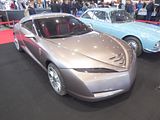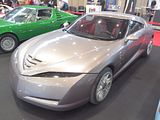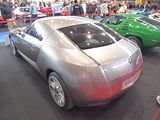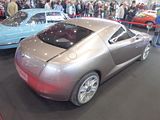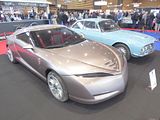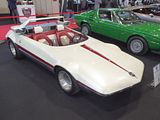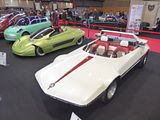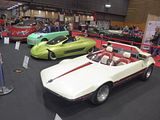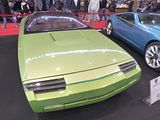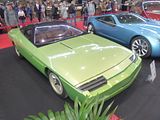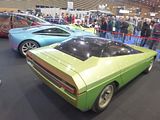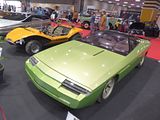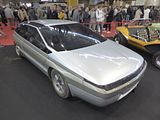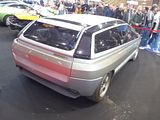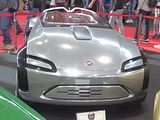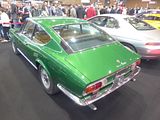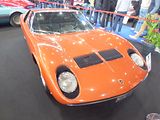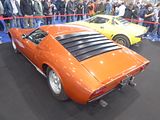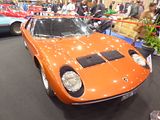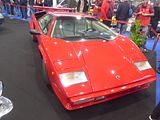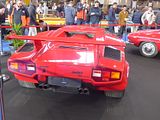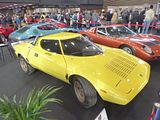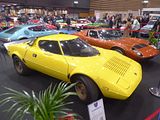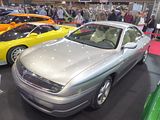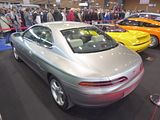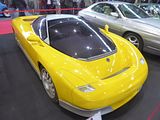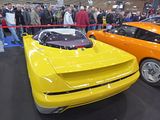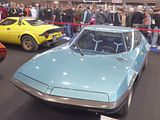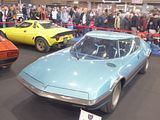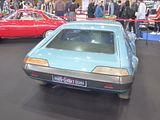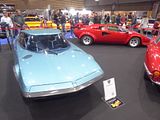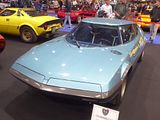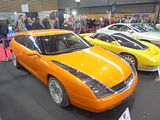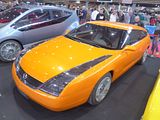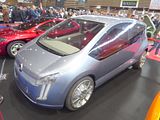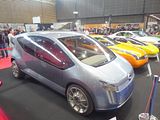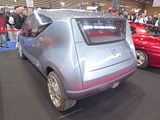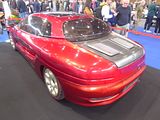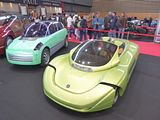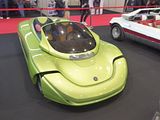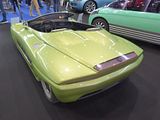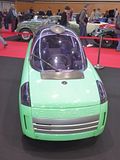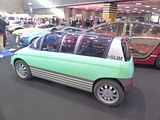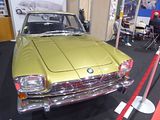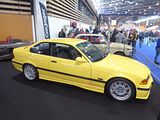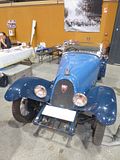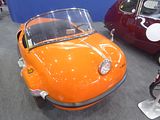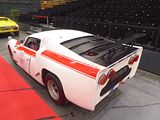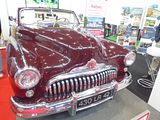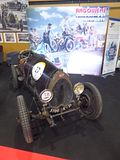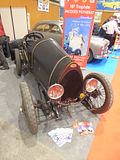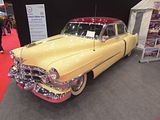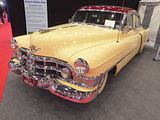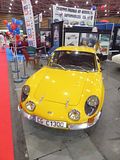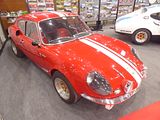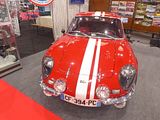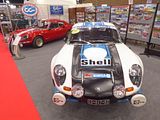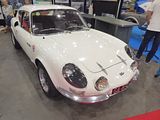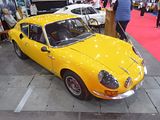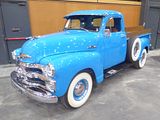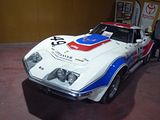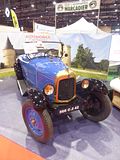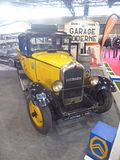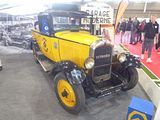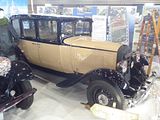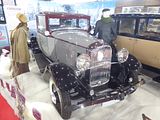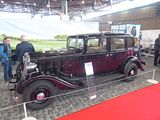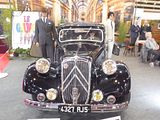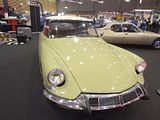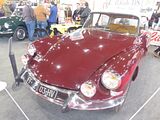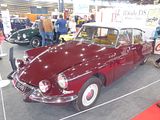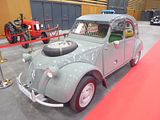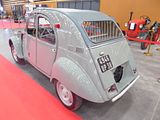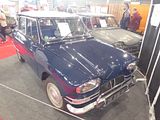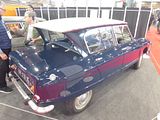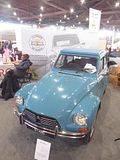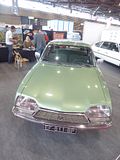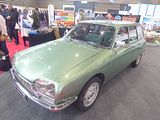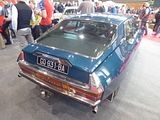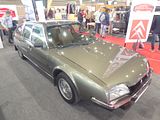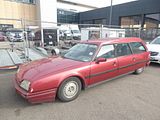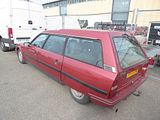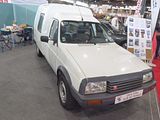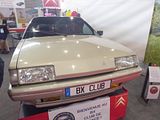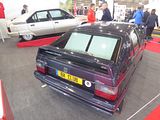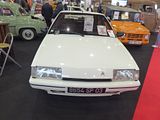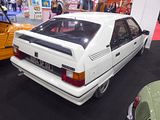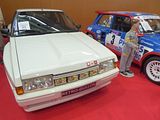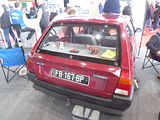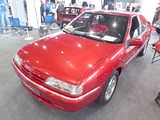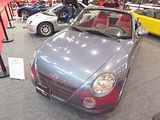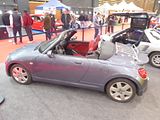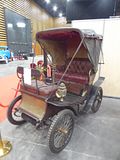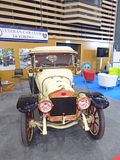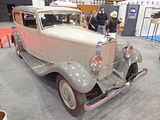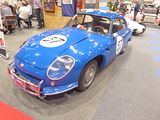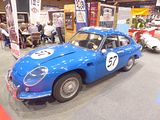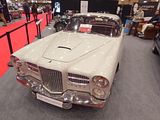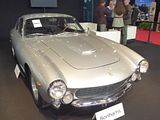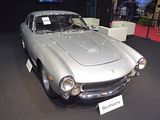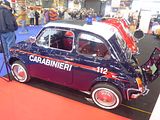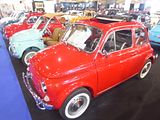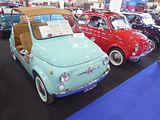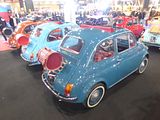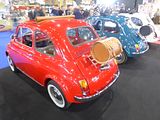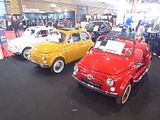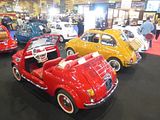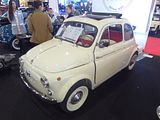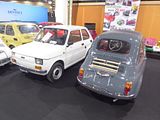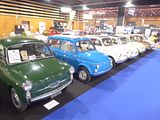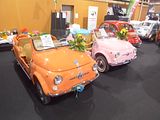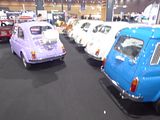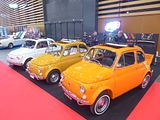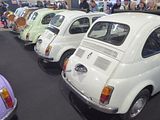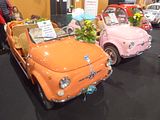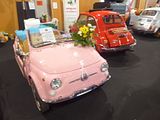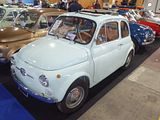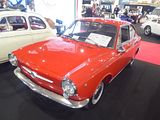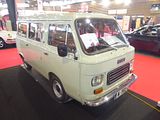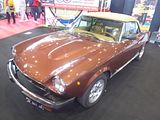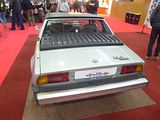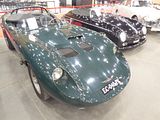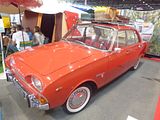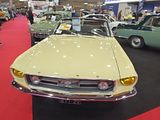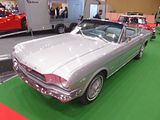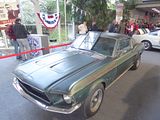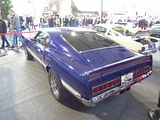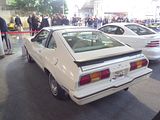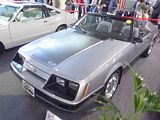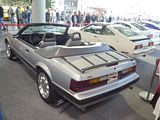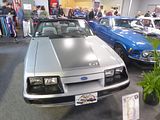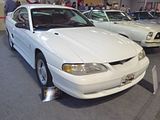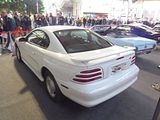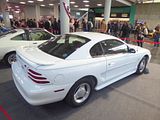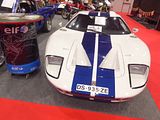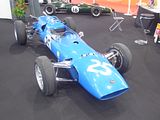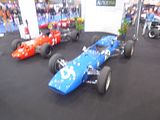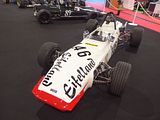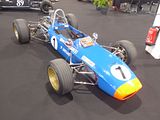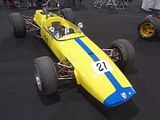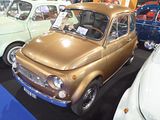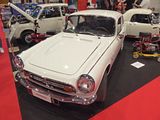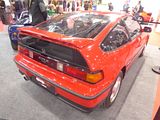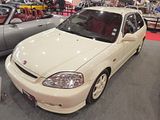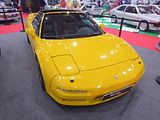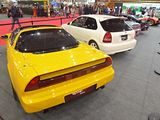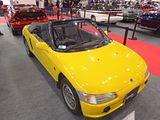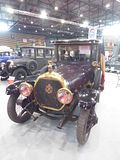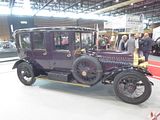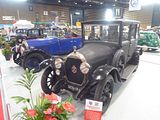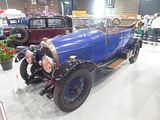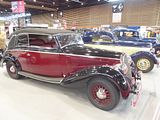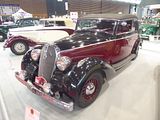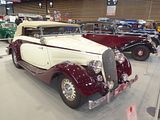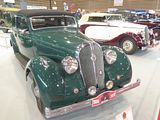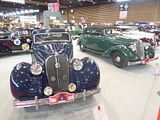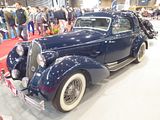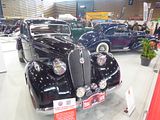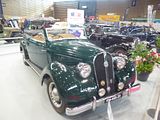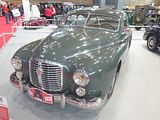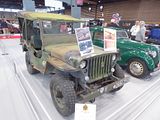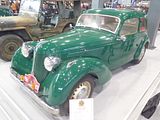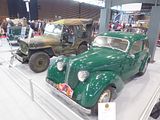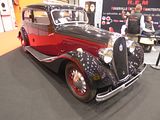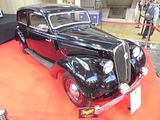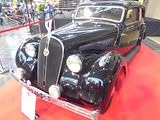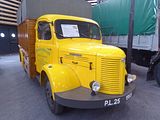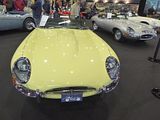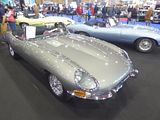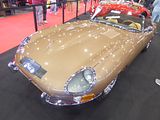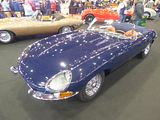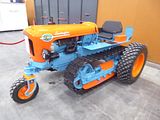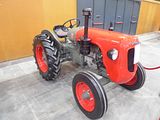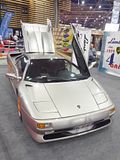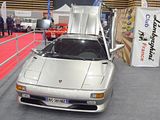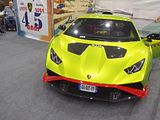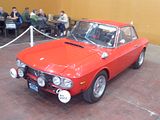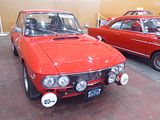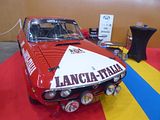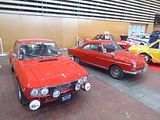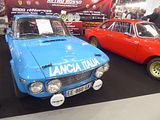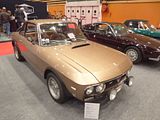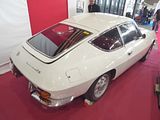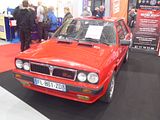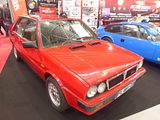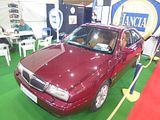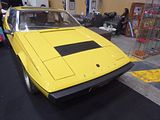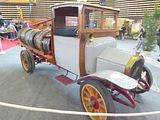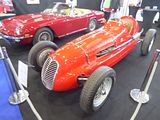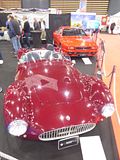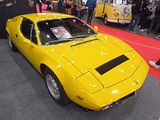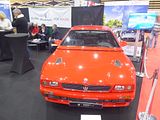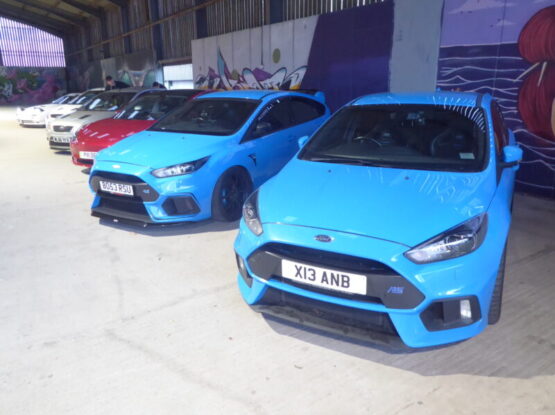It was a conversation with my French friend Alexandre Genest which alerted me to this event. He said it is one of the biggest and best and the way he described it, I felt I just had to research whether it was practical to attend. What I found out is that in fact Epoqu’Auto has been running for a very long time, as the 2024 event would be the 45th edition. It takes place at the EurExpo, an exhibition centre located to the north of Lyon, and around 15km from the airport. There are direct flights which made it perfectly possible to fly in on Friday evening and home on Sunday evening.
The EurExpo complex comprises 7 interconnected halls that radiate out from a central hall and atrium area. It meant that the exhibition felt more compact than some other sites, even though it is actually pretty expansive, covering 88,000 square metres. Contained within those halls are a mixture of special displays, in excess of 200 Car Club stands, over 560 dealers including plenty of autojumble traders and an area for sale both of private cars and an auction. There’s plenty to look at, and when you get hungry there are a number of quality food outlets that will sell you everything from a coffee or a sandwich to a full three-course meal. There’s an even more impressive outdoor display area, and that features in a separate report. The event is very popular. In excess of 100,000 visitors came over the course of the weekend and at times it really felt like I was battling with all of them, but it did empty out during Saturday afternoon and I was able to get a good look at most of the cars and get the photos presented here:
ALCYON
This is an 870R. The Alcyon was a French bicycle, automobile and motorcycle manufacturer between 1903 and 1954. Alcyon originated from about 1890 when Edmond Gentil started the manufacture of bicycles in Neuilly, Seine. In 1902, this was complemented by motorcycle production and in 1906, the first cars were shown at the “Salon de l’Automobile” in Paris, France. Also in 1906 it founded the professional Alcyon cycling team which was active until 1955, including winning the Tour de France 6 times. Two voiturette models were shown in 1906, one a two-seat light car with single-cylinder 950 cc engine and a larger four seat model with 1.4-litre four-cylinder engine. Both engines were bought in from Gentil. The cars were advanced models with 3-speed gearboxes and shaft drive. However, the single-cylinder models were dropped in 1912 and larger models of up to 2120 cc were added to the range. By then, most of the engines were obtained from Zurcher. The company moved to Courbevoie, Seine in 1912. In 1954 Peugeot absorbed Alcyon.
ALFA ROMEO
Following the 1900 family, Alfa’s next new model range would be cheaper and aimed at capturing some of the market from middle class buyers. Known as Giulietta, the 750 and later 101 Series were a series of family-sized cars made from 1954 to 1965, and Alfa Romeo’s first, successful, foray into the 1.3-litre class. The first to be introduced was the Giulietta Sprint 2+2 coupé which was premiered at the 1954 Turin Motor Show. Designed by Franco Scaglione at Bertone, it was produced at the coachbuilder’s Grugliasco plant, near Turin. A year later, at the Turin Motor Show in April 1955, the Sprint was joined by the 4-door saloon Berlina. In mid 1955, the open two-seat Giulietta Spider, featuring convertible bodywork by Pininfarina arrived. The Giulietta used unibody construction and a front-engine, rear-wheel-drive layout. Front suspension was by control arms, with coaxial coil springs and hydraulic dampers. At the rear there was a solid axle on coil springs and hydraulic dampers. The axle was located by a longitudinal link on each side, and by a wishbone-shaped arm linking the top of the aluminium differential housing to the chassis. All Giuliettas (save for the last SZ examples) had hydraulic drum brakes on all four corners. The Giulietta used an Alfa Romeo Twin Cam straight-four of 1290 cc, with an aluminium alloy engine block and cast iron inserted sleeves. Bore and stroke measured 74.0 mm and 75.0 mm. The aluminium alloy cylinder head was of a crossflow design and featured hemispherical combustion chambers. The double overhead camshafts were driven by two timing chains, and acted on two valves per cylinder, angled 80°. In 1957 a more powerful Berlina version, called Giulietta T.I. (Turismo Internazionale) was presented with minor cosmetic changes to the bonnet, the dial lights and rear lamps. Carrozzeria Colli also made the Giulietta station wagon variant called Giulietta Promiscua. Ninety-one examples of this version were built. Carrozzeria Boneschi also made a few station wagon examples called Weekendina. A new version of the Giulietta Berlina debuted at the Frankfurt Motor Show in 1959. Mechanical changes were limited to shifting the fuel pump from the cylinder head to a lower position below the distributor, and moving the previously exposed fuel filler cap from the tail to the right rear wing, under a flap. The bodywork showed a revised front end, with more rounded wings, recessed head lights, and new grilles with chrome frames and two horizontal bars. The rear also showed changes, with new larger tail lights on vestigial fins, which replaced the earlier rounded rear wings. The interior was much more organised and upholstered in new cloth material; the redesigned dashboard included a strip speedometer flanked by two round bezels, that on the T.I. housed a tachometer and oil and water temperature gauges. The T.I. also received a front side repeater mounted in a small spear, unlike the Normale which kept the earlier small round lamp with no decorations. During 1959 the type designation for all models was changed from 750 and 753 to 101. In February 1961 the 100,001st Giulietta rolled out of the Portello factory, with a celebration sponsored by Italian actress Giulietta Masina. In Autumn 1961 the Giulietta was updated a second time. Both Normale and T.I. had revised engines and new exhaust systems; output rose to 61 bhp and 73 bhp. With this new engine the car could reach a speed of almost 100mph. At the front of the car square mesh side grilles were now pieced together with the centre shield, and at the rear there were larger tail lights. Inside the T.I. had individual instead of bench seats, with storage nets on the seatbacks. June 1962 saw the introduction of the Alfa Romeo Giulia, which would eventually replace the Giulietta. As until 1964 the Giulia only had a larger 1.6-litre engine, production of the standard Berlina ended with 1963, whilst the T.I. continued for a full year more. A last T.I. was completed in 1965. The Giulietta sport models had a different fate: Sprint, Sprint Speciale and Spider were fitted with the new 1.6-litre engine, received some updates and continued to be sold under the Giulia name until they were replaced by all-new Giulia-based models during 1965. These days., the Berlina is the model you see the least often. A few of the model are used in historic racing where the car takes on the might of those with far larger engines. A total of 177,690 Giuliettas were made, the great majority in Berlina saloon, Sprint coupé or Spider roadster body styles.
This was the Giulietta Sprint Speciale, the earlier version of a car which was produced between 1957 and 1965, latterly with Giulia badging. Just 1,366 examples were made. The first cars were fitted with the 1,290cc Giulietta engine and then in 1963 this was replaced by the more powerful 1,570cc Giulia unit. The SS, or Sprint Speciale series was never intended to be a volume car and it was considerably more expensive than the other models in the Giulietta and Giulia ranges. It certainly looked special, with streamlined bodywork which bore a marked resemblance to some of the marque’s earlier competition designs, particularly the famous Disco Volante sports-racer, not to mention the BAT 9 show car. With an all-up weight of under 950kgs, a five-speed gearbox and an output of 112bhp (in Giulia form) these were excellent road cars and were equally used in competition. They don’t come up for sale very often, and needless to say, the price tag is not small when they do.
There was a 2600 Spider here, complementing the 2600 Coupe which will be seen later in this report.
First of the all-new Giulia models to appear was the Berlina, launched in 1962. The styling was quite straight forward, but great attention was paid to detail. The engine bay, cabin and boot were all square shaped. But the grille, the rooflines and details on the bonnet and boot made for an integrated design from bumper to bumper. Thanks to Alfa Romeo using a wind tunnel during its development, the Giulia was very aerodynamic with a drag coefficient of Cd=0.34, which was particularly low for a saloon of the era and not a bad figure even for cars of today. Couple that with the fact that Alfa Romeo was one of the first manufacturers to put a powerful engine in a light-weight car (it weighed about 1,000 kilograms) and thanks to an array of light alloy twin overhead camshaft four-cylinder engine, similar to that of the earlier Giulietta models range, the car had a lively performance which bettered that of many sports cars of the day. The Tipo 105.14 was the first model, with a 1,570 cc Twin Cam engine with single down-draft carburettor generating 91 hp at 6500 rpm. The “TI” nomenclature referred to a class of Italian saloon car racing known as “Turismo Internazionale”, and had previously been applied to higher-performance versions of the 1900 and Giulietta saloons in the 1950s. However, for the Giulia saloon, the Ti was at first the only version available, and later, with the introduction of the TI Super and Super, the TI became the base version for the 1,600 cc engine class. The steering column gearchange (the only one in the Giulia range) was replaced with a floor change for 1964 (Tipo 105.08). Right hand drive cars, available from 1964, only ever had a floor change (Tipo 105.09). Brakes were by drums all around at first. Discs were introduced later, first at the front, and later all around. A brake servo was not fitted at first, but was introduced in later cars. The steering wheel featured the only horn ring ever in the Giulia range. The dashboard with a strip speedo is a notable feature, as is the steering wheel with a horn ring. The Giulia TI was phased out in 1968 and re-introduced as the austerity model 1600 S. Tipo 105.16 was a special racing model introduced in 1963. Quadrifoglio Verde stickers on the front wings were a distinguishing feature. Only 501 were made for homologation and today it is very rare and desirable. The 1,570 cc engine was fitted with two double-choke horizontal Weber 45DCOE carburettors for 110 hp at 6500 rpm. The body was lightened and a floor gearchange was fitted as standard, as were alloy wheels of very similar appearance to the standard steel ones of the TI. The TI’s instrument cluster with its strip speedometer was replaced with a three-instrument binnacle comprising speedometer, tachometer and a multi-gauge instrument (fuel, water temperature, oil temperature and pressure) – these instruments were similar to those fitted to the contemporary Giulia Sprint and Sprint Speciale coupes and Spider convertibles. The steering wheel was a three-spoke item with centre hornpush, also similar to that of the more sporting models. Braking was by discs all around, although the first cars used drums and early disc models lacked a servo which was introduced later. The police cars seen in The Italian Job were of this type. Tipo 105.06 was an austerity model made from 1964 to 1970 with a 1,290 cc single-carburettor engine for 77 hp at 6000 rpm. Four-speed gearbox with floor change fitted as standard (the 1300 was the only Giulia model not fitted with a five-speed gearbox). Though the engine was given a 105 series type number, it was basically the engine from the 101 series Giulietta Ti. This model appears not to have been exported to many markets outside Italy, if at all. Braking was by discs all around, without a servo at first, later with a servo. Tipo 105.26 was introduced in 1965. It transferred the technology from the racing TI Super to a road car, to make the most successful Giulia saloon. 1,570 cc engine with two double-choke Weber 40DCOE carburettors for a milder, but torquier tune than the TI Super – 97 hp at 5500 rpm. There was a new dashboard with two large round instruments (speedo and tacho) and clock, a sportier steering wheel with three aluminium spokes and centre horn push, similar to that of the Ti Super, later changed for one with the horn pushes in the spokes. All-around disc brakes with servo were fitted as standard from the outset. The serpent crest of the Sforza family appears in a badge on the C-pillar and is a distinguishing feature of the Super. For 1968, there was a suspension update, including revised geometry and a rear anti-roll bar. The wheels were changed in size from 5J x 15 to 5J x 14, and tyres from 155/15 to 165/14. For 1970, updates included dual-circuit brakes, centre-mounted handbrake lever to replace under-dash “umbrella handle”, larger external doorhandles, and top-hinged pedals (the latter in left hand drive models only; right hand drive continued with bottom-hinged pedals to the end of production). In 1972, Tipo 105.26 was rationalised into the Giulia 1.3 – Giulia 1.6 range. Tipo 105.39 built from 1965 to 1972. Right hand drive model replaced in 1970 by the 1300 Super. 1,290 cc engine with single down-draft carburettor for 81 hp at 6000 rpm. Unlike the re-deployed 101-series Giulietta engine of the austerity-model 1300, the 1300 ti motor was a 105 series engine, basically that of the sportier GT1300 Junior coupe with different camshaft timing (but the same camshafts) and induction system. Five-speed gearbox. Three-spoke bakelite steering wheel with plastic horn push covering the centre and spokes. Dashboard initially with strip speedo like that of the TI. For 1968, updates included a dashboard based on that of the Super, but with a simpler instrument binnacle, still featuring two large round instruments (speedo and tacho) and a separate fuel gauge, and the same suspension, wheel and tire updates applied to the Giulia Super in the same year. For 1970, updates included dual-circuit brakes, centre handbrake, larger external doorhandles and top-hinged pedals (on left hand drive cars only), again as applied to the Super for that year. Tipo 105.85 was basically a Giulia TI re-introduced in 1968 as a lower-level model to come between the 1300 and 1300 ti on one hand, and the Super on the other. It had a re-interpretation of the 1,570 cc single-carburettor engine for 94 hp at 5500 rpm and similar trim to the 1300 ti. Replaced in 1970 by the 1300 Super which offered similar performance in a lower tax bracket. The last cars from 1970 featured the top-hinged pedals, centre handbrake and dual-circuit brakes as for the Super and 1300 ti. Tipo 115.09 was introduced in 1970. It was basically a 1300 ti fitted with the engine from the GT 1300 Junior coupe that featured two double-choke horizontal carburettors; the engine actually had the GT 1300 Junior type number. This model was rationalised into the Giulia Super 1.3 – Giulia Super 1.6 range in 1972. In 1972 a rationalisation of the Giulia range saw the Super 1300 (Tipo 115.09) and the Super (Tipo 105.26) re-released as the Super 1.3 and Super 1.6. The two models featured the same equipment, interior and exterior trim, differing only in engine size and final drive ratio. The 1300 ti was dropped. A small Alfa Romeo badge on the C-pillar is a distinguishing feature, as are hubcaps with exposed wheel nuts. In December 1972 Alfa-Romeo South Africa released the 1600 Rallye. This locally developed more powerful 1600 cc version of the 1300 Super used the 1300’s single-headlight body shell. The car was largely ready for competition and was only planned to be built in limited numbers, and was fitted with racing-style rear-view mirrors, rally lamps, fully adjustable seats, and a limited-slip differential. Claimed power was 125 hp. The Giulia Super range was re-released in 1974 as the Nuova Super range, including the Giulia Nuova Super 1300 and 1600 This featured a new black plastic front grille and a flat boot lid without the characteristic centre spine. Otherwise the cars differed little from their Giulia Super predecessors and bore the same Tipo numbers with an S suffix. A Nuova Super fitted with a Perkins 1,760 cc diesel with 54 hp at 4000 rpm, was the firm’s first attempt at diesel power. The same Perkins diesel was used also in Alfa Romeo F12 van. The diesel version was slow, 138 km/h (86 mph), and the engine somehow unsuitable for a sport sedan so it was not big seller, only around 6500 examples were made in 1976 and the car was not sold in the UK. Production of the Giulia ceased in 1977. There are relatively few of these cars in the UK, and many of these are left hand drive models which have been re-imported relatively recently, or have been converted for historic racing, so it was good to see a nice road-going model here.
There’s a complex history to this much-loved classic. The first car was called the Alfa Romeo Giulia Sprint GT, and was revealed at a press event held at the then newly opened Arese plant on 9 September 1963, and displayed later the same month at the Frankfurt Motor Show. In its original form the Bertone body is known as scalino (step) or “step front”, because of the leading edge of the engine compartment lid which sat 1/4 an inch above the nose of the car. The Giulia Sprint GT can be distinguished from the later models by a number of features including: Exterior badging: Alfa Romeo logo on the front grille, a chrome script reading “Giulia Sprint GT” on the boot lid, and rectangular “Disegno di Bertone” badges aft of the front wheel arches; flat, chrome grille in plain, wide rectangular mesh without additional chrome bars; single-piece chrome bumpers; no overriders. Inside the cabin the padded vinyl dashboard was characterised by a concave horizontal fascia, finished in grey anti-glare crackle-effect paint. Four round instruments were inset in the fascia in front of the driver. The steering wheel was non-dished, with three aluminium spokes, a thin bakelite rim and a centre horn button. Vinyl-covered seats with cloth centres and a fully carpeted floor were standard, while leather upholstery was an extra-cost option. After initially marketing it as a four-seater, Alfa Romeo soon changed its definition of the car to a more realistic 2+2. The Giulia Sprint GT was fitted with the 1,570 cc version of Alfa Romeo’s all-aluminium twin cam inline four (78 mm bore × 82 mm stroke), which had first debuted on the 1962 Giulia Berlina. Breathing through two twin-choke Weber 40 DCOE 4 carburettors, on the Sprint GT this engine produced 105 hp at 6,000 rpm. Like all subsequent models, the Sprint GT was equipped with an all-synchromesh 5-speed manual transmission. The braking system comprised four Dunlop disc brakes and a vacuum servo. The rear brakes featured an unusual arrangement with the slave cylinders mounted on the axle tubes, operating the calipers by a system of levers and cranks. According to Alfa Romeo the car could reach a top speed of “over 180 km/h (112 mph)”. In total 21,902 Giulia Sprint GT were produced from 1963 to 1965, when the model was superceded by the Giulia Sprint GT Veloce. Of these 2,274 were right hand drive: 1,354 cars fully finished in Arese, and 920 shipped in complete knock-down kit form for foreign assembly. For 1966, the Giulia Sprint GT was replaced by the Alfa Romeo Giulia Sprint GT Veloce, which was very similar but featuring a number of improvements: a revised engine—slightly more powerful and with more torque—better interior fittings and changes to the exterior trim. Alongside the brand new 1750 Spider Veloce which shared its updated engine the Sprint GT Veloce was introduced at the 36th Geneva Motor Show in March 1966, and then tested by the international specialist press in Gardone on the Garda Lake. Production had began in 1965 and ended in 1968. The Giulia Sprint GT Veloce can be most easily distinguished from other models by the following features: badging as per Giulia Sprint GT, with the addition of round enamel badges on the C-pillar—a green Quadrifoglio (four-leaf clover) on an ivory background—and a chrome “Veloce” script on the tail panel; black mesh grille with three horizontal chrome bars; the grille heart has 7 bars instead of 6; stainless steel bumpers, as opposed to the chromed mild steel bumpers on the Giulia Sprint GT. The bumpers are the same shape, but are made in two pieces (front) and three pieces (rear) with small covers hiding the joining rivets. Inside the main changes from the Giulia Sprint GT were imitation wood dashboard fascia instead of the previous anti-glare grey finish, front seats revised to a mild “bucket” design, and a dished three aluminium spoke steering wheel, with a black rim and horn buttons through the spokes. The Veloce’s type 00536 engine, identical to the Spider 1600 Duetto’s, featured modifications compared to the Giulia Sprint GT’s type 00502—such as larger diameter exhaust valves. As a result it produced 108 hp at 6,000 rpm, an increase of 3 hp over the previous model, and significantly more torque. The top speed now exceeded 185 km/h (115 mph). Early Giulia Sprint GT Veloces featured the same Dunlop disc brake system as the Giulia Sprint GT, while later cars substituted ATE disc brakes as pioneered on the GT 1300 Junior in 1966. The ATE brakes featured an handbrake system entirely separate from the pedal brakes, using drum brakes incorporated in the rear disc castings. Though the Sprint GT Veloce’s replacement—the 1750 GT Veloce—was introduced in 1967, production continued throughout the year and thirty final cars were completed in 1968. By then total Giulia Sprint GT Veloce production amounted to 14,240 examples. 1,407 of these were right hand drive cars, and 332 right hand drive complete knock-down kits. The Alfa Romeo 1750 GT Veloce (also known as 1750 GTV) appeared in 1967 along with the 1750 Berlina sedan and 1750 Spider. The same type of engine was used to power all three versions; this rationalisation was a first for Alfa Romeo. The 1750 GTV replaced the Giulia Sprint GT Veloce and introduced many updates and modifications. Most significantly, the engine capacity was increased to 1779 cc displacement. Peak power from the engine was increased to 120 hp at 5500 rpm. The stroke was lengthened from 82 to 88.5 mm over the 1600 engine, and a reduced rev limit from 7000 rpm to 6000 rpm. Maximum torque was increased to 137 lb·ft at 3000 rpm. A higher ratio final drive was fitted (10/41 instead of 9/41) but the same gearbox ratios were retained. The result was that, on paper, the car had only slightly improved performance compared to the Giulia Sprint GT Veloce, but on the road it was much more flexible to drive and it was easier to maintain higher average speeds for fast touring. For the United States market, the 1779 cc engine was fitted with a fuel injection system made by Alfa Romeo subsidiary SPICA, to meet emission control laws that were coming into effect at the time. Fuel injection was also featured on Canadian market cars after 1971. Carburettors were retained for other markets. The chassis was also significantly modified. Tyre size went to 165/14 from 155/15 and wheel size to 5 1/2J x 14 instead of 5J x 15, giving a wider section and slightly smaller rolling diameter. The suspension geometry was also revised, and an anti-roll bar was fitted to the rear suspension. ATE disc brakes were fitted from the outset, but with bigger front discs and calipers than the ones fitted to GT 1300 Juniors and late Giulia Sprint GT Veloces. The changes resulted in significant improvements to the handling and braking, which once again made it easier for the driver to maintain high average speeds for fast touring. The 1750 GTV also departed significantly from the earlier cars externally. New nose styling eliminated the “stepped” bonnet of the Giulia Sprint GT, GTC, GTA and early GT 1300 Juniors and incorporated four headlamps. For the 1971 model year, United States market 1750 GTV’s also featured larger rear light clusters (there were no 1970 model year Alfas on the US market). Besides the chrome “1750” badge on the bootlid, there was also a round Alfa Romeo badge. Similar Quadrofoglio badges to those on the Giulia Sprint GT Veloce were fitted on C pillars, but the Quadrofoglio was coloured gold instead of green. The car also adopted the higher rear wheelarches first seen on the GT 1300 Junior. The interior was also much modified over that of earlier cars. There was a new dashboard with large speedometer and tachometer instruments in twin binnacles closer to the driver’s line of sight. The instruments were mounted at a more conventional angle, avoiding the reflections caused by the upward angled flat dash of earlier cars. Conversely, auxiliary instruments were moved to angled bezels in the centre console, further from the driver’s line of sight than before. The new seats introduced adjustable headrests which merged with the top of the seat when fully down. The window winder levers, the door release levers and the quarterlight vent knobs were also restyled. The remote release for the boot lid, located on the inside of the door opening on the B-post just under the door lock striker, was moved from the right hand side of the car to the left hand side. The location of this item was always independent of whether the car was left hand drive or right hand drive. Early (Series 1) 1750 GTV’s featured the same bumpers as the Giulia Sprint GT Veloce, with the front bumper modified to mount the indicator / sidelight units on the top of its corners, or under the bumper on US market cars. The Series 2 1750 GTV of 1970 introduced other mechanical changes, including a dual circuit braking system (split front and rear, with separate servos). The brake and clutch pedals on left hand drive cars were also of an improved pendant design, instead of the earlier floor-hinged type. On right hand drive cars the floor-hinged pedals were retained, as there was no space for the pedal box behind the carburettors. Externally, the series 2 1750 GTV is identified by new, slimmer bumpers with front and rear overriders. The combined front indicator and sidelight units were now mounted to the front panel instead of the front bumper, except again on the 1971-72 US/Canadian market cars. The interior was slightly modified, with the seats retaining the same basic outline but following a simpler design. 44,269 1750 GTVs were made before their replacement came along. That car was the 2000GTV. Introduced in 1971, together with the 2000 Berlina sedan and 2000 Spider, the 2 litre cars were replacements for the 1750 range. The engine displacement was increased to 1962 cc. The North American market cars had fuel injection, but everyone else retained carburettors. Officially, both versions generated the same power, 130 hp at 5500 rpm. The interior trim was changed, with the most notable differences being the introduction of a separate instrument cluster, instead of the gauges installed in the dash panel in earlier cars. Externally the 2000 GTV is most easily distinguished by its grille with horizontal chrome bars, featuring protruding blocks forming the familiar Alfa heart in outline, smaller hubcaps with exposed wheel nuts, optional aluminium alloy wheels of the same size as the standard 5. 1/2J × 14 steel items, styled to the “turbina” design first seen on the alloy wheels of the Alfa Romeo Montreal, and the larger rear light clusters first fitted to United States market 1750 GTV’s were standard for all markets. From 1974 on, the 105 Series coupé models were rationalised and these external features became common to post-1974 GT 1300 Junior and GT 1600 Junior models, with only few distinguishing features marking the difference between models. 37,459 2000 GTVs were made before production ended and these days they are very sought after with prices having sky-rocketed in recent years.
Alfa replaced the Giulia-based Spider model with an all-new design which finally made its debut in 1966 together with the Giulia Sprint GT Veloce at an event organised in Gardone Riviera. With its boat tailed styling, it quickly found favour, even before taking a starring role in the film “The Graduate”. The original 1600cc engine was replaced by a more powerful 1750cc unit at the same time as the change was made to the rest of the range, and the car continued like this until 1970, when the first significant change to the exterior styling was introduced on the 1750 Spider Veloce, with the original’s distinctive elongated round tail changed to a more conventional cut-off tail, called the “Kamm tail”, as well as improving the luggage space. Numerous other small changes took place both inside and out, such as a slightly different grille, new doorhandles, a more raked windscreen, top-hinged pedals and improved interior trim. 1971 saw the Spider Veloce get a new, larger powerplant—a 1962 cc, 132 hp unit—and consequently the name was changed from 1750 Spider Veloce to 2000 Spider Veloce. The 1600 Spider restarted production a year later as the Spider 1600 Junior, and was visually identical to the 1300. 1974 saw the introduction of the rare, factory request, Spider-Targa. Based upon the Spider, it featured a Porsche style solid rear window and lift out roof panels, all made out of black GRP type material. Less than 2,000 models of such type were ever made and was the only part solid roof Spider until the introduction of the factory crafted hard top. The 1300 and 2000 cars were modified in 1974 and 1975 respectively to include two small seats behind the front seats, becoming a “two plus two” four seater. The 1300 model was discontinued in 1977. Also, between 1974 and 1976, the early-style stainless-steel bumpers were discontinued and replaced with black, rubber-clad units to meet increasingly stringent North American crash requirements. 4,557 examples of the 1300 Junior were made and 4,848 of the 1600 Junior as well as 16,320 2000 Spider Veloces and 22,059 of 2000 Spider Veloce US version. There were also 4,027 1750 Spider Veloces produced.
The Series 3 Spider was previewed in North America for the 1982 model year with the introduction of 2.0 litre Bosch electronic fuel injection to replace the SPICA mechanical injection. The Spider underwent a major styling revamp in 1983, which saw the introduction of black rubber front and rear bumpers. The front bumper incorporated the grille and a small soft rubber spoiler was added to the trunk lid. The change altered the exterior appearance of the car considerably and was not universally praised by enthusiasts. Various other minor mechanical and aesthetic modifications were also made, and the 1600 car (never available in North America) dropped the “Junior” name. The Quadrifoglio Verde (Green Cloverleaf) model was introduced in 1986, with many aesthetic tweaks, including sideskirts, mirrors, new front and rear spoilers, hard rubber boot mounted spoilers with integral 3rd stoplight, unique 15″ alloys and optional removable hardtop. Different interior trim included blood red carpets and grey leather seats with red stitching. The QV was offered in only 3 colours: red, silver and black. It was otherwise mechanically identical to the standard Spider Veloce model, with a 1962 cc double overhead cam, four-cylinder engine (twin two-barrel carburettors in Europe; North American models retained the Bosch L-Jetronic fuel injection introduced for the 1982 model year except that the VVT mechanism was now L-Jet activated) and five-speed manual transmission. The interior was revised with a new centre console, lower dash panels (to meet U.S. regulations) and a single monopod gauge cluster (with electronic gauges). For the North American market a model dubbed the Graduate was added in tribute to the car’s famous appearance in the 1967 film, The Graduate, starring Dustin Hoffman. The Graduate was intended as a less expensive “entry-level” Alfa. While it had the same engine and transmission as the Quadrifoglio and Veloce, it lacked the alloy wheels and luxury features of the other two models. The Graduate model had manual windows, basic vinyl seats, a vinyl top, and steel wheels as standard. Air conditioning and a dealer-installed radio were the only options. It first appeared in 1985 in North America and continued until 1990. Minor changes occurred from 1986 to 89, including new paint colours, a centre high mount stop lamp midway through 1986 for North American models, a move away from the fade-prone brown carpet and new turn signal levers. Some 1988 models featured automatic seatbelts that extended from a large device between the front seats.
Looking very different from the rest of the Giulia range was a rather special Coupe, designed by Zagato. First seen in public at the Turin Motor Show of 1969, the GT 1300 Junior Zagato was a limited production two seater coupe with aerodynamic bodywork penned by Ercole Spada while he was at renowned Milanese styling house Zagato Based on the floorpan, driveline and suspension of the 1300 Spider, the Junior Zagato had a floorpan shortened behind the rear wheels to fit the bodyshell. the model evoked the earlier, race-oriented Giulietta Sprint Zagatos which featured aluminium bodywork and had a very active competition history. However, the Junior Zagato featured a steel bodyshell with an aluminium bonnet and, on early cars, aluminium doorskins. The Junior Zagato was not specifically intended for racing and did not see much use in competition. In total 1,108 units were constructed, with the last being built in 1972 although the records suggest that a further 2 cars were built in 1974. In 1972 the 1600 Zagato came out of which 402 units were produced. In this case the floorpan was unaltered from the 1600 Spider, so that the normal fueltank could be left in place. As a consequence, the 1600 Zagato is approximately 100 mm (3.9 in) longer than the 1300 model. This can be seen at the back were the sloping roofline runs further back and the backpanel is different and lower. The lower part of the rear bumper features a bulge to make room for the spare wheel. The 1600 Zagato has numerous other differences when compared to the 1300 Junior Zagato.so if you ever see two side by side, and were a real expert, you could probably tell them apart easily. The last 1600 Zagato was produced in 1973 and the cars were sold until 1975. This is definitely a “marmite” car, with some people loving the rather bold styling and others finding to just odd for their tastes. I am in the former category.
Also here was a racing version of the AlfaSud.
AMILCAR
The Amilcar Compound is a front wheel drive car with unitary body/chassis introduced shortly before World War II by Amilcar after their takeover by Hotchkiss. It was designed by the famous French engineer Jean-Albert Grégoire. The first Compound, the Compound B38, was presented at the 1937 Paris Motor Show, but production was delayed by difficulties involving the car’s light metal panels, which still represented a very new technology. Series production only got underway a year later. Nevertheless, 35 of the cars were produced during the final quarter of 1938, and through 1939 production built up progressively, with 576 Compounds produced that year. A further 64 were produced during the early months of 1940: however France, along with Britain, had declared war on Germany in September 1939. War affected the French auto-industry during the ensuing months, as first the Paris Motor Show, scheduled for October 1939, was cancelled and then, in June 1940 the German Army invaded and occupied the northern half of the country. The four cylinder, side valve, 1185 cc engine had its all synchromesh equipped, four speed, gearbox mounted in front of it with gear selection via cables. The drive was transmitted to the front wheels via short shafts and constant velocity joints. The steering used a rack and pinion mechanism. Suspension was independent all round using torsion bars at the rear. The car’s technical design, including but not restricted to the light-metal technology, was supplied by a brilliant and charismatic engineer called Jean-Albert Grégoire. By the time of the German invasion an upgraded Compound had been prepared by Grégoire, an energetic exponent of front wheel drive and of the use of aluminium in automobile construction, and a man whose designs found their way into the ranges of several automakers in the 1930s and 1940s. The improved Compound, known as the Compound B67, was intended primarily to address the perceived performance limitations of the original model, and this was achieved by adding 4 mm to the cylinder bores, thereby increasing engine capacity from 1185 cc to 1340 cc. Increasing the cylinder diameter made it practical at the same time to replace the side-valve lay-out with overhead valves. Claimed top speed was increased from 110 km/h (68 mph) to 115 km/h (71 mph). Several pre-production Compound B67s were running during the summer of 1939, and it appears that the manufacturer planned to launch it in October 1939 at the Paris Motor Show. By the time the event was cancelled it appears that about five Compound B67s had been produced in the Amilcar section of the Hotchkiss factory. Wartime records may not be complete, but it is apparent that the car’s front wheel drive layout made it particularly suitable for adaptation to different body types. Between the summer of 1942 and spring 1943 Hotchkiss was able to produce 149 Compound based estate cars, of which 50 were delivered to the postal service, 50 found civilian customers, and 49 were delivered to the French Red Cross who adapted them for use as ambulances. The 149 estate cars delivered between 1942 and 1943 all used the smaller older engine and other mechanical elements from the B38. However, a small number of B67 engined Compounds were also produced during the war years. These featured a simplified but more robust three speed gear box in place of the four speed unit that had come with the B38 Compound, along with a suitably strengthened clutch. The manufacturer also produced a few B67 engines that were shipped to Laffly who installed them in some prototypes for their V10R all-terrain vehicle. After the war, as it became clear that the government would block the company’s plans to resume Compound production, the remaining stock of B67 engines was sold, along with the tooling necessary for their production, to Impéria who used them for a production run of about 1,000 of their own front wheel drive TA8 models. The Compound B38 made extensive use of Alpax [fr], an aluminium alloy, to make castings that were assembled into a frame onto which steel sheet metal pressings were bolted and welded. In this respect the car played a pioneering role in light metal technologies that would be taken on by the automotive and airplane industries, although the rising cost of aluminium would reduce its attractions as a mainstream element in car bodies in the later 1950s. Between 1938 and 1940 it seems that almost all Compounds came with saloon/sedan bodies, although there was also mention of a cabriolet. Drawings came to light in 1946 for a four-door “woody” style estate version with a lengthened chassis, thought to have been penned in 1937 by Clément Vinciguerra, who at that time was in charge of the company’s design and development department. A prototype was due to be built and would have become Vinciguerra’s personal transport, but there is no trace of this unique vehicle ever having been constructed. There was also, in 1946, a proposal for a simpler three door estate version, but by this time it was becoming increasingly clear that the Amilcar Compound’s post-war renaissance was not part of the agenda of Charles de Gaulle’s highly interventionist government. There seems to have been some overlap of responsibilities regarding the Amilcar Compound’s development between Jean-Albert Grégoire and Clément Vinciguerra. In any event, after 1940 Grégoire was increasingly preoccupied by other projects, notably one with Simca for the production of a light metal car. It was the company man Clément Vinciguerra at Hotchkiss who took the project forward. Anticipating that peace would at some stage break out, by 1941 Clément Vinciguerra had designed a new version of the Compound to take the B67 engine and transmission package. The design was similar to that of the existing car, but featured innovative touches such as an Americanized slatted front grill. Under the skin more dramatic changes were foreseen. Mindful of the materials shortages and technological restrictions that might accompany its production, the design for this car, known as “Project 704” had a greatly reduced dependency on exotic materials, and featured a traditional separate chassis. The design drawings progressed to the construction of a prototype which would be used as a private car and survived well after the war. This car clocked up more than 200,000 kilometres (120,000 mi) before being scrapped. Unfortunately no one photographed it, however. After the war Hotchkiss was not one of the automakers most favoured by the Pons Plan. The Pons Plan reflected government determination to structure the French auto-industry according to priorities identified by politicians and civil servants: exclusion or any departure from it created great difficulties in obtaining necessary permissions and materials. Government strategy did not wholly exclude Hotchkiss from auto-making, but it did pigeon hole the company’s auto-making activities: these were to be restricted to those of a niche (probably luxury car) manufacturer focused on export sales. The Amilcar Compound did not fit into that definition, and plans to relaunch the car after the war therefore could not be implemented.
ASTON MARTIN
Technically the DB4 was a development of the DB Mark III it replaced but with a completely new body. The DB4’s design formed the basis for later Aston Martin classics, such as the DB4 GT Zagato, the Lagonda Rapide 4-door saloon. It was eventually replaced by the Aston Martin DB5. The lightweight superleggera (tube-frame) body was designed by Carrozzeria Touring in Milan, and its Continental looks caused a sensation on its unveiling at the 1958 London Motor Show. Although the design and construction techniques were Italian, the DB4 was the first Aston to be built at the company’s Newport Pagnell works. The 3670 cc engine, designed by Tadek Marek, was a double overhead cam straight-6, with cylinder head and block of cast R.R.50 aluminium alloy, a further development of the earlier engine. The engine was prone to overheating initially, but the 240 hp produced by the twin-SU carburettor version made buyers forgive this unfortunate trait[citation needed]. Servo-assisted disc brakes were fitted all round: early 11.5 in Dunlops were replaced by Girlings. The independent front suspension used ball-jointed wishbones, coil springs and rack-and-pinion steering. The live rear axle also used coil springs and was located by a Watt’s linkage. The normal final-drive ratio for British and European use was 3.54:1: in the United States the ratio was usually 3.77. Customers wanting a car with an especially high top speed could choose a 3.31:1 ratio. A car with the British standard 3.54 final drive ratio tested by The Motor magazine in 1960 had a top speed of 139.3 mph and could accelerate from 0-60 mph in 9.3 seconds. A fuel consumption of 17.7 mpg. The test car cost £3967 including taxes. There were five “series” of DB4. The most visible changes were the addition of window frames in Series II and the adoption of a barred (rather than eggcrate) grille in Series IV. The Series III cars differed from the earlier ones in having taillights consisting of three small lamps mounted on a chrome backing plate. Earlier cars have single-piece units and the last Series V cars of September 1962 have similar taillights but recessed. The Series V also has a taller and longer body to provide more interior space, though the diameter of the wheels was reduced to keep the overall height the same. The front of the Series V usually was of the more aerodynamic style as already used on the Vantage and GT models, a style that was later carried over to the DB5 cars. A convertible was introduced in October 1961. It featured in-house styling similar to the Touring saloon, and an extremely rare factory hardtop was also available. In total, 70 DB4 convertibles were made from a total DB4 production run of 1,110 cars. 30 of these were Series IV, with the remaining 40 belonging to the Series V. 32 of the total convertibles built (11 and 21 of the different series respectively) were equipped with the more powerful Vantage engine. Top speed for the regular version is about 136 mph.
AUTOBIANCHI
The Bianchina cars were the first Autobianchi models to be produced. Based on the Fiat 500, they were available in various configurations: Berlina (saloon), Cabriolet, Trasformabile (convertible), Panoramica (station wagon), and Furgoncino (van). The car was presented to the public on 16 September 1957 at the Museum of Science and Technology in Milan. Initially, the car was equipped with the smallest Fiat engine, air-cooled 479 cc producing 15 PS. In 1959, the engine power was increased to 17 PS and in 1960, the cabriolet version was launched. In the same year, the Trasformabile, whose engine cylinder capacity was increased to 499 cc (18 hp), was made available in a Special version with bicolour paint and an engine enhanced to 21 PS. The Trasformabile featured fixed B-pillar and partial roof, as the rest of the opening was covered with foldable fabric hood. Cabriolet version had no B-pillar. Also this was the only version to feature suicide doors. In 1962, the Trasformabile was replaced by a four-seat saloon. The engine and chassis were the same as in the Trasformabile. In 1965, a minor facelift was made. In France, the models were sold under different names: the Berlina became the Lutèce, the Familiare the Texane, and the Trasformabile was marketed as the Eden Roc. Production ceased in 1970.
The Autobianchi A112 was a supermini, developed using a shrunken version of the contemporary Fiat 128’s platform and whose mechanicals subsequently underpinned the Fiat 127. It was introduced in November 1969, as a replacement for the Bianchina and Primula, and was built until 1986, when it made way for the more modern Autobianchi Y10 (branded in most export markets as the Lancia Y10). Over 1.2 million A112s were produced in Autobianchi’s Milan factory. The A112 was available only with a 3-door body. It was offered with the OHV engine of 903 cc from the Fiat 850 capable of attaining 42 PS. The Autobianchi represented the first appearance of this engine in a front-engine, front-wheel drive configuration which would later become familiar to a wider range of drivers in the top selling Fiat 127 and its derivatives. Claimed power increased to 47 PS in 1971, but without any mechanical changes having taken place. The A112 reached a very particular market; by 1984 female buyers represented 35% of A112 owners and about a third were in the 18-24 age range. In September 1971 the A112 E (“E” for Elegant, which also became its name after the 1973 facelift) was introduced. This featured improved seats, higher grade trimming and equipment, as well as a five-speed gearbox later in life. The mechanics were originally identical to the regular version, now referred to as the Normale, but from 1975 until 1977 the Normale’ received a less powerful engine. A performance edition “Abarth” was introduced too. In March 1973 the A112 received a makeover. The grille was new, with a larger mesh, and the bumpers were now of rubber with chrome insert (although the Normale retained the old metal bumpers with rubber strips). A new style of alloys were also available, and the seats and dashboard underwent some changes. The Abarth received a new chess pattern upholstery. In 1975 the third series arrived. The insides in the rear were recontoured, so that the car now became a five-seater (instead of four). The easiest way to spot a third series is that it received new, much larger vents on the C-pillars, as well as redesigned taillights – with integrated reversing lights on the Elegant and Abarth. The Abarth also received a new larger 1050 cc engine (“70HP”), while the Normale’s output dropped to 42 PS in July 1975. All engines were still pushrod units, derived from the old tipo 100 engine first introduced in the Fiat 600. In 1976, due to new emissions standards, the Elegant lost two horsepower, now down to 45 PS. Third series Normales still received metal bumpers, but from now on they were painted black (instead of being chromed) and no longer had a rubber strip. This was the last model to have the diamond shaped turn signals on the front fenders, with later models receiving more orthodox rectangular ones. In November 1977 the “Nuova A112” (new A112) was introduced: The most obvious difference is a slightly taller roof, with a marked edge around the sides. This improved interior habitability considerably. Autobianchi also at this time modified the upmarket version branded as the “A112 Elegant” with an engine enlarged to 965 cc, now promising 48 PS and improved torque. Later, there were also “A112 Elite” and “A112 LX” versions which received even more comfortable equipment. The 903 cc engine of the lesser A112 Normale remained unchanged. In July 1979 the car underwent another styling modification, receiving large black plastic cladding on the rear, surrounding new taillights, and new side trim and bumpers. The grille was also new, and there was black plastic wheelarches to link all of the plastic parts together. The extractor vents behind the rear side windows were also larger, of black plastic, and wrapped around the pillar. In terms of transmissions, a five-speed transmission now became available on certain models. The fifth gear was an overgear, while the ratios of the four lower speeds and the final gearing remained unchanged. The front turn signals were moved from the front of the fenders to a spot just in front of the leading edge of the doors, while a small badge denoting the trim level appeared in the turn signal’s old place. The Normale now became the Junior, and the Elite version was added, a notch above the Elegant in the lineup. There were some very light modifications to the interior. A large, rollback canvas sunroof became available on the Junior, and a rear window wiper became optional across the range. Aside from the new transmission there were no notable mechanical changes. Power outputs remained at 42, 48, and 70 PS. The Abarth also received the new five-speed gearbox, as well as new alloy wheels and foglights as standard. A lot of the plastic excesses of the fifth series were reversed for the sixth series, which was introduced in the autumn of 1982. New smoother bumpers, removal of the wheelarch trim, and a less heavy grille treatment brought back some of the original elegance of the A112, while the interior was also completely renovated. Another new version arrived, the top-of-the-line LX, which featured tinted windows, velvet seat trimming, power windows, metallic paintwork, and a digital clock amongst other creature comforts. Mechanically, the LX was identical to the Elite, with the five-speed transmission and 965 cc engine. The Elegant version was discontinued, with the Elite taking its position in the lineup. The sixth series also received new body-coloured vents on the C-pillar, and the front corner lights were incorporated into the top of the bumper. The seventh series, presented in 1984, only saw minor changes, largely remaining the same as the sixth. The taillights were again redesigned and were now joined by a reflective strip. The rear license plate was relocated to the bumper and the dashboard received modifications, more noticeable in the better equipped Elite and LX versions. The Abarth received standard front foglights, which were optional on the other versions. The Abarth also has red seatbelts. While the Junior retained small hubcaps, and the Abarth received alloys, the rest of the range now received full-face hubcaps. The front corner lights were now white, instead of orange as before. The engines remained as before, all models except the lowest-priced Junior now used five-speed transmissions. By this time, only France, Italy and Israel still used the “Autobianchi” badge; all others had switched to calling the car a Lancia. At the time of the seventh series introduction, a total of 1,115,000 A112s had been built. As the new Autobianchi Y10 was introduced in 1985, the A112 range was cut down considerably, with only the Junior remaining on sale as a low-priced alternative. It was no longer called Junior, however, now being marketed simply as the “Autobianchi A112”. Other than the name change, there were no design changes to the car. Production continued into 1986, at which point 1,254,178 Autobianchi A112s had been built. The most interesting version was the A112 Abarth, introduced in September 1971 at the same time as the Elegant. It was prepared by the motorsports division of the Fiat Group, at first with a 982 cc engine, obtained by increasing the stroke, coupled to a sportive exhaust, a twin carburettor, and a different camshaft. In 1975, displacement was increased to 1,050 cc, while power climbed from 58 HP to 70 HP at 6600 rpm, for a weight of only 700 kg (1,540 lb). The two engines were offered in parallel until production of the smaller unit ended in late 1976. The 1975 model was also the first A112 to use a 5-speed manual gearbox. These changes turned the A112 into a nervous machine, much admired by young performance enthusiasts. The car was entered in various rallying events throughout Europe and even spawned a one-make trophy: the Campionato A112 Abarth spanned eight editions, from 1977 to 1984, and adopted contemporary Group 1 rules, which meant nearly-stock cars. Some famous Italian rally drivers, including Attilio Bettega, Fabrizio Tabaton and Gianfranco Cunico, were among the winners of the championship. The increasing popularity of the A112 in historic rallies and hillclimbs led to the reintroduction of a one-make trophy, called Trofeo A112 Abarth, in 2010. Abarths have often led hard lives, having been preferred by young owners with aggressive driving styles!
AUSTIN HEALEY
Donald Healey had been producing a range of expensive sports cars from the 1940s, cars such as the Silverstone, the Abbott and the Farnham. For the 1952 London Motor Show, he produced a new design, which was called the Healey Hundred, based on Austin A90 mechanicals, which he intended to produce in-house at his small car company in Warwick. It was one of the stars of the 1952 Show, and it so impressed Leonard Lord, the Managing Director of Austin, who was looking for a replacement to the unsuccessful A90. that Lord struck a deal with Healey on the spot, to build it in quantity. Bodies made by Jensen Motors would be given Austin mechanical components at Austin’s Longbridge factory. The car was renamed the Austin-Healey 100, in reference to the fact that the car had a top speed of 100 mph. Production got under way in 1953, with Austin-Healey 100s being finished at Austin’s Longbridge plant alongside the A90 and based on fully trimmed and painted body/chassis units produced by Jensen in West Bromwich—in an arrangement the two companies previously had explored with the Austin A40 Sports. By early 1956, production was running at 200 cars a month, 150 of which were being sold in California. Between 1953 and 1956, 14,634 Austin-Healey 100s were produced, the vast majority of them, as was the case for most cars in this post war era, going for export. The car was replaced by an updated model in 1956, called the 100-6. It had a longer wheelbase, redesigned bodywork with an oval shaped grille, a fixed windscreen and two occasional seats added (which in 1958 became an option with the introduction of the two-seat BN6 produced in parallel with the 2+2 BN4), and the engine was replaced by one based on the six-cylinder BMC C-Series engine. In 1959, the engine capacity was increased from 2.6 to 2.9 litres and the car renamed the Austin-Healey 3000. Both 2-seat and 2+2 variants were offered. It continued in this form until production ceased in late 1967. The Big Healey, as the car became known after the 1958 launch of the much smaller Austin-Healey Sprite, is a popular classic now. You come across the 3000 models more frequently than the 100s, as they accounted for more than 60% of all Big Healey production
Known officially as the Sprite, it was announced to the press in Monte Carlo by the British Motor Corporation on 20 May 1958, just before that year’s Monaco Grand Prix. It was intended to be a low-cost model that “a chap could keep in his bike shed”, yet be the successor to the sporting versions of the pre-war Austin Seven. The Sprite was designed by the Donald Healey Motor Company, with production being undertaken at the MG factory at Abingdon. It first went on sale at a price of £669, using a tuned version of the Austin A-Series engine and as many other components from existing cars as possible to keep costs down. It was produced for a little over 3 years before being replaced by a Mark 2 version, which was then joined by a badge-engineered MG version, the Midget, reviving a model name used by MG from the late 1920s through to the mid 1950s. Enthusiasts often refer to Sprites and the later Midgets collectively as “Spridgets.” The first Sprite quickly became affectionately known as the “frogeye” in the UK and the “bugeye” in the US, because its headlights were prominently mounted on top of the bonnet, inboard of the front wings. The car’s designers had intended that the headlights could be retracted, with the lenses facing skyward when not in use; a similar arrangement was used many years later on the Porsche 928. But cost cutting by BMC led to the flip-up mechanism being deleted, therefore the headlights were simply fixed in a permanently upright position, giving the car its most distinctive feature. The body was styled by Gerry Coker, with subsequent alterations by Les Ireland following Coker’s emigration to the US in 1957. The car’s distinctive frontal styling bore a strong resemblance to the defunct American 1951 Crosley Super Sport. The problem of providing a rigid structure to an open-topped sports car was resolved by Barry Bilbie, Healey’s chassis designer, who adapted the idea provided by the Jaguar D-type, with rear suspension forces routed through the bodyshell’s floor pan. The Sprite’s chassis design was the world’s first volume-production sports car to use unitary construction, where the sheet metal body panels (apart from the bonnet) take many of the structural stresses. The original metal gauge (thickness of steel) of the rear structure specified by Bilbie was reduced by the Austin Design Office during prototype build, however during testing at MIRA (Motor Industry Research Association) distortion and deformation of the rear structure occurred and the original specification was reinstated. The two front chassis legs projecting forward from the passenger compartment mean the shell is not a full monocoque. The front sheet-metal assembly, including the bonnet (hood) and wings, was a one-piece unit, hinged from the back, that swung up to allow access to the engine compartment. The 43 bhp, 948 cc OHV engine (coded 9CC) was derived from the Austin A35 and Morris Minor 1000 models, also BMC products, but upgraded with twin 11⁄8 inch SU carburettors which gave it 43 hp at 5200 rpm and 52 lb/ft at 3300 rpm. When tested by “The Motor” magazine in 1958. It had a top speed of 82.9 mph and could accelerate from 0-60 mph in 20.5 seconds. Fuel consumption of 43 mpg was recorded. The rack and pinion steering was derived from the Morris Minor 1000 and the front suspension from the Austin A35. The front suspension was a coil spring and wishbone arrangement, with the arm of the Armstrong lever shock absorber serving as the top suspension link. The rear axle was both located and sprung by quarter-elliptic leaf springs, again with lever-arm shock absorbers and top links. There were no exterior door handles; the driver and passenger were required to reach inside to open the door. There was also no boot lid, owing to the need to retain as much structural integrity as possible, and access to the spare wheel and luggage compartment was achieved by tilting the seat-backs forward and reaching under the rear deck, a process likened to potholing by many owners, but which resulted in a large space available to store soft baggage. The BMC Competition Department entered Austin Healey Sprites in major international races and rallies, their first major success coming when John Sprinzel and Willy Cave won their class on the 1958 Alpine Rally. Private competitors also competed with much success in Sprites. Because of its affordability and practicality, the Austin Healey Sprite was developed into a formidable competition car, assuming many variants by John Sprinzel, Speedwell and WSM. The Sebring Sprite became the most iconic of the racing breed of Austin Healey Sprites. Many owners use their Austin Healey Sprites in competition today, fifty years after its introduction. 48,987 “frogeye” Sprites were made and the car remains popular to this day.
AVIONS VOISIN
This is an Avions Voisin C14. This model, introduced in 1927, is a notable example of Art Deco design and engineering innovation from the French manufacturer Avions Voisin. The C14 featured distinctive, sharp angles and an aluminium body built using aircraft construction techniques, making it exceptionally light. The “Lumineuse” body style was known for its unusually large windows. It was powered by a 2.3 or 2.4-liter sleeve-valve inline six-cylinder engine, which was a type preferred by Gabriel Voisin, the company’s founder. The car had a three-speed manual transmission with a pneumatic relay that allowed the driver to select a high or low speed range for each gear, effectively providing six forward ratios. Patented innovations included unique door and window mechanisms, power-assisted braking, and Voisin worm-gear steering. The C14 was an expensive car during the Great Depression era, but approximately 1,795 units were sold between 1928 and 1932.
BAMBINO
The Bambino 200 was a three-wheeled microcar built in the Netherlands between 1955 and 1957. It was a licensed version of the German Fuldamobil, featuring a single-cylinder 200cc engine. The car had a single rear wheel and could accommodate two adults.
BERLIET
Although better known for producing trucks, French company Berliet did also make a small number of cars in the 1920s and 1930s. This is a 1933 VRD19, one of the last model types made. Under the factory designation Berliet VRD, the vehicle manufacturer Berliet in Lyon made a passenger car built in 1934 with two wheelbases and two engine variants. The type was supposed to replace the Berliet VR in production. It was first presented at the Paris Motor Show in the fall of 1933. It was available in 2 wheelbases (3.30 and 3.40 m), with two engine variants and in several body shapes: as a bare chassis, as a five-seater saloon, as a four-seater coupé and as a 6/7-seater (“Familiale”). It had mechanical brakes, rigid axles suspended on longitudinal leaf springs, a track width of 1.44 m, a wheelbase of either 3.30 or 3.40 m. The car was not a success, and at the end of 1934 production was discontinued without a direct successor. On February 2, 1933, the Berliet VRD 15CV received its general operating license , it had the following technical data: Water-cooled four-cylinder engine of the type MKX, bore × stroke 80 × 130 mm, 2614 cc displacement, 15CV, 55 effective hp at 3800 rpm, top speed 105 km/h. The bare chassis cost 24,000 francs, the five-seater sedan 29,500 and the four-seater coupe 32,000 francs, the 6/7-seater was not available in this engine variant. The Berliet VRD 19CV also received its general operating permit on February 2, 1933, it differed from the Berliet VRD 15CV mainly in its engine: water-cooled four-cylinder engine of the type MKX19, bore × stroke 90 × 130 mm, 3308 cm³ displacement, 19CV, 70 effective hp at 3000 rpm, top speed 110 km/h. The mere chassis cost 25,000 francs, the five-seater sedan 36,000 and the 6/7-seater 39,000 francs, the coupé was not available with this engine variant. Presumably intended as the successor to the Berliet VR C 22CV, the Berliet VRD 22CV received its general operating license on May 11, 1934. It had the six-cylinder engine known from the Berliet VRC 22CV (bore × stroke 85 × 120 mm, 23 CV, effective maximum power at 2500 rpm not mentioned), the other technical data probably corresponded to those of the other VRD types. It did not appear at any salon, so probably remained a prototype.
Slightly earlier is this VIL dating from 1929.
And earlier still is this AK4 from 1912.
There was an impressive array of Berliet trucks here, too, joined by a few others from marques which were also based in Lyon area.
Oldest of these was this Berliet M-01 dating from 1910
Largest here is this 1959 Berliet Gazelle.
BERTONE
One of the special displays, and it really was special, was dedicated to cars designed by the legendary Italian styling house Bertone. Among the array of 24 cars shown here were some which made it to production and plenty of concepts which did not.
The Alfa Romeo 2600, or 106 Series, were an evolution of the model first seen in 1958 as a replacement for the 1900, and called the 2000 and known internally as the 102 Series. This was the time when Alfa was still in transition from being a maker of exclusive coachbuilt and racing cars to one that offered volume production models. The 102 Series were never likely to be big sellers, in a world that was still recovering economically from the ravages of the Second World War, but the range was an important flagship, nonetheless. The 2000 models ran for 4 years, from 1958 to 1962, at which point they were updated, taking on the name of 106 Series, with minor styling changes being accompanied by a larger 2600cc engine under the bonnet. As with the 2000 models, the new 2600 cars were sold in Berlina (Saloon), Sprint (Coupe) and Spider (Convertible) versions, along with a dramatically styled SZ Coupe from Italian styling house Zagato and a rebodied Berlina from OSI, all of them with an inline twin overhead cam six cylinder engine of 2.6 litres, the last Alfas to offer this configuration. Just 6999 of the Sprint models were made and 2255 Spiders, very few of which were sold new in the UK where they were exceedingly expensive thanks to the dreaded Import Duty which made them much more costly than an E Type. Many of the parts were unique to these cars, so owning one now is far harder than the more plentiful 4 cylinder Alfas of the era. Whilst the rather square styling of the Berlina, which won it relatively few friends when new and not a lot more in recent times means that there are few of these versions to be seen, the Sprint and Spider models do appear from time to time, and market interest in the cars is now starting to accelerate, with values rise accordingly
This was the Alfa Romeo Giulietta Sprint Speciale, the earlier version of a car which was produced between 1957 and 1965, latterly with Giulia badging. Just 1,366 examples were made. The first cars were fitted with the 1,290cc Giulietta engine and then in 1963 this was replaced by the more powerful 1,570cc Giulia unit. The SS, or Sprint Speciale series was never intended to be a volume car and it was considerably more expensive than the other models in the Giulietta and Giulia ranges. It certainly looked special, with streamlined bodywork which bore a marked resemblance to some of the marque’s earlier competition designs, particularly the famous Disco Volante sports-racer, not to mention the BAT 9 show car. With an all-up weight of under 950kgs, a five-speed gearbox and an output of 112bhp (in Giulia form) these were excellent road cars and were equally used in competition. They don’t come up for sale very often, and needless to say, the price tag is not small when they do.
During the 1950s, Alfa underwent a fairly fundamental transformation from producing cars designed for racing or very high-end sports touring road machines, in small quantities, to being a manufacturer of more affordable cars, albeit with a sporting bias to their dynamics. But the desire to produce something exclusive and expensive was not completely lost, and indeed it was re-manifest in the next Alfa to be seen here, the very lovely Montreal. First seen as a concept car in 1967 at Expo 67, as depicted above in this report, the car was initially displayed without any model name, but the public took to calling it the Montreal. It was a 2+2 coupe using the 1.6-litre engine of the Alfa Romeo Giulia TI and the short wheelbase chassis of the Alfa Romeo Giulia Sprint GT, with a body designed by Marcello Gandini at Bertone. One of the two concept cars built for Expo 67 is displayed in the Alfa Romeo Historical Museum in Arese, Italy, while the other is in museum storage. Reaction to the concept was sufficiently encouraging that Alfa decided to put the car into production. The result, the Tipo 105.64, was shown at the 1970 Geneva Motor Show and was quite different from the original, using a 2593 cc 90° dry-sump lubricated V8 engine with SPICA (Società Pompe Iniezione Cassani & Affini) fuel injection that produced around 200 PS (197 hp), coupled to a five-speed ZF manual gearbox and a limited-slip differential. This engine was derived from the 2-litre V8 used in the 33 Stradale and in the Tipo 33 sports prototype racer; its redline was set at 7,000 rpm, unheard of for a V8 at that time. The chassis and running gear of the production Montreal were taken from the Giulia GTV coupé and comprised double wishbone suspension with coil springs and dampers at the front and a live axle with limited slip differential at the rear.Since the concept car was already unofficially known as The Montreal, Alfa Romeo kept the model name in production. Stylistically, the most eye catching feature was the car’s front end with four headlamps partly covered by unusual “grilles”, that retract when the lights are switched on. Another stylistic element is the NACA duct on the bonnet. The duct is actually blocked off since its purpose is not to draw air into the engine, but to optically hide the power bulge. The slats behind the doors contain the cabin vents, but apart from that only serve cosmetic purposes. Paolo Martin is credited for the prototype instrument cluster. The Montreal was more expensive to buy than the Jaguar E-Type or the Porsche 911. When launched in the UK it was priced at £5,077, rising to £5,549 in August 1972 and to £6,999 by mid-1976. Production was split between the Alfa Romeo plant in Arese and Carrozzeria Bertone’s plants in Caselle and Grugliasco outside Turin. Alfa Romeo produced the chassis and engine and mechanicals and sent the chassis to Caselle where Bertone fitted the body. After body fitment, the car was sent to Grugliasco to be degreased, partly zinc coated, manually spray painted and have the interior fitted. Finally, the car was returned to Arese to have the engine and mechanicals installed. It is worth noting that because of this production method, there is not necessarily any correspondence between chassis number, engine number and production date. The Montreal remained generally unchanged until it was discontinued in 1977. By then, production had long ceased already as Alfa were struggling to sell their remaining stock. The total number built was around 3900. None of them were sold in Montreal, Quebec since Alfa did not develop a North American version to meet the emission control requirements in the United States & Canada. The car was both complex and unreliable which meant that many cars deteriorated to a point where they were uneconomic to restore. That position has changed in the last couple of years, thankfully, with the market deciding that the car deserves better, and prices have risen to you whereas a good one would have been yours for £20,000 only a couple of years ago, you would now likely have to pay more than double that.
The Alfa Romeo Bella is a concept car built in 1999, conceived as a possible coupé version of the Alfa Romeo 166, though a production version never appeared. The Bella debuted at the Geneva Motor Show in 1999. The car’s development was a collaboration between Alfa Romeo and Bertone. Based on the Alfa Romeo 166, it was built using a 2.0 L Twin Spark engine but would later receive a 3-litre Busso V6 engine producing 225 bhp. The car was a 2+2, but despite having 4 seats Bertone recognised that many 4-seat sports car owners use the rear seats as luggage space. In the Bella the rear armrest and seatbacks could be folded up to extend the trunk space into the cabin without spoiling the finished appearance of the cabin and concealing the items in the extended trunk. The car’s design was inspired by the Alfa Romeo scudetto, the shape of which seen in the car’s hood and informs the rest of the shape. A vestigial trilobo can also be seen in the nose. The integration of the windshield with the side windows gives the cabin an aeronautical appearance. The interior was trimmed in red leather with contrasting interior details in a metallic finish.
One of the better known concepts on show here was the 1969 Autobianchi Runabout. In 1967 designer Pio Manzù showed his mid-engined Prototipo 111 based on the transverse powertrain from the Autobianchi A111 sedan, and one year later displayed his Autobianchi Coupé at the Turin Auto Show. A similar design that used the powertrain from the Autobianchi Primula was done by Dante Giacosa at Società industriale ricerche automobilistiche (SIRA – Automotive Industry Research Company), with initial fabrication done by OSI, and a full prototype called the G31 built later by Centro Stylo Fiat in 1969. The Autobianchi A112 Runabout was designed by Marcello Gandini at Bertone. This small barchetta used the same transverse mid-engine layout as the much larger and more exotic Lamborghini Miura of 1966, which had also been designed by Gandini. The Runabout also exhibited the pronounced wedge shaped profile that would distinguish many of Gandini’s designs from this time, including the 1968 Alfa Romeo Carabo. With Fiat planning the end of the Fiat 850 product line, Bertone needed a car to replace the 850 Spider that it was building for Fiat at their Grugliasco factory. Around this time there was also growing concern that the United States would shortly implement rollover safety requirements that would effectively ban traditional convertibles. The Runabout, with chassis number 41258, debuted at the 1969 Turin Auto Show, which ran from 29 October 1969 to 9 November 1969. Gianni Agnelli saw the Runabout in 1971, and approved developing it into the X1/9. The overall shape of the car was inspired by the racing boats of the mid-1960s. The hood was long and flat with a tapering central indentation and an Autobianchi badge inset just back of the tip. There was also a full-length indented feature at the plimsoll-line. The car’s rear aspect was reminiscent of a boat’s transom with a shallow well. The front overhang was long, but the rear was short. The wide, low profile tires and wheels were enclosed under nearly flat wheel arches. There were no doors on the passenger or driver sides. The only items above the sill line were a low clear curved wind deflector and a foil-shaped forward-swept rollbar similar in appearance to the radar arches on some boats. The rollbar gave the car the appearance of a targa top. The headlamps were not mounted in the nose of the car. Instead they were in prominent nacelles incorporated into the lower legs of the rollbar/arch, behind the occupants’ seats. On the interior, the only instrumentation was a speedometer, in the style of a nautical compass, mounted in the centre of the top of the dashboard. Although named for the Autobianchi A112 Supermini and retaining that car’s transverse engine configuration, the Runabout did not use the A112’s Tipo 100 overhead valve engine. Instead, it received the new-for-1969 Fiat 128 SOHC engine that had been developed for the Fiat 128 by former Ferrari engine designer Aurelio Lampredi. This engine featured a cast-iron block, aluminium cylinder head and a belt-driven single overhead camshaft. The engine in the Runabout displaced 1,116 cc. It was mated to a transverse four speed manual transmission. Some point to the G31 as leading to the X1/9. Others suggest that the 1971 De Tomaso 1600 Spider, which was startlingly similar to the later X1/9, was the predecessor. In the De Tomaso’s case it has been suggested that this was either imitation as a form of flattery, or an elaborate joke at Fiat’s expense. Regardless, the Runabout is generally considered to have been the inspiration for the X1/9, which is how it was described on Bertone’s own website. Elements of the Runabout’s design have also been noted in the subsequent Lancia Stratos. In September 2015 ownership of the Runabout passed to Automotoclub Storico Italiano (ASI – “Italian Historical Automobile Club”), when the club acquired the Bertone Carrozzeria collection.
The Bertone Villa, a four-door design study based on the Cadillac SRX, was a bold exploration of futuristic luxury and accessibility. Presented by the Turin-based design house Bertone, the Villa sought to challenge the conventional design norms of automobiles, particularly in the way passengers enter and experience a car’s interior. Rather than focusing on speed and traditional aesthetics, the Villa prioritized a new architectural approach that emphasized a sense of openness, luxury, and connectivity. The concept drew inspiration from contemporary architecture, where luxury is often defined by minimalism and the creative use of space rather than excessive ornamentation. Instead of reinforcing the typical front-facing identity of a vehicle, the Villa shifted the focus to its side profile, featuring an innovative “Grand Entrance” with massive glass doors. These doors, operated by three hydraulically controlled arms, lifted upwards, revealing the interior in a manner reminiscent of entering a high-end hotel. This radical departure from traditional car design redefined the relationship between exterior and interior space, making accessibility a central feature. Developed on the Cadillac SRX platform, the Bertone Villa was neither a conventional sedan nor an MPV. Its form was dictated by its grand doors, which seamlessly integrated into the bodywork, leaving only a narrow steel beam on the roof as an opaque structural element. The vehicle maintained a graceful presence despite its large dimensions, with a flowing side profile and a distinctive negative cut line on the rear doors that connected with the tail design. Triple-curved laminated glass doors, created in collaboration with Finnish glass specialist Finnlamex, reinforced the concept’s striking aesthetic. The front of the Villa notably omitted a grille, with horizontal headlights blending into the bodywork and a central “fold” running along the roofline. Large, smooth wheels developed with Michelin, sized at 22 inches in the front and 24 inches in the rear, contributed to the car’s imposing stance. Inside, the Villa’s design philosophy was rooted in advanced minimalism, drawing more influence from interior architecture than traditional automotive styling. Luxury was defined not by opulent materials but by quality and innovative functionality. The instrument panel was replaced with a sculpted wooden wave, housing a 23-inch video screen developed by Bose. This screen served as the primary interface for the driver, displaying a virtual navigation system that overlaid traffic signs and location data onto a real-time driving view, effectively making the car’s body appear transparent. This feature allowed the driver to follow directions without taking their eyes off the road. The seating arrangement reflected a new vision of automotive luxury. The front seats were slim, anatomically sculpted shells upholstered in color-changing leather, while the rear featured a sofa-like design with a concealed central armrest that housed retractable individual tables. Virtual keyboards appeared on these tables, connecting to computer screens mounted on the back of the front seats. The rear seats reclined independently, akin to first-class airline seating. Traditional air vents and speakers were replaced by a hidden system that distributed climate control and audio through narrow gaps in the dashboard and upholstery, enhancing the Villa’s seamless and uncluttered aesthetic. Ambient lighting, with neon accents in the entryway, dashboard, and console, was designed to create a sense of relaxation and spatial harmony. The sound system, developed by Bose, was fully integrated into the vehicle’s architecture. Passengers were enveloped in a multichannel digital surround sound experience, with bass frequencies managed through compact yet powerful acoustic sources embedded in the dashboard and rear parcel shelf. The system provided an exceptionally clean and immersive audio environment, reflecting the Villa’s commitment to redefining automotive luxury. Nuccio Bertone once predicted that 21st-century car design would revolve around revolutionary headlight configurations and innovative door mechanisms. The Villa embodied this vision, not just through its striking entrance system but also by challenging the long-standing notion that a car’s identity is defined by its front fascia. Traditionally, a vehicle’s grille and headlights serve as its “face,” yet most people primarily see cars from the side. Bertone’s chief designer, Roberto Piatti, embraced this paradox, shifting the emphasis to the side profile, where the massive glass doors became the focal point. Built on an extended version of the Cadillac SRX’s platform, the Villa was a showcase of radical innovation. Its transparent doors took just 10 seconds to open, dramatically transforming the vehicle’s appearance and function. While its front and rear designs were minimalist, almost subdued, the concept’s identity was unmistakably Cadillac, marked by the iconic emblem. However, it was the interior where the Villa truly redefined automotive expectations. Moving beyond the outdated association of wood and leather with luxury, the Villa prioritized comfort, convenience, and technological sophistication. Every conceivable amenity was seamlessly integrated, controlled by an advanced computer network. The air, sound, and lighting systems worked in harmony, subtly enhancing the cabin environment without visible vents or speakers. A standout feature was the 23-inch central display, which provided a real-time 3D representation of the car’s functions and service parameters. The Bertone Villa was not just a design experiment; it was a bold statement about the future of automotive luxury. By reimagining access, space, and in-car technology, Bertone proposed a new paradigm—one where luxury was defined by seamless functionality, connectivity, and a revolutionary approach to design.
Two of the concepts here were Chevrolet-related. The Ramarro debuted in 1984 at the Los Angeles Auto Show. The name “ramarro” comes from the Italian word for “green lizard”. The Ramarro uses the chassis from a 1984 C4 Corvette, the same car used to unveil the C4 to the European press at the 1983 Geneva Motor Show. Chevrolet gave Bertone that car to use to build the Ramarro, as well as a port fuel injection V8 engine from the newer 1985 Corvette. The engine remains mostly stock but the radiator and air conditioning have been moved to the back of the car, taking the place of the spare tire which was moved in front of the engine, in order to allow Bertone to design the body with a more tapered, sealed off nose for better airflow and aerodynamics. In order to get air into the radiator, air intakes were placed just behind the rear window on both sides. The only other mechanical change was the addition of experimental Michelin tyres in place of the original Goodyears. These new tyres measure 280/45VR-17 in the rear and 240/45VR-17 in the front. On the outside, the Ramarro also features sliding doors that slide forward towards the nose of the car, making them easier to open in tight parking spots versus conventional doors. Many reviewers have drawn a comparison between these and the doors on the 1954 Kaiser Darrin but the Ramarro’s doors are different in that they slide out and forwards whereas the doors on the Darrin retracted into the front fenders. The interior of the Ramarro retains the Corvette’s factory digital instrumentation and emergency brake handle but most of the original interior has been replaced by custom pieces. The concept features a sculpted single piece bucket seat that moves as one seat but has a hump in the middle for the centre console. The interior was retrimmed in specially patterned green leather that was picked to match the exterior and because it resembles the color and texture of lizard skin, a nod to the Ramarro’s name. Finally, the Corvette’s original automatic transmission was kept but the shift lever was replaced by a large rotary dial gear selector in the centre console. Nuccio Bertone reportedly started the Ramarro project because it presented a challenge, and because most of the cars with Bertone designed bodies were sold in America, yet they featured the name of the automaker first and Bertone second, so Bertone wanted to have a car to show in America which bore the “Bertone” name first and foremost. Bertone originally intended to unveil the car at the Turin Auto Show in the spring of 1984 but the show ended up being rescheduled to a few months later and since the Ramarro was based on the American Corvette, they made the decision to unveil it at the 1984 LA Auto Show instead. The Ramarro was well received at the show and later in 1985 was awarded Auto&Design’s Car Design Award for its “bold ideas,” which they say gave “the Chevrolet Corvette an entirely new personality.”
The Chevrolet Corvette Nivola was a concept built in 1990 and debuted at that years Turin Motor Show. The Nivola may be considered Bertone’s homage to the most fascinating American sports car the Chevrolet Corvette. The sophisticated mechanical unit of the ZR-1 was interpreted by Bertone in a European key. Bertone designed a special chassis to make a sporty “boat” with mid engine. This mechanical layout made it possible to exploit all the power of the engine when accelerating and warrant perfect roadholding on bends. The name, Nivola, is after the famous driver, Tazio Nuvolari, nicknamed “Nivola”, much admired by Bertone, who usually drove his cars dressed in yellow.
This is the Citroen Camargue GS which was first presented it the 1972 Geneva Motor Show, the first collaboration between Bertone and Citroën, which would later go on to produce the successful BX. The Citroën GS Camargue was based on the Citroën GS, but presented as a two-door coupé with 2+2 seating. It used GS mechanical components, and was the same overall length, but 6 cm (2.4 in) wider.
The 1986 Citroen Zarbus was based on the Citroen BX four wheel drive. With it, Bertone created a modern hatchback with exclusive and sharp lines, offset by its wrap-around rear. Numerous stylistic elements from this model then appeared on the ZX, certainly not the extravagant upward-opening doors.
The Bertone Fiat Barchetta concept was a compact, two-seat roadster unveiled at the 2007 Geneva Motor Show to celebrate Bertone’s 95th anniversary. It was a modern interpretation of the open-top sports car, built on the Fiat Panda 100 HP platform and paying homage to Nuccio Bertone’s original 1947 Fiat 500 Barchetta racer. The concept featured a distinctive aluminum exoskeleton and carbon fibre bodywork, a minimalist interior, and scissor-style doors with transparent inserts.
Among my favourite cars of all time are the Fiat Dino Coupe and Spider and the Coupe was here, as this is a Bertone design. They came about because of Enzo Ferrari’s need to homologate a V6 engine for Formula 2 racing cars. In 1965 the Commission Sportive Internationale de la FIA had drawn up new rules, to be enacted for the 1967 season. F2 engines were required to have no more than six cylinders, and to be derived from a production engine, from a road car homologated in the GT class and produced in at least 500 examples within 12 months. Since a small manufacturer like Ferrari did not possess the production capacity to reach such quotas, an agreement was signed with Fiat and made public on 1 March 1965: Fiat would produce the 500 engines needed for the homologation, to be installed in a yet unspecified GT car. The Fiat Dino was introduced as a 2-seater Spider at the Turin Motor Show in October 1966; a 2+2 Coupé version, built on a 270 mm (10.6 in) longer wheelbase, bowed a few months later at the Geneva Motor Show in March 1967. The two bodies showed very different lines, as they had been designed and were manufactured for Fiat by two different coachbuilders: the Spider by Pininfarina, and the Coupé by Bertone—where it had been sketched out by Giorgetto Giugiaro. Curiously the Spider type approval identified it as a 2+1 seater. The Spider had poorer interior trim than the Coupé, below par for its class: the dashboard was covered in vinyl, the metal-spoke steering wheel had a plastic rim, and the interior switchgear was derived from cheaper Fiat models. After a few months this issue was addressed, and Spiders produced after February 1967 had a wood-rimmed steering wheel as well as a wood trim on the dashboard like the sister Coupé car had since the beginning. Option lists for both models were limited to radio, metallic paint, leather upholstery, and for the Spider a vinyl-covered hardtop with roll-bar style stainless steel trim. The car was offered with an all-aluminium DOHC 2.0 litre V6, coupled to a 5-speed manual transmission. The same 2.0-litre engine was used in mid-engined, Ferrari-built Dino 206 GT, which was introduced in pre-production form at the 1967 Turin Motor Show and went on sale in 1968. Fiat quoted 160 PS (158 hp) for the Fiat Dino, while in 1967 Ferrari—presenting the first prototype of the Dino 206 GT—claimed 180 hp despite both engines were made by Fiat workers in Turin on the same production line, without any discrimination as to their destination. Jean-Pierre Gabriel in “Les Ferraris de Turin” notes that, “La declaration de Ferrari ne reposait sur aucun fondament technique”—Ferrari’s statement had no technical basis. The real reason for this difference was a mistake in between quotes made in SAE and BHP power output. In 1969, both Ferrari and Fiat introduced new 2.4-litre Dino models. The Fiat Dino 2400 premiered in October 1969 at the Turin Motor show; besides the larger engine, another notable improvements was independent rear suspension. The V6 now put out 180 PS, and used a cast iron instead of the previous light alloy engine block; the same engine was installed on the Dino 246 GT, Ferrari’s evolution of the 206. Whereas the original Dino was equipped with a rigid axle suspended by leaf springs and 4 shock absorbers, 2.4-litre cars used a coil-sprung independent rear suspension with 2 shock absorbers derived from the Fiat 130. Rather than engine power and absolute speed, the most important consequence of the larger displacement was a marked increase in torque, available at lower engine speeds; the Dino 2400 had much better pickup, and it was found more usable, even in city traffic. Other modifications went on to improve the car’s drivability and safety: larger diameter clutch, new dogleg ZF gearbox with revised gear ratios, wider section 205/70VR -14 tyres, and up-sized brake discs and callipers. Cosmetic changes were comparatively minor. Both models were now badged “Dino 2400”. On the coupé the previous silver honeycomb grille with the round Fiat logo on its centre had been replaced by a new black grille and a bonnet badge. A host of details were changed from chrome to matte black, namely part of the wheels, the vents on the front wings and the cabin ventilation outlets—the latter moved from next the side windows to the rear window. At the rear there were different tail lights. The spider also sported a new grille with two horizontal chrome bars, 5-bolts instead of knock-off wheels, as well as a new bumpers with rubber strips. Inside only the coupé received an entirely redesigned dashboard and new cloth seats, with optional leather seat upholstery; front seat headrests were standard on the coupé and optional on the spider. Spider and coupé bodies were produced respectively by Pininfarina and Bertone. 2.0-litre and early 2.4-litre cars were assembled by Fiat in Rivalta di Torino. Starting from December 1969 the Fiat Dino was assembled in Maranello on Ferrari’s production line, alongside the 246 GT. Between 1966 and 1969 there were 3,670 2.0-litre coupés and 1,163 2.0-litre spiders made; with only 420 built, the 2400 Spider is the rarest of the Fiat’s Dinos. Of the total 7,803 Fiat Dino produced, 74% were the popular coupés and only 26% were spiders. Spiders are worth big money now – good ones are over £100k – which means that the car is way beyond my means, but every time I see one, I go weak at the knees. To my eyes, it is one of the best looking cars ever made.
This is a Miura, a car some will say was the first true supercar. For sure, this car, produced between 1966 and 1973, is widely considered to have instigated the trend of high performance, two-seater, mid-engined sports cars. When released, it was the fastest production road car available. The Miura was originally conceived by Lamborghini’s engineering team, Gian Paolo Dallara, Paolo Stanzani, and Bob Wallace who in 1965 put their own time into developing a prototype car known as the P400. The engineers envisioned a road car with racing pedigree – one which could win on the track and be driven on the road by enthusiasts. The three men worked on its design at night, hoping to convince Lamborghini such a vehicle would neither be too expensive nor distract from the company’s focus. When finally brought aboard, Lamborghini gave his engineers a free hand in the belief the P400 was a potentially valuable marketing tool, if nothing more. The car featured a transversely-mounted mid-engine layout, a departure from previous Lamborghini cars. The V12 was also unusual in that it was effectively merged with the transmission and differential, reflecting a lack of space in the tightly-wrapped design. The rolling chassis was displayed at the Turin Salon in 1965. Impressed showgoers placed orders for the car despite the lack of a body to go over the chassis. Bertone was placed in charge of styling the prototype, which was finished just days before its debut at the 1966 Geneva motor show. Curiously, none of the engineers had found time to check if the engine would fit inside its compartment. Committed to showing the car, they decided to fill the engine bay with ballast and keep the car locked throughout the show, as they had three years earlier for the début of the 350GTV. Sales head Sgarzi was forced to turn away members of the motoring press who wanted to see the P400’s power plant. Despite this setback, the car was the highlight of the show, immediately boosting stylist Marcello Gandini’s reputation. The favourable reaction at Geneva meant the P400 was to go into production by the following year. The name “Miura”, a famous type of fighting bull, was chosen, and featured in the company’s newly created badge. The car gained the worldwide attention of automotive enthusiasts when it was chosen for the opening sequence of the original 1969 version of The Italian Job. In press interviews of the time company founder Ferruccio Lamborghini was reticent about his precise birth date, but stressed that he was born under the star sign Taurus the bull. Early Miuras, known as P400s (for Posteriore 4 litri), were powered by a version of the 3.9 litre Lamborghini V12 engine used in the 400GT at the time, only mounted transversely and producing 350 hp. Exactly 275 P400 were produced between 1966 and 1969 – a success for Lamborghini despite its then-steep price. Taking a cue from the Morris Mini, Lamborghini formed the engine and gearbox in one casting. Its shared lubrication continued until the last 96 SVs, when the case was split to allow the correct oils to be used for each element. An unconfirmed claim holds the first 125 Miuras were built of 0.9 mm steel and are therefore lighter than later cars. All cars had steel frames and doors, with aluminium front and rear skinned body sections. When leaving the factory they were originally fitted with Pirelli Cinturato 205VR15 tyres (CN72). The P400S Miura, also known as the Miura S, made its introduction at the Turin Motorshow in November 1968, where the original chassis had been introduced three years earlier. It was slightly revised from the P400, with the addition of power windows, bright chrome trim around external windows and headlights, new overhead inline console with new rocker switches, engine intake manifolds made 2 mm larger, different camshaft profiles, and notched trunk end panels (allowing for slightly more luggage space). Engine changes were reportedly good for an additional 20 hp. Other revisions were limited to creature comforts, such as a locking glovebox lid, a reversed position of the cigarette lighter and windshield wiper switch, and single release handles for front and rear body sections. Other interior improvements included the addition of power windows and optional air conditioning, available for US$800. About 338 P400S Miura were produced between December 1968 and March 1971. One S #4407 was owned by Frank Sinatra. Miles Davis also owned one, which he crashed in October 1972 under the influence of cocaine, breaking both ankles. The last and most famous Miura, the P400SV or Miura SV featured different cam timing and altered carburettors. These gave the engine an additional 15 hp to a total of 380 hp. The last 96 SV engines had a split sump. The gearbox now had its lubrication system separate from the engine, which allowed the use of the appropriate types of oil for the gearbox and the engine. This also alleviated concerns that metal shavings from the gearbox could travel into the engine with disastrous and expensive results and made the application of an optional LSD far easier. The SV can be distinguished from its predecessors from its lack of “eyelashes” around the headlamps, wider rear wings to accommodate the new 9-inch-wide rear wheels and Pirelli Cinturato tyres, and different taillights. 150 SVs were produced.
Which small boy (and perhaps car loving girl) did not lust after a Countach back in the 1970s and 1980s. A dramatic looking car, this was the stuff of dreams that you would only ever see at the London or NEC Motor Shows. Countach first made an appearance, as a concept in 1971, but it was 1973 before the production car made its debut, and despite unfortunate timing with fuel shortages and a recession, and a number of financial problems for its maker, the car sold well throughout its production life. The Countach entered production as the LP400 with a 3929 cc engine delivering 370 hp. The first production Countach was delivered to an Australian in 1974. Externally, little had altered from the final form of the prototype except at the rear, where conventional lights replaced the futuristic light clusters of the prototype. The styling had become rather more aggressive than Gandini’s original conception, with the required large air scoops and vents to keep the car from overheating, but the overall shape was still very sleek. The original LP400 rode on the quite narrow tyres of the time, but their narrowness and the slick styling meant that this version had the lowest drag coefficient of any Countach model. The emblems at the rear simply read “Lamborghini” and “Countach”, with no engine displacement or valve arrangement markings as is found on later cars. By the end of 1977, the company had produced 158 Countach LP400s. In 1978, a new LP400 S model was introduced. Though the engine was slightly downgraded from the LP400 model (350 bhp), the most radical changes were in the exterior, where the tyres were replaced with 345/35R15 Pirelli P7 tyres; the widest tyres available on a production car at the time, and fibreglass wheel arch extensions were added, giving the car the fundamental look it kept until the end of its production run. An optional V-shaped spoiler was available over the rear deck, which, while improving high-speed stability, reduced the top speed by at least 16 km/h (10 mph). Most owners ordered the wing. The LP400 S handling was improved by the wider tyres, which made the car more stable in cornering. Aesthetically, some prefer the slick lines of the original, while others prefer the more aggressive lines of the later models, beginning with the LP400 S. The standard emblems (“Lamborghini” and “Countach”) were kept at the rear, but an angular “S” emblem was added after the “Countach” on the right side. 1982 saw another improvement, this time giving a bigger, more powerful 4754 cc engine. The bodywork was unaltered, however the interior was given a refresh. This version of the car is sometimes called the 5000 S, which may cause confusion with the later 5000 QV. 321 of these cars were built. Two prototypes of the 1984 Countach Turbo S were built by Lamborghini, of which one is known to exist. The Turbo S weighed 1,515 kg (3,340 lb), while its 4.8 litre twin-turbo V12 had a claimed maximum power output of 758 PS and a torque output of 876 N·m (646 lb·ft), giving the car an acceleration of 0–100 km/h (0–62 mph) in 3.7 seconds and a top speed of 335 km/h (208 mph). A turbo adjuster, located beneath the steering wheel, could be used to adjust the boost pressure from 0.7 bar to 1.5 bar at which the engine performed its maximum power output. The Turbo S has 15″ wheels with 255/45 tyres on the front and 345/35 on the rear. In 1985 the engine design evolved again, as it was bored and stroked to 5167 cc and given four valves per cylinder—quattrovalvole in Italian, hence the model’s name, Countach 5000 Quattrovalvole or 5000 QV in short. The carburettors were moved from the sides to the top of the engine for better breathing—unfortunately this created a hump on the engine deck, reducing the already poor rear visibility to almost nothing. Some body panels were also replaced by Kevlar. In later versions of the engine, the carburettors were replaced with fuel injection. Although this change was the most notable on the exterior, the most prominent change under the engine cover was the introduction of fuel injection, with the Bosch K-Jetronic fuel injection, providing 414 bhp, rather than the six Weber carburettors providing 455 bhp. As for other markets, 1987 and 1988 model Quattrovalvoles received straked sideskirts. 610 cars were built.
A Bertone-designed concept car called the Lancia Stratos Zero was shown to the public in 1970, but shares little but the name and mid-engined layout with the Stratos HF version. A new car called the New Stratos was announced in 2010 which was heavily influenced by the design of the original Stratos, but was based on a Ferrari chassis and engine. Bertone had no previous business with Lancia, who were traditionally linked with Pininfarina, and he wanted to come into conversation with them. Bertone knew that Lancia was looking for a replacement for the ageing Fulvia for use in rally sports and so he designed an eye-catcher to show to Lancia. Bertone used the running gear of the Fulvia Coupé of one of his personal friends and built a running showpiece around it. When Bertone himself appeared at the Lancia factory gates with the Stratos Zero he passed underneath the barrier and got great applause from the Lancia workers. After that a co-operation between Lancia and Bertone was formed to develop a new rally car based on ideas of Bertone’s designer Marcello Gandini who already had designed the Lamborghini Miura and Countach. Lancia presented the Bertone-designed Lancia Stratos HF prototype at the 1971 Turin Motor Show, a year after the announcement of the Stratos Zero concept car. The prototype Stratos HF (Chassis 1240) was fluorescent red in colour and featured a distinctive crescent-shaped-wrap-around windshield providing maximum forward visibility with almost no rear visibility. The prototype had three different engines in its early development life: the Lancia Fulvia engine, the Lancia Beta engine and finally for the 1971 public announcement, the mid-mounted Dino Ferrari V6 producing 190 hp. The use of the Dino V6 was planned right from the beginning of the project, but Enzo Ferrari was reluctant to sign off the use of this engine in a car he saw as a competitor to his own Dino V6. After the production of the Dino car had ended the “Commendatore” (a popular nickname for Enzo Ferrari) agreed on delivering the engines for the Stratos, and Lancia then suddenly received 500 units. The Stratos was a very successful rally car during the 1970s and early 1980s. It started a new era in rallying as it was the first car designed from scratch for this kind of competition. The three leading men behind the entire rallying project were Lancia team manager Cesare Fiorio, British racer/engineer Mike Parkes and factory rally driver Sandro Munari with Bertone’s Designer Marcello Gandini taking a very personal interest in designing and producing the bodywork. Lancia did extensive testing with the Stratos and raced the car in several racing events where Group 5 prototypes were allowed during the 1972 and 1973 seasons. Production of the 500 cars required for homologation in Group 4 commenced in 1973 and the Stratos was homologated for the 1974 World Rally Championship season. The Ferrari Dino V6 engine was phased out in 1974, but 500 engines among the last built were delivered to Lancia. Production ended in 1975 when it was thought that only 492 were made (for the 1976 season, the Group 4 production requirement was reduced to 400 in 24 months. Manufacturer of the car was Bertone in Turin, with final assembly by Lancia at the Chivasso plant. Powered by the Dino 2.4 litreV6 engine that was also fitted to the rallying versions, but in a lower state of tune, it resulted in a power output of 190 hp, giving the road car a 0–100 km/h time of 6.8 seconds, and a top speed of 232 km/h (144 mph). The Stratos weighed between 900 and 950 kilograms, depending on configuration. Power output was around 275 hp for the original 12 valve version and 320 hp for the 24 valve version. Beginning with the 1978 season the 24 valve heads were banned from competition by a change to the FIA rules. Even with this perceived power deficit the Stratos was the car to beat in competition and when it did not suffer an accident or premature transmission failure (of the latter there were many) it had great chances to win. Despite the fact that the Stratos was never intended to be a race car, there were two Group 5 racing cars built with 560 hp, using a single KKK turbocharger. The car won the 1974, 1975 and 1976 championship titles in the hands of Sandro Munari and Björn Waldegård, and might have gone on to win more had not internal politics within the Fiat group placed rallying responsibility on the Fiat 131 Abarths. As well as victories on the 1975, 1976 and 1977 Monte Carlo Rally, all courtesy of Munari, the Stratos won the event with the private Chardonnet Team as late as 1979. Without support from Fiat, and despite new regulations that restricted engine power, the car would remain a serious competitor and proved able to beat works cars in several occasions when entered by an experienced private team with a talented driver. The last victory of the Stratos was in 1981, at the Tour de Corse Automobile, another World Rally Championship event, with a victory by longtime Stratos privateer Bernard Darniche. When the Fiat group favoured the Fiat 131 for rallying Lancia also built two Group 5 turbocharged ‘silhouette’ Stratos for closed-track endurance racing. These cars failed against the Porsche 935s on closed tracks but proved successful in hybrid events. While they failed in the Tour de France Automobile, one of these cars won the 1976 Giro d’Italia Automobilistico, an Italian counterpart of the Tour de France Automobile. One of the cars was destroyed in Zeltweg, when it caught fire due to overheating problems. The last surviving car would win the Giro d’Italia event again before it was shipped to Japan to compete in the Fuji Speedway based Formula Silhouette series, which was never raced. The car would then be sold and reside in the Matsuda Collection before then being sold to the renowned collector of Stratos’, Christian Hrabalek, a car designer and the founder of Fenomenon Ltd, who has the largest Lancia Stratos Collection in the world, 11 unique Lancia Stratos cars, including the fluorescent red 1971 factory prototype and the 1977 Safari Rally car. His interest in the car led to the development of the Fenomenon Stratos in 2005. The Stratos also gained limited success in 24 Hours of Le Mans, with a car, driven by Christine Dacremont and Lella Lombardi, finishing 20th in 1976
The Bertone Lancia Kayak was a 1995 concept car, a 4-seater coupé based on the Lancia Kappa platform. Unveiled at the Geneva Motor Show, it was designed by Luciano D’Ambrosio and showcased Bertone’s interpretation of modern styling while reinterpreting classic Italian coupé design from the 1950s and 1960s. It featured a cab-forward design with elements like a full-width grille and wide rear lights.
This is the Lotus Emotion. Which was first seen at the 1991 North American International Auto Show. Rumour has it Bertone originally created the Emotion as a design proposal for what was to become the epic Bugatti EB110 supercar. However, Bertone was turned down in favor of Marcello Gandini who was selected as the man in charge of drawing the Veyron’s predecessor. Having been refused by Bugatti, Bertone then slapped on some Lotus badges on the concept in a far-fetched attempt to convince the execs from Lotus Cars to use it as foundation for a new Esprit. Once again, it didn’t make the cut. Although it was designed to accommodate the hardware of the Esprit, in reality the Lotus Emotion was not a functional concept. In theory, the RWD coupe would have been able to reach 62 mph (100 kph) in five seconds and top out at 170 mph (273 kph). These estimations were made back in the day based on the Esprit SE’s turbocharged 2.2-liter, four-cylinder engine delivering 264 hp and 261 lb-ft (354 Nm). At 160 inches (4.06 meters) long and 75 inches (1.9 meters) wide, the Emotion had quite a small body featuring an adjustable rear spoiler. It’s a shame the concept’s design did not evolve to be implemented on a production car since the styling is still up to date even after a quarter of a century.
The NSU Trapeze is a 1973 concept car designed by Marcello Gandini during his tenure at Bertone, inspired by patents held by Jean Celle. At the 1971 Turin Auto Show, Bertone showed its prototype for the production Lancia Stratos HF. Two years later, at the Paris Motorshow in October 1973, Gandini showed a concept car called the Trapeze designed for NSU but inspired by the Stratos, whose influence was visible in many of the styling features of that model: very compact volumes, an enormous wrap-around windshield and side windows that did not continue to the rear. The wedge-shaped Trapeze also has similarities with the Autobianchi A112 Runabout, another of Gandini’s designs for Bertone. The Trapeze was a sports car with a mid-engined configuration chosen to give the car an optimal weight balance. Bertone set out to build this concept car with a clear strategy in mind. First, Bertone wanted to further improve its relationship with Audi in its competition with Ital Design, who had just produced the Asso di Picche coupé for the German marque. Bertone made a tactical move by working with Audi’s sister-brand NSU. Also, Bertone wanted to show its innovative power by creating a small and elegant sporty car that would still meet the American DOT safety standards that were introduced around that time. The engine was the bi-rotor Wankel from the NSU Ro 80, a 1.0-liter with an output of 115 PS and 158 Nm (117 lb/ft) torque. Thanks to the compact dimensions of the engine and the fact that it was positioned lengthwise rather than transversely, Gandini had space available to squeeze in two small back seats, making the Trapeze the first mid-engined sports car with room for four. The rear seats, however, were not positioned in the traditional way but towards the outside, left and right of the engine, while the front seats were set as close to the centre as possible in front of the engine. When looking at the seating arrangement from above, one could see a trapezium shape — the reason why the car is called Trapeze. This setup was patented by Jean Celle in spring 1967, in which the seats formed part of the chassis. When Celle sent the concept to Nuccio Bertone, within weeks the Italian designer responded that this innovative setup went beyond what his firm could produce. When Bertone unveiled Gandini’s Trapeze six years later, it differed from the patent in one way: the seats were not part of the chassis, but separate elements. Thanks to this set up it was possible to reduce the distance between the two seating rows and to offer leg room to those sitting in the rear. On top of that, in terms of safety, the space between the front seats and the door established an element of protection in case of a side impact. The Trapeze’s nose had six rectangular headlights that folded away when not in use. There was an almost bumper-like band running all around the car, a side protection which later made its way to many production cars. Although the Trapeze was constructed with components that were ready for production, the car never went into production because of the enormous costs for further developing the Wankel engine by NSU, its poor fuel economy, worsened by the fact that only a 3-speed manual transmission with automatic clutch was available, and the 1973 oil crisis, all factors that led the NSU to cease operations.
The Opel Slalom was a mid-size luxury concept car produced by Opel in collaboration with the design company Bertone. The car was first presented to the public at the Geneva Motor Show in March 1996. The Slalom had one such 2.0-litre turbocharged 16-valve I4 engine which produced 204 hp and used the layout of F4. The same engine was also used in the production Opel Calibra, which was produced from 1989 to 1997.
The 2001 Opel Filo was first seen at the 2001 Geneva Show and was based on the Zafira. In order to introduce drive-by-wire technology, a new human-machine interface created in collaboration with SKF (there were no pedals), Bertone presented the Filo (with German automobile manufacturer Opel), a compact people-carrier with an uncluttered design, and a luminous and aesthetic interior which would go on to influence Opel’s future models (Meriva).
The Porsche Karisma Bertone, introduced at the 1994 Geneva Motor Show as a high-performance saloon car, marked a significant rekindling of the Bertone-Porsche partnership in the 1990s. This collaboration traced back to the 1960s when they presented a spider/roadster on a 911 chassis at the 1966 Geneva Motor Show. The Karisma, however, took a different route, showcasing unique features and design elements. Built on the mechanics of the Porsche 911, the Karisma’s standout characteristics included deep swage lines along the wings, a transparent roof, and large gull-wing doors that encompassed the entire driver and passenger compartment. These features set the Karisma apart as a provocative saloon, pushing boundaries with its unconventional design. In the 1990s, while the Porsche 911 reaffirmed its enduring appeal, Bertone decided to steer clear of direct comparisons. Instead, they focused on crafting a classy saloon that could stand on its own merits. The project evolved with the goal of achieving a design that combined feasibility in terms of size and functionality. The Karisma’s styling continued to be defined by deep swage lines, a transparent roof, and the distinctive gull-wing doors, a concept initially explored in the 1967 Marzal prototype with Lamborghini mechanics. The extensive glazed surfaces provided onlookers with a generous view of the interiors, including the rear-mounted engine compartment. Inside, the Karisma prioritized comfort and well-being by eliminating unnecessary features. The result was a futuristic four-seater saloon with a rear-mounted engine, boasting both innovative functions and design features. The transparent roof and gull-wing doors, carrying echoes of Bertone’s past ventures, contributed to the overall allure of the Karisma. In retrospect, the Bertone Porsche Karisma not only reinforced the collaboration between the two iconic names but also stood as a testament to Bertone’s commitment to pushing design boundaries. The Karisma’s bold and unique features, combined with its high-performance capabilities, added a distinctive chapter to the legacy of Bertone-designed automobiles.
Remembered perhaps as there was a Corgi model of this car back in the day, this is the Bertone Shake Buggy. Introduced at the 1970 Paris Motor Show, as beach buggy interest was sweeping across the Europe, the Matra was styled by legendary designer Marcello Gandini working at Bertone. Gandini, the man responsible for the Lamborghini Miura and Countach, delivered a predictably futuristic take on the buggy format with the Matra. It was based on the mechanicals of the Simca 1200S Coupe – also Bertone styled – and powered by a 1200cc four-cylinder motor. The vehicle that was displayed here is the very show car from Paris. Bertone made a second prototype with Chrysler underpinnings while Matra itself built two more, altering the design with the aim of greater practicality.
The 1992 Bertone Blitz concept car was an electric, open-top, two-seater prototype that debuted at the 1992 Turin International Motor Show. The design featured an offset seating arrangement, with the passenger seat positioned slightly behind the driver’s seat. The car was built on a steel tube frame chassis with fiberglass panels to achieve a lightweight design, weighing only about 650 kg (1,430 lb). It was powered by two electric motors, allowing it to reportedly accelerate from 0 to 62 mph (0 to 100 km/h) in 6 seconds.
This is the 2000 Bertone Slim Concept car. It was a working prototype revealed at the 2000 Geneva Motor Show, designed to address urban congestion by combining elements of a car and a motorbike. The car measures just 1 meter 10 centimeters in width, making it highly compact for city driving. It was inspired by the 1950s Messerschmitt bubble car and influenced by EU legislation on quadricycles. The design accommodates two passengers within its narrow cockpit, which features a sliding windshield and side doors. It used a 505cc Lombardini two-cylinder engine in a rear-engine, rear-drive configuration.
BMW
The Isetta is far more significant than many show-goers would realise, as without these cars, the modern BMW company simply would not exist. However, the car originated with the Italian firm of Iso SpA, and it is two of those models which were to be seen here. In the early 1950s the company was building refrigerators, motor scooters and small three-wheeled trucks. Iso’s owner, Renzo Rivolta, decided he would like to build a small car for mass distribution. By 1952 the engineers Ermenegildo Preti and Pierluigi Raggi had designed a small car that used the motorcycle engine of the Iso Moto 200 and named it Isetta—an Italian diminutive meaning little ISO. The Isetta caused a sensation when it was introduced to the motoring press in Turin in November 1953, it was unlike anything seen before. Small (only 7.5 ft long by 4.5 ft wide) and egg-shaped, with bubble-type windows, the entire front end of the car hinged outwards to allow entry. In the event of a crash, the driver and passenger were to exit through the canvas sunroof. The steering wheel and instrument panel swung out with the single door, as this made access to the single bench seat simpler. The seat provided reasonable comfort for two occupants, and perhaps a small child. Behind the seat was a large parcel shelf with a spare wheel located below. A heater was optional, and ventilation was provided by opening the fabric sunroof. Power came from a 236 cc 9.5 hp split-single two-stroke motorcycle engine. The engine was started by a combination generator-starter known as Dynastart. A manual gearbox provided four forward speeds and reverse. A chain drive connected the gearbox to a solid rear axle with a pair of closely spaced 25 cm (10 in) rear wheels. The first prototypes had one wheel at the rear, but having a single rear wheel made the car prone to roll-overs, so the rear wheel layout was changed to two wheels set 19 in apart from each other. This narrow track eliminated the need for a differential. The front axle was a modified version of a Dubonnet independent front suspension. The Isetta took over 30 seconds to reach 50 km/h (31 mph) from rest. Top speed was only about 75 km/h (47 mph). The fuel tank held only 13 litres. However, the Isetta would get somewhere between 50 and 70 mpg depending on how it was driven. In 1954, Iso entered several Isettas in the legendary Mille Miglia where they took the top three spots in the economy classification. Over a distance of 1,600 km (1,000 mi) the drivers achieved an average speed of over 70 km/h (43 mph). In view of its maximum speed, which was just 15 km/h (9 mph) higher, this was an almost incredible figure. However, despite its initial success, the Isetta was beginning to slip in popularity at home. This was mainly due to renewed competition from Fiat with its 500C model. Renzo Rivolta wanted to concentrate on his new Iso Rivolta sports car, and was extremely interested in doing licensing deals. Plants in Spain and Belgium were already assembling Isettas and Autocarros using Italian made Iso components. BMW began talking with Rivolta in mid-1954 and bought not just a license but the complete Isetta body tooling as well. Rivolta did not stop with licensing the Isetta to BMW. He negotiated similar deals with companies in France and Brazil. After constructing some 1,000 units, production of the Italian built cars ceased in 1955, although Iso continued to build the Isetta in Spain until 1958. In addition to the Turismo, Iso in Spain also built the Autocarro, a commercial version with full-width rear axle. The Autocarro was offered in several body styles, a flatbed pickup, enclosed truck, a tilt-bed, or even a fire engine, although some of these might not have been sold. The Autocarro was an extremely popular type of vehicle in Italy, and numerous manufacturers produced some variant of the type. Iso had previously produced a motorcycle-type Isocarro. The Iso Autocarro was larger than most, with its four-wheel layout, conventional rear axle with differential and leaf springs, and a large tubular frame. It could carry a 500 kg load. It is thought that more than 4,000 Autocarros were built
The Glas GT is a sports coupé produced by Hans Glas GmbH at Dingolfing. The car was first presented as the Glas 1300 GT in September 1963 at the Frankfurt Motor Show, with volume production starting in March 1964. The much rarer cabriolet version appeared in May 1965 and a larger engined 1700 GT in May 1965. Deliveries of the Glas 1300GT began in March 1964. The body was designed by the Piedmontese firm Frua of Moncalieri. The body shells were built in Moncalieri by coach builders Maggiora, then shipped to the Glas factory at Dingolfing for final assembly. The 1,290 cc engine was a bored-out version of the modern unit that had powered the manufacturer’s 1004 model since 1962, with an overhead camshaft. Claimed power output at this point was 75 PS which provided a top speed of 170 km/h (106 mph). In September 1965 maximum power was increased to 85 PS. The car was fitted with larger wheels and the top speed rose to 175 km/h (109 mph). From September 1965 the cars could be ordered with the 1,682 cc engine from the newly-introduced Glas 1700 TS sedan, which had a maximum power output of 100 PS and a top speed of 185 km/h (115 mph). The longer stroke of the 1,682 cc engine made the unit slightly taller than the smaller engine fitted in the 1300 GT which necessitated a ridge along the center of the bonnet/hood. Matters were simplified by specifying the same bonnet/hood ridge for all GT models regardless of engine size from the September 1965. The 1700 GT was also homologated for sale in the US, which was then a lucrative market for European sports cars. With the BMW acquisition of the Glas business, the GT was refitted to accommodate the 1,573 cc BMW engine already fitted in the BMW 1600. The BMW “new class” models introduced in 1962 had attracted press comment concerning the fact that the engine was canted over at an angle of 30 degrees from the vertical plane, permitting a lower bonnet/hood line, and this feature was retained when the engine was fitted in the Glas GT body to create what was now branded as the BMW 1600GT. By using the BMW engine the car also acquired a further increase in power output, now up to 77 kW (105 PS). Handling was improved by applying the BMW’s relatively sophisticated semi-trailing arm rear axle with coil springs in place of the more old fashioned rigid rear axle and leaf spring configuration previously employed by the Glas GT. BMW also took the opportunity to fit “new” round rear lights – being those that from 1966 also featured on the BMW 1600-2, and to reconfigure the front grill to incorporate the BMW “twin kidney” grill. Between 1964 and 1967 Glas produced 5,376 GTs including 363 cabriolets. Between June 1967 and August 1968 a further 1,259 BMW badged cars were produced
This car started off as the Glas V8, a V8-engined coupé produced by Hans Glas GmbH at Dingolfing. The car was first presented in September 1965 at the Frankfurt Motor Show, where it became nicknamed the “Glaserati” because of its Frua design, which shared many themes with contemporary Maseratis. The V8 shared its wheelbase with the company’s existing Glas 1700 sedan, resulting in long overhangs at each end which some commentators felt compromised the aesthetics of the striking design and the car’s road holding. The manufacturer took the decision in 1964 to build on the popularity of the existing Glas GT and produce a six-cylinder GT coupé. The intention was later to add a sports saloon to the range based on the new coupé. However, the company’s finances were already precarious and to save on development costs it was decided instead to use the manufacturer’s 1290 cc four-cylinder engine as the basis for a new V8 engine, which is why the size of the new engine, at 2580 cc, was precisely twice that of the existing engine. The engine had two overhead camshafts — one for each bank of cylinders — and these were driven using two cam belts. The contract for the car’s design again went to Frua of Moncalieri, with the proviso that as far as possible they should avoid the requirement to design new components where existing parts might be obtained from other manufacturers. The resulting design, therefore, featured, among its many “borrowed” components headlights from a Setra bus, window winder mechanisms from a Mercedes-Benz 230SL and the door locks of a Porsche 911. The bodywork was built by hand, with moving parts such as the doors and bonnets as well as the chrome trim stripe at top of the grille, being made to fit each individual body. All such parts thus carry the chassis number of each car and mean that they are not directly interchangeable between cars. The design presented at the Frankfurt Motor Show in September 1965 was seen as sensational, its similarity to the Maserati Quattroporte (another Frua design) earning the new Glas coupé the sobriquet “the Glaserati”. Following a familiar pattern with Glas new model launches, it was nearly a year later, in July 1966, that new V8s started to emerge from the Glas plant at Dingolfing. The 2580 cc engine produced a claimed maximum power output of 150 PS , which was sufficient to take the full four-seater up to a maximum speed of 198 km/h (123 mph) where conditions on the country’s rapidly growing Autobahn highway network allowed. Thanks to the hydraulic struts developed by Boge, this was the first production car in Germany to feature self-levelling suspension. Failure to match the targeted 200 km/h (126 mph) maximum speed were attributed to “problems” involving the carburetors. By February 1966 Glas were running a prototype V8 with the engine bored out to 2982 cc (literally a doubled up version of the 1489 cc unit found in some versions of the company’s Glas GT) and a three way carburetor. This version offered maximum power output of 160 PS and according to some sources now managed to top the 200 km/h (126 mph) maximum specified in the original brief for the car. In a 1967 test by Auto Motor und Sport, only 193.3 km/h (120.1 mph) was attained. During 1966 a 3.2 litre engined version providing maximum power output of 175 PS was also under development, but 1966 was the year when the company’s precarious finances drove a crisis that resulted, in September 1966, in a take-over by BMW. The 3.2 litre Glas V8 never entered production. With the Glas model range now under the control of BMW, the Glas company’s former rivals, production of the 2600 V8 Glas was ended in August 1967, (although the model continued to be listed until December). In September the 3000 V8 developed under Glas management the previous year appeared on the market, virtually unchanged, except that it carried a BMW badge on the bonnet/hood and was branded as the BMW-Glas 3000 V8. Production of this model ended in May 1968, however, and exactly a year after its appearance it was delisted in September 1968. In contrast with their treatment of the smaller Glas GT, BMW resisted any temptation to give the BMW branded BMW-Glas 3000 V8 a BMW style “twin kidney” grill. When the car first appeared at the 1965 motor show, the projected price was a sensationally low DM18,000. By the time cars were available for sale, in 1966, the price was DM19,400, which was still seen as a very competitive price for a low-volume specialist GT. In terms of volumes, sources differ: According to Werner Oswald, the company produced 277 of the 2600 V8s.
Development of the E36 began in 1981 and the exterior design was heavily influenced by aerodynamics, specifically the overall wedge shape, headlight covers and smaller wing mirrors. The lead designers were Pinky Lai and Boyke Boyer. The production version of the E36 was launched in October 1990, with press release in November and market launch in early 1991. The initial models were of the four-door sedan body style, and these were soon followed by the coupe, convertible and Touring, to replace their equivalent E30 generation cars. The early models had a mixed reception, with many feeling that the build quality was not as good as previously and the grey plastic bumpers drew particular criticism, but BMW steadily evolved the car to make among the best available in its class and sales rocketed still further beyond E30 levels. The number of engines offered during the model’s life was greater than ever before, and this was the first 3 Series to be available with a six-speed manual transmission (in the 1996 M3), a five-speed automatic transmission and a four-cylinder diesel engine. The multi-link rear suspension was also a significant upgrade as compared to the previous generations of the 3 Series. All-wheel drive was not available for the E36, unlike the previous (E30) and successive (E46) generations. Following the introduction of its successor, the E46 3 Series in 1998, the E36 began to be phased out and was eventually replaced in 1999.
BNC
BRUTSCH
Egon Brütsch of Brütsch Mopetta fame, the colourful promoter of glassfibre construction, showed his Brütsch 200 prototype at the Paris Salon of 1954. He impressed a number of people and sold several licences to build his cars. The licence for France went to the Société Air Tourist, headed by Jean Avot, who had the French rights for the American Cessna aeroplanes. The French car first appeared as the Brütsch-Avolette at the 1955 Paris Show. It was essentially the Brütsch 200, still with the German chrome script on the nose, with its twin faired-in headlamps, and with just a large ‘Avolette’ decal under the bumper, and portholes in the tail. The diminutive car had a 175cc Ydral motor fitted in place of the Sachs unit, the normal Brütsch single T-tube chassis, and a fixed steering column. The L’Avolette (the Brütsch bit was soon dropped), which made its debut at the 1956 Paris Salon, was changed considerably. Most obvious was the single ‘cyclops’ headlight, which now formed a central sculpted feature running the length of the nose. The wings now had polished aluminum brightwork framing them front and back, with the rears incorporating step plates. These flowed into the large black rubber moulding joining the upper and lower halves of the body. Vertical air-intake slits were at the rear body sides, and the indicators were moved to the tops of the wings. There was now a proper chrome-framed windscreen in place of the previous wraparound Plexiglass item. The basic Brütsch T-tube chassis received considerable additional stiffening in the form of two D-shaped transverse hoops in front of and behind the cockpit, and they were joined horizontally under the cockpit rail to form a stiff cage. The steering column became a flexible heavy Bowden cable while the front suspension was by Neidhart rubber-in torsion units, and the rear suspension was by traditional Niemann rubber loops. A range of five models was on offer. The Avolette Normale was the basic version, with the Ydral 125cc motor and hand-starting, which could be driven without a licence. This very stripped-down version could be upgraded later with the features of the other models. The Avolette Tourisme was next, with a top and heater and also coming in 175cc Ydral form, with the same comforts and accessories. The Avolette Turisme Deluxe came with a 200cc Sachs motor in convertible or coupé form. The coupé on display at the Paris Salon featured a very shapely, nearly spherical top that retracted rearwards. This would be replaced in production with a tube-framed affair with large Plexiglass side panels and a fabric roof, which tilted forwards over the windscreen for entry. The Avolette Record Deluxe was the speed model, similar to the above but with twin rear wheels for stability and a Maico 250cc engine. This motor was used in the powerful Maicoletta scooter and featured a washing-machine starter, which tick-tocked back and forth until it kicked over centre and started the motor. An Avolette Competition Deluxe model was deleted from the literature early on, and it possibly became the rebodied Lambretta-engined New Avolette, which was shown at the Cycle-Salon in 1957 but came to naught. A hangar at the ex-military airport of Toussus-de-Noble, 10 miles west of Paris, was used for assembly. An indication of the number of Avolettes produced comes from a journalist who visited the airport for a road-test and reported that the “large hangar was filled with vehicles in various states of assembly.”
BSH
The BSH Berlinette was a French kit car, a sports car designed by François Benais and Max Saint Hilaire in the late 1960s, and was sold from 1969 to 1971. It was a two-seater coupé designed for competition, and while it saw some use in events like the Tour de France Automobile, it is not to be confused with the more famous Alpine Berlinette A110. The name “BSH” is a combination of the initials of its designers, Benais and Saint Hilaire. It was produced as a kit car from 1969 to 1971. The BSH Berlinette was a competition-focused car, and one was entered into the 1970 Tour de France Automobile.
BUICK
New for 1949, the Super shared a new General Motors C-body with the Roadmaster but on a shorter wheelbase. It featured three chrome VentiPorts on each front fender to denote its smaller displacement straight-eight engine when compared with the Roadmaster. The sales brochure noted that VentiPorts helped ventilate the engine compartment, and possibly that was true in early 1949, but sometime during the model year they became plugged. The idea for VentiPorts grew out of a modification Buick styling chief Ned Nickles had added to his own 1948 Roadmaster. He had installed four amber lights on each side of his car’s hood wired to the distributor so as to flash on and off as each piston fired simulating the flames from the exhaust stack of a fighter airplane. Combined with the gunsight mascot hood ornament, VentiPorts put the driver at the controls of an imaginary fighter airplane. Upon seeing this, Buick chief Harlow Curtice was so delighted that he ordered that (non-lighting) VentiPorts be installed on all 1949 Buicks. “Super” script was found just above the full length body fender molding on the front fenders. New fender edge taillamps were featured while rear fender skins remained a Buick standard. New fender top parking lamps, harkening back to 1941 styling appeared. Full wheel trim discs were standard along with such features as a cigar lighter, ashtray, and automatic choke. Cloth interiors were standard, except on the convertible which was trimmed in leather and leatherette and had a power top, seat and windows as standard equipment. Dynaflow automatic transmission was now optional equipment on Supers in 1949. Cars so equipped had 6.9:1 compression ratio and 120 horsepower. Total sales set a record at 190,514 for the first time since the Super’s introductory year. The instrument panel was new. The Super was available in four body styles: 2-door Sedanet fastback, 4-door sedan, 2-door convertible and 4-door wagon. The 1950 Supers shared with all the other series totally new all bumper guard grille and more rounded styling. Super script appeared on front fenders just above the full length lower bodyside moldings. A new body style was a 2-door Riviera hardtop. Another new bodystyle was a long wheelbase sedan which was stretched an extra four inches (102 mm) and featured plusher interior than most Supers, which normally had cloth interiors of finer material than the Special. Supers had three VentiPorts on each hoodside. The convertible had leather power seats plus power windows and top. The Sedanet was now called Jetback, whilst the notchback sedan was named Tourback. The 1950 Super came with a single two-barrel carburetor on a new higher displacement 263 cu in (4.3 L) Fireball I8 which produced 112 hp (84 kW). It was able to achieve speeds over 90 miles per hour (140 km/h) with an optional Dynaflow automatic transmission which, rather than changing through gears, used the torque converter to couple the motor to a single gear ratio. The car had two splits in the back glass although the windshield was now curved one-piece glass. Models also could be equipped with an AM radio and an antenna that could be adjusted via a knob in the front center above the windshield. In the June 1953 Popular Mechanics, acceleration was rated at 0-60 mph in 14.5 seconds due to the languid nature of the Dynaflow transmission. The Super set an all time record of 251,883 sold. In 1951 Supers had larger bodies than Specials but looked similar with three rounded VentiPorts per fender, broad bright fender shields and a full length “Sweepspear” chrome body side molding. This chrome-plated strip started above the front wheel, after which it gently curved down nearly to the rocker panel just before the rear wheel, and then curved around the rear wheel in a quarter of a circle to go straight back to the taillight. Series script was found on the deck lid and within the steering wheel center. The long wheelbase sedan was named the Riviera sedan although it was not a hardtop. Supers were trimmed with materials similar to Special Deluxes except for in the plush Super Riviera sedan. Front turn signals were within the bumper guard “bombs,” while rear signals shared the stop lamps’ housing on the rear fender edges. The convertibles and Estate wagon were trimmed in leather. 169,226 Supers were sold. The Jetback Sedanet was discontinued with only 1,500 produced, with the fastback design, dating back to the pre-war era, being regarded as dated by the turn of the decade. In 1952 Buick’s mid-priced line resembled the Series 40 with three VentiPorts per fender and Sweepspear rocker panel trim. Super script appeared on the rear fenders aided identification. The Super was built with the larger C-body, however. The full flowing fenderline dipped deeper on this body and rear fenders had a rear crest line absent on the B-body Specials. A new deck lid gave a more squared off appearance. Like other Buick series it was a near copy year for 1952. Chromed rear fender fins gave distinction to 1952 Supers. Interiors were cloth except on convertibles and Estate wagons which were trimmed with leather. The Super used a different instrument panel than the Special. It was distinguished by a large center speedometer housing flanked by smaller gauge housings. Series identification was found within the steering wheel center. The Sedanet and the regular wheelbase sedan were cancelled. Sales fell to 135,332. In 1953 Buick’s middle priced line shared the Roadmaster’s new V8 and, for this year the Roadmaster Riviera sedan shared the Super Riviera sedan’s 125.5 in (3188 mm) wheelbase. The Special shared the Super Tourback sedan’s 121.5 in (3,086 mm) wheelbase. The Super earned a horizontal trim bar on its rear fenders which distinguished it from the Series 70 Roadmasters. Otherwise its side trim bar on its rear fenders was identical although the Super had only three VentiPorts on each front fender. Series identification was found on the deck emblem. Full wheelcovers were now standard. The vee in the bombsight ornament signified the V8 power under the hood. Interiors in most models were nylon and silky broadcloth. The convertible had power windows, seat and top as standard equipment. Dynaflow was now standard equipment. Air conditioning was a new option. A total of 190,514 Supers were sold.
Created for the 1936 model year, the Century name indicated that the model reached a top speed of 100 miles per hour (160 km/h), considered very powerful for the time. Discontinued in 1942, the Century range left Buick’s production lines in 1954. This Serie 60, which came between the Special and Super models, was available as a saloon, Riviera hard-top coupé, cabriolet and Station Wagon. French in origin, this car was bought nearly 20 years ago by its current owner from a director in the film industry who used it for the films he produced. The car, stored under an awning, saw very little use and now boasts 11,000 kms, which appears to be the car’s original mileage. The car has retained its original paintwork, which presents well. The interior has been redone in its original configuration. The mechanics are original and have been regularly maintained by the current owner. However, the chassis and floor need to be refurbished for optimum use of the vehicle. This Buick Century Cabriolet represents a great opportunity to acquire a rare model on the French market, at an attractive price that will enable the future owner to envisage a concours restoration for this beautiful, spacious and comfortable cabriolet.
BUGATTI
The Type 13 was the first real Bugatti car. The Bugatti automobile had been prototyped as the Type 10 in Ettore Bugatti’s basement in 1908 and 1909 while he was chief engineer at Deutz Gasmotoren Fabrik in Cologne, Germany. The Type 10 used a monobloc straight-four engine of Ettore’s own design. it was an overhead cam unit with 2 valves per cylinder, highly advanced for the time. A very-undersquare design, it had a 60 mm bore and 100 mm stroke for a total of 1131 cc. This was attached to an open roadster body with solid axles front and rear. Leaf springs suspended the front with no suspension at all in the rear. Cables operated rear drum brakes. On ending his contract with Deutz, Ettore loaded his family into the Type 10 and headed to the Alsace region, then still part of the German Empire looking for a factory to begin producing cars of his own. After World War I, Alsace became a part of France again, of course. The prototype car was preserved and nicknamed “la baignoire” (“the bathtub”) by the staff at Molsheim in later years due to its shape. Ettore restored it in 1939 and repainted it an orange-red color, earning it a new nickname, “le homard” (“the lobster”). It was moved to Bordeaux for the duration of World War II and remained there for decades before falling into private ownership. Today, the car is in California in the hands of a private collector. Upon starting operations at his new factory in Molsheim, Bugatti refined his light shaft-driven car into the Type 13 racer. This included boring the engine out to 65 mm for a total of 1368 cc. A major advance was the 4-valve head Bugatti designed — one of the first of its type ever conceived. Power output with dual Zenith Carburettors reached 30 hp at 4500 rpm, more than adequate for the 660 lb (300 kg) car. Leaf springs were now fitted all around, and the car rode on a roughly 79 in wheelbase. The new company produced five examples in 1910, and entered the French Grand Prix at Le Mans in 1911. The tiny Bugatti looked out of place at the race, but calmly took second place after seven hours of racing. World War I caused production to halt in the disputed region. Ettore took two completed Type 13 cars with him to Milan for the duration of the war, leaving the parts for three more buried near the factory. After the war, Bugatti returned, unearthed the parts, and prepared five Type 13s for racing. By the time production of the model ceased in 1920, 435 examples had been produced and the model had also formed the basis of the later Types 15, 17, 22, and 23. Most of the road cars used an 8-valve engine, though five Type 13 racers had 16-valve heads, one of the first ever produced. The road cars became known as “pur-sang” (“thoroughbred”) in keeping with Ettore Bugatti’s feelings for his designs. The car was brought back after World War I with multi-valve engines to bring fame to the marque at Brescia, which is why the model is often referred to as a Brescia Bugatti. The production “Brescia Tourer” also brought in much-needed cash.
Very well known as a model, indeed many would tell you that this is THE classic Bugatti, is the Type 35 and there were a number of these here. The Type 35 was phenomenally successful, winning over 1,000 races in its time. It took the Grand Prix World Championship in 1926 after winning 351 races and setting 47 records in the two prior years. At its height, Type 35s averaged 14 race wins per week. Bugatti won the Targa Florio for five consecutive years, from 1925 through 1929, with the Type 35. The original model, introduced at the Grand Prix of Lyon on August 3, 1924, used an evolution of the 3-valve 1991 cc overhead cam straight-8 engine first seen on the Type 29. Bore was 60 mm and stroke was 88 mm as on many previous Bugatti models. 96 examples were produced. This new powerplant featured five main bearings with an unusual ball bearing system. This allowed the engine to rev to 6000 rpm, and 90 hp was reliably produced. Solid axles with leaf springs were used front and rear, and drum brakes at back, operated by cables, were specified. Alloy wheels were a novelty, as was the hollow front axle for reduced unsprung weight. A second feature of the Type 35 that was to become a Bugatti trademark was passing the springs through the front axle rather than simply U-bolting them together as was done on their earlier cars. A less expensive version of the Type 35 appeared in May, 1925. The factory’s Type 35A name was ignored by the public, who nicknamed it “Tecla” after a famous maker of imitation jewellery. The Tecla’s engine used three plain bearings, smaller valves, and coil ignition like the Type 30. While this decreased maintenance requirements, it also reduced output. 139 of the Type 35As were sold. The Type 35C featured a Roots supercharger, despite Ettore Bugatti’s disdain for forced induction. Output was nearly 128 hp with a single Zenith carburettor. Type 35Cs won the French Grand Prix at Saint-Gaudens in 1928, and at Pau in 1930. Fifty examples left the factory. The final version of the Type 35 series was the Type 35B of 1927. Originally named Type 35TC, it shared the 2.3 litre engine of the Type 35T but added a large supercharger like the Type 35C. Output was 138 hp, and 45 examples were made. A British Racing Green Type 35B driven by William Grover-Williams won the 1929 French Grand Prix at Le Mans.
CADILLAC
Dating from 1951 is the Model 62. The first all-new postwar Cadillacs arrived in 1948, sporting tail fins inspired by the Lockheed P-38 fighter plane on a Cadillac. Series 62 Cadillacs had a slightly shortened wheelbase, but the track width was increased by two inches, increasing interior room. However, updated drivetrains would have to wait another year and for the time being, the new Cadillacs were still powered by the same 346 CID flathead V8 used across the board since 1941, which delivered only fair performance (0-60 in 16 seconds with a top speed of 93 mph). Fuel mileage was an estimated 14 mpg highway, 10 mpg city with the Hydramatic transmission, which was rapidly becoming the norm — by 1949, only 10% of Cadillacs were ordered with the 3-speed manual gearbox. Series 62 production totalled 34,213 vehicles for the 1948 model year, accounting for 68% of Cadillac’s volume. The 1948 models had been slow to get into production and did not arrive in showrooms until February 1948, consequently Cadillac produced only 50,599 total vehicles for the abbreviated model year. The new Cadillac OHV V8 was the big news for 1949, with minor trim differences otherwise. This 331 cu in (5.4 L) engine produced 160 hp and weighed 200 pounds less than the old flathead V8 in addition to being shorter and lower. The 331 V8 could also handle higher compression levels to take advantage of improved, higher octane postwar gasoline formulations. The major difference between Series 61 and Series 62 models of similar body style was minor trim variations. The higher-priced series again had grooved, front fender stone shields and bright rocker panel moldings. Chevrons below the taillights were no longer seen. The convertible was an exclusive offering. A heater was optional. Sales reached a record 55,643. The Cadillac Series 62 Coupe de Ville was introduced late in the 1949 model year. Along with the Buick Roadmaster Riviera, and the Oldsmobile 98 Holiday, it was among the first pillarless hardtop coupes ever produced. At $3,496 it was only a dollar less than the Series 62 convertible, and like the convertible, it came with power windows standard. It was luxuriously trimmed, with leather upholstery and chrome ‘bows’ in the headliner to simulate the ribs of a convertible top. 55,643 Series 62 Cadillacs were produced in 1949 out of a total volume of 92,554 vehicles. For 1950, major styling changes were performed. The cars were lower and sleeker, with longer hoods, and one-piece windshields were fitted. Hydra Matic transmission was now standard. The Series 61 was again a short wheelbase model, having been reduced to 122 in (3099 mm). Sales set yet another record at 59,818. Full-length chrome rocker panels set off the 1951 model, and the Coupe de Ville was now marked with noticeably-improved trim, including Coupe de Ville script on the rear roof pillar. Sales were 81,844, or a record of over 74% of all Cadillacs sold. Popular Mechanics reported about 12-MPG at 45 mph. In 1952, to commemorate the 50th anniversary of Cadillac, the V-shaped hood and deck emblems were done as gold castings. The Series 62 sedan was also characterized by a higher rear deck lid contour. This provided additional luggage space. Back up lights were now standard equipment and were incorporated in the taillights. The grille wraparound panels were redesigned once again having broad chrome trim below each headlight with side scoop styling and gold-colored winged emblem mounted in the center. At the rear all Cadillacs adopted a through the bumper dual exhaust system. Deck ornamentation took the form of a Cadillac crest over a broad golden “V”. New standard features included self-winding clocks, improved direction signal indicators, glare proof mirrors, stannate treated pistons, and four barrel carburetion. Engine output for the 331 was up to 190 hp. Sales fell to 70,255, but with the Series 61 out of the way, Series 62 sales accounted for a record 78% of all Cadillacs. The 1953 Series 62 saw a redesigned grille with heavier integral bumper and bumper guards, the repositioning of parking lamps directly under the headlights, chrome “eyebrow” type headlamp doors, and one piece rear windows without division bars. Wheel discs were fashioned in an attractive new disced design. Series 62 bodystyles were identified by non louvered rear fenders, the use of thin bright metal underscores on the bottom rear of the cars only and the decoration of both hood and deck lid with Cadillac crests and V-shaped ornaments. The Club Coupe model disappeared. Two door Series 62 were now all hardtops (including the better equipped Coupe de Ville) or convertibles. Another familiar name appeared on 1953’s Series 62. The top-of-the-line subseries Eldorado was one of three specialty convertibles produced in 1953 by General Motors, the other two being the Oldsmobile 98 Fiesta and the Buick Roadmaster Skylark. The Eldorado was a limited-edition luxury convertible, and would eventually become its own series. It featured a full assortment of deluxe accessories, including wire wheels, and introduced the wraparound windshield to Cadillac standard production. Sales set a new record at 85,446.
CG
Not a well known name these days, CG is short for Chappe et Gessalin, itself the short-form of the name of French coachbuilder “Carrosserie Chappe Frères et Gessalin”. The company built automobile bodies and did contract assembly for other automobile manufacturers. It was also the parent of Automobiles CG, a French automobile maker founded in 1966 which built and sold complete cars under its own name. The CG 1000 Spyder was unveiled at the 1966 Salon de l’Auto in Paris. The compact convertible had a fibreglass body mounted on a steel chassis with a deep “U” centre backbone and tube-and-sheetmetal outriggers. The chassis was designed by CG. Power came from a 944 cc inline 4-cylinder Simca Poissy engine. This motor had a cross-flow aluminium cylinder head and a cast-iron block with 5 main bearings. It was mounted in the rear of the car, canted over at 15 degrees from vertical and drove the wheels through a 4-speed transaxle that used Porsche-style synchronizers. The radiator was mounted at the rear beside the engine. Steering was worm-and-roller by Gemmer. Front suspension was by a lower transverse leaf spring and upper A-arms while at the rear were swing-axles with semi-trailing arms and coil springs. Brakes were disks on all four wheels, courtesy of the Simca 1000 Bertone coupé. The car, weighting 640 kg, was attractive and displayed a very high quality of finish. Less well received was the vague steering and the meagre power from the stock engine. The price of the Spider was 16,990 francs. One year after the release of the 1000 Spider a new, lower-price model debuted; the 1000 Sport. The price for this model was down to 14,990 francs. While the engine was the same 944 cc unit, it had been modified by engine tuner Michel Tapie from Rodez and power had been boosted by 50 percent to 79 bhp. To bring the price down from that of the 1000 Spider, the roll-up glass windows were replaced by plastic sliders, the bumpers and hubcaps were removed, the dashboard was painted rather than covered and the seats were simple fibreglass tubs, changes which also brought the weight down to 600 kg. The 1000 Sport came with a removable hardtop. In 1968 the 1000 Spider and 1000 Sport disappeared from the lineup, and two new cars were introduced, one of which was the CG 1000S. Trim on the 1000S was similar to the original 1000 Spider, but the engine displaced 1,118 cc ) and produced 49 hp. The `S’ was available as either a full coupé or convertible. The other new model released in 1968 was the CG 1200S. This model was offered as a coupé or a convertible, although only 33 soft-tops were built by the factory. By upgrading to the engine from the Simca 1200 S coupé, CG was finally able to offer a sports car with performance comparable to the Alpine A110. With the 1,204 cc engine power output was 80 hp, twice that of the original 1000 Spider. Brakes were disks all around but were now activated by a servo-assisted dual-circuit system. Rack-and-pinion steering replaced the old Gemmer system and anti-roll bars were added front and rear. There was also a new rear axle with dual movable joints as found on the B-series Simcas, allowing for negative camber setup. The rear end now also had two shock-absorbers per side. The radiator was moved to the front of the car, which now had an opening to admit cooling air. Weight was 660 kg. A special model intended for racing was developed out of the 1200S. This CG, called the 548, was a lightweight special, the name of the car also being its weight in kilograms. To achieve this light weight many changes were made to the car. The lateral chassis beams were recessed into the main chassis and some lower-chassis details were restructured. The steel floor was replaced with aluminium and the engine and transaxle were mounted rigidly to two ties on the chassis, allowing the rear chassis structure to be removed completely, replaced only by a lateral rod tying the two sides of the chassis together. The bodywork was thinner than normal, all glass was replaced with acrylic or plexiglass deflectors, the bumperettes were removed and the fuel filler neck was relocated. The air intake at the front was larger than on the 1200S, and a large mesh opening in the rear allowed engine heat to escape. The rear deck now ended in a full-width spoiler. The car was replaced by the CG1300 in 1972.
CHEVROLET
The Advance-Design is a light and medium duty truck series by Chevrolet, their first major redesign after WWII. Its GMC counterpart was the GMC New Design. It was billed as a larger, stronger, and sleeker design in comparison to the earlier AK Series. First available on June 28, 1947, these trucks were sold with various minor changes over the years until March 25, 1955, when the Task Force Series trucks replaced the Advance-Design model. The same basic design family was used for all of its trucks including the Suburban, panel trucks, canopy express, and cab overs. The cab overs used the same basic cab configuration and similar grille but used a shorter and taller hood and different fenders. The unique cab over fenders and hood required a custom cowl area which makes the cab over engine cabs and normal truck cabs incompatible with one another while all truck cabs of all weights interchange. From 1947 until 1955, Chevrolet trucks were number one in sales in the United States, with rebranded versions sold at GMC locations. While General Motors used this front end sheet metal, and to a slightly lesser extent the cab, on all of its trucks except for the cab overs, there are three main sizes of this truck: the half-, three-quarter-, and full-ton capacities in short and long wheelbase.
The first generation of Corvette was introduced late in the 1953 model year. Originally designed as a show car for the 1953 Motorama display at the New York Auto Show, it generated enough interest to induce GM to make a production version to sell to the public. First production was on June 30, 1953. This generation was often referred to as the “solid-axle” models (the independent rear suspension was not introduced until the second generation).Three hundred hand-built polo white Corvette convertibles were produced for the 1953 model year. The 1954 model year vehicles could be ordered in Pennant Blue, Sportsman Red, Black, or Polo White. 3,640 were built, and sold slowly. The 1955 model offered a 265 cu in (4.34 litre) V8 engine as an option. With a large inventory of unsold 1954 models, GM limited production to 700 for 1955. With the new V8, the 0-60 mph time improved by 1.5 seconds. A new body was introduced for the 1956 model featuring a new “face” and side coves; the taillamp fins were also gone. An optional fuel injection system was made available in the middle of the 1957 model year. It was one of the first mass-produced engines in history to reach 1 bhp per cubic inch (16.4 cc) and Chevrolet’s advertising agency used a “one hp per cubic inch” slogan for advertising the 283 bhp 283 cu in (4.64 litre) Small-Block engine. Other options included power windows (1956), hydraulically operated power convertible top (1956), heavy duty brakes and suspension (1957), and four speed manual transmission (late 1957). Delco Radio transistorised signal-seeking “hybrid” car radio, which used both vacuum tubes and transistors in its radio’s circuitry (1956 option). The 1958 Corvette received a body and interior freshening which included a longer front end with quad headlamps, bumper exiting exhaust tips, a new steering wheel, and a dashboard with all gauges mounted directly in front of the driver. Exclusive to the 1958 model were bonnet louvres and twin trunk spears. The 1959–60 model years had few changes except a decreased amount of body chrome and more powerful engine offerings. In 1961, the rear of the car was completely redesigned with the addition of a “duck tail” with four round lights. The light treatment would continue for all following model year Corvettes until 2014. In 1962, the Chevrolet 283 cu in (4.64 litre) Small-Block was enlarged to 327 cu in (5.36 litre). In standard form it produced 250 bhp. For an extra 12% over list price, the fuel-injected version produced 360 bhp, making it the fastest of the C1 generation. 1962 was also the last year for the wrap around windshield, solid rear axle, and convertible-only body style. The boot lid and exposed headlamps did not reappear for many decades.
The Chevrolet Corvette C3 Greenwood was a series of highly modified, wide-body silhouette race cars developed by John and Burt Greenwood for IMSA racing and the 24 Hours of Le Mans, starting in the 1970s. These custom Corvettes featured custom aerodynamic body kits, wide fenders, and heavily upgraded V8 engines that produced around 700 horsepower. They were known for their extreme, distinctive appearance and racing performance, with some models used as test beds for new tires and technology. The most striking feature was the extreme wide-body kit, which made it a “silhouette” race car. The design was optimized for aerodynamics with large, flared fenders and a rear wing to generate downforce. A modified version of the Chevrolet big-block V8 was used, with displacements up to 7.7L or 467 cubic inches, and was tuned to produce around 700 horsepower, using a dry sump lubrication system and a custom cross-ram intake. The cars featured a coil-spring double wishbone suspension and were built to handle the stresses of professional racing. Greenwood Corvettes competed in major endurance races like the 24 Hours of Le Mans and the Sebring 12-hour race. One famous example, the #76 “Spirit of Le Mans,” qualified well at the 1976 Le Mans but ultimately withdrew due to mechanical issues. In addition to the race cars, the Greenwoods also offered some of their performance parts, like body kits and suspension upgrades, to the public.
CHRYSLER
All 1965 model-year Chryslers (as well as full-sized Plymouth and Dodge models) were built on an all-new C-body unibody platform that featured a bolt-on, rubber-isolated front subframe. Elwood Engel designed the 1965 New Yorker (and all Chrysler models) with styling cues from his 1961 Lincoln Continental — slab sides with chrome trim along the top edges of the fenders. The styling began to share some visual similarities with Chrysler Motors’ premium luxury sedan, the Imperial, which received an all-new appearance in 1964. The standard engine was a 340 hp Firepower 413 cu in (6.8 L) V8, with a single four-barrel carburetion. Optional was the 360 hp 413 from that year’s Chrysler letter cars, which came with an unsilenced air cleaner, dual breaker ignition, special camshaft, and dual exhaust. The three-speed TorqueFlite automatic transmission was standard. 1965 was the last year for the 413, replaced in 1966 by the new 440. The 1965 New Yorker was offered as a four-door sedan, two- and four-door hardtop, and as a Town & Country in two- or three-row station wagon. The four-door sedan was a six-window Town Sedan, also available in the Newport line and Dodge Custom 880 4-door Sedan. A four-door, four-window sedan was produced, but not offered in the New Yorker line. The two-door hardtop was marketed in the United States. While the 300 and Newport two-door hardtops shared a rounded, convertible-styled roof, the New Yorker had a unique roofline resembling the four-door hardtops. A padded vinyl covering on the parallelogram-shaped rear pillar highlighted the more formal and squared-off lines. The wheelbase of the New Yorker models, except the wagon, was 124.0 in (3,150 mm). The Town & Country wagon was on the Dodge’s 121 in (3,100 mm) wheelbase as all C-body wagons shared the same basic body. Factory options for 1965 included a vinyl rear roof pillar insert, Saginaw-sourced Tilt ‘N Telescopic steering wheel, air conditioning, and power options (windows, antenna, and steering). The 1965 Chrysler sales increased nearly 40% compared to 1963, to 204,002. Of those 49,871, were New Yorkers, a 62% increase over 1964. Styling for the 1966 model year was an evolution of the 1965 themes. Changes included a new grille, tail lamps, and revised side trim. The biggest news was the adoption of the new Firepower 440 V8 engine. In standard form, it produced 350 hp the optional, high-performance 440 TNT 365 hp included a twin snorkel, silenced air cleaner, and dual exhausts. The New Yorker line-up no longer offered a station wagon body style for 1966, as the Town & Country wagon was now marketed as a series on its own. The four-door, six-window Town Sedan and two- and four-door hardtop body styles were continued. Although 1966 was another good sales year for the Chrysler division overall, with a nearly 29% increase in production and sales of 262,495, New Yorker numbers were down to 47,579. Chrysler completely redesigned sheet metal below the beltline for the 1967 model year. New styling features were wraparound parking lights at the front and taillights at the rear. A new “fasttop” design for the two-door hardtop replaced the more formal look of the 1965 and 1966 designs. The four-door sedan reverted to the four-window style as used on the Newport line. Sales fell 20%, the company’s lowest in five years, due to an economic slump that year. Styling changes for 1968 included a new grille, bumpers, front sheet metal, rear fenders, and rear deck. Although the Newport and 300 four-door hardtops received a new, sportier roofline shared with Dodge and Plymouth, the New Yorker continued with the roofline introduced in 1965. The main exterior features distinguishing the New Yorker from the other Chrysler lines were a full-width grille with a rectangular pattern, repeated at the rear by the full-width deck trim, and continuous lower bodyside molding. Chrysler production rebounded with the year setting a record at 264,863 cars built, Of these, 48,143 were New Yorkers, a slight improvement over the 1966 level.
CITROEN
Known as the Citroën 5CV or the Type C, around 81,000 of these cars were made between 1922 and 1926. It was updated to the C2 in 1924 which was in turn superseded by the slightly longer C3 in 1925. The Type C was, and still is, also well known as the 5CV due to its French fiscal rating of its engine for taxation purposes. More colloquial sobriquets, referring to the tapered rear of the little car’s body, were ‘cul-de-poule’ (hen’s bottom) and ‘boat deck Citroën’. The four-cylinder, 856 cc had a bore of 55 mm and stroke of 90 mm, generating an output of 11 bhp. There was a single Solex carburettor and magneto ignition. An electric starter was standard, allowing the car to be advertised as especially suitable for lady drivers. There were two types of chassis: the C, which was also used for the C2, and the C3. They varied in length with the original Type C/C2 measuring 7 ft 5 inches in length, and the 1925 C3 measuring 7 ft 9 in. The suspension used inverted quarter elliptic springs at the front and rear, braking was on the rear wheels only, controlled by a hand lever, and on the transmission by the foot brake. The maximum speed was 37 mph with a fuel consumption of 5 l/100 km (56 mpg). Only open bodies were made with the original Type C, often nicknamed the “Petit Citron” (little lemon), due to it only being available in yellow at first, as one of the more popular variants. The C2 tourer was a two-seat version but the C3 was a three-seat “Trèfle” (Cloverleaf) three-seat model with room for a single passenger in the rear. There were also C2 and C3 Cabriolets made. There was also a wide range of C2 and C3 commercial models with 32,567 being built. Although a great success, the car was not profitable, and Citroën decided to end “Type C” production in May 1926. Looking at it now, this really does look like entry-level motoring of the most basic kind. The only dial is an Ammeter. It’s apparently completely baffling to drive, the pedals were originally arranged with the accelerator in the middle and brake on the right. Though now converted to standard setup, you’re still left with brakes that only operate the rear wheels; and there’s no synchro, which is quite a test for the modern motorists. There’s also very little power so it is actually quite difficult to drive in modern traffic and you really have to keep your momentum going.
The C4, along with the 6 cylinder Citroën C6, was presented at the Paris Motor Show of 1928, and was produced until 1932 The C4 was an evolution, at the same price, of the previous B12, B14, and B15 models , and took some inspiration from the American Ford Model A. When first presented at the Paris Salon of October 1928, it was under the name of AC4 and AC6 (AC for André Citroën), then C4 and C6. The styling was modernised and the car was bigger, more comfortable, and lower, with better handling. Engine power increased by 40%, to give a maximum speed of more than 90 km/h. The Citroën C6 version is powered by a Citroën 6-cylinder with 45 hp, which gave it a top speed of more than 100 km/h, and was aimed at the high-end market. Delage, Delahaye, Talbot, Hotchkiss, and American competition among others. There was a new C4 III version at the show in October 1929 and then again in 1930 with the C4F version at the Paris Salon of 1930, and a C4G version followed at the Salon of 1931. The model was replaced by the Rosalie in 1932. A number of them were presented here
The original Citroën Rosalie was a light-weight racing car that established a succession of records at the Montlhéry racing circuit. More generally the Rosalie was a range of three models/sizes of automobile that comprised the core of Citroën’s model range between 1932 and 1938. The three models were originally designated respectively the 8CV, the 10CV and the 15CV, the numbers defining the cars’ fiscal horsepower which in turn defined the approximate engine size of each model. After the introduction of the new Traction Avant, the lineup was modified and at the 1934 Paris Salon the two smaller models became the 7UA and the 11UA, now with the overhead-valve engines from the Traction. At introduction, the larger Rosalies replaced the Citroëns C4 and C6, themselves launched respectively in 1928 and 1929. They also represented a move upmarket for the entire business, since during the early 1930s Citroën appeared for a time to lose interest in the smaller cars which had filled their dealerships during the impoverished 1920s. The Rosalies, especially the larger 15CV versions, were offered with range of different body types: this was normal practice at the time. Though not radical in terms of subsequent Citroën launches, the look of the Rosalies was significantly more modern than that of the earlier C4 and C6 models. However, the real revolution at Citroën during these years involved production technology. André Citroën had drawn practical inspiration from his 1912 visit to Henry Ford’s then new Highland Park Ford Plant in Michigan, and in 1932 Citroën was still a European leader in the application of assembly line manufacturing. Rosalies were competitively but apparently profitably priced. In 1934 all the Rosalies received a facelift which involved applying a gently raked angle to the front grill. The post facelift versions that appeared were known as the NH versions, or also as the B-series. NH stood for “Nouvel Habillage” (literally “New Clothing”). 1934 was also the year that saw the introduction of the Rosalie’s mould-shattering successor, the front-wheel-drive semi-monocoque Citroën Traction Avant. The Traction endured a troubled and prolonged birth process, however, and was part of an ambitious investment programme which involved, also in 1934, the bankruptcy of the business, and its acquisition by Citroën’s principal creditor. The patron himself died in 1935. In this troubled situation, availability of the larger Rosalies (although re-engined with a turned-around version of the new Traction’s OHV four-cylinder engines) continued till 1938: it is only through the distorting prism of subsequent events that its reputation has been diminished when set against the technical brilliance of its successor. All in all, 88,090 four-cylinder and 7,230 six-cylinder Rosalies were built (38,840 small 7/8’s, and 49,250 bigger 10/11’s). Of the total produced 8,400 were of the short-lived, facelifted B-series (NH) and around 15,000 were of the latter “MI” cars.
1934 saw the introduction of the Citroen’s revolutionary and mould-shattering front-wheel-drive semi-monocoque Citroën Traction Avant. The Traction endured a troubled and prolonged birth process, however, and was part of an ambitious investment programme which involved, also in 1934, the bankruptcy of the business, and its acquisition by Citroën’s principal creditor. The patron himself died in 1935. In this troubled situation, availability of the larger Rosalies (although re-engined with a turned-around version of the new Traction’s OHV four-cylinder engines) continued till 1938: it is only through the distorting prism of subsequent events that its reputation has been diminished when set against the technical brilliance of its successor. There were three examples of the Traction Avant here. Produced for over 20 years, many different versions were made during that time, all with the same styling outline, but with power outputs ranging from 7 to 15CV, and different wheelbases, as well as some with Coupe and Convertible body styles. There was even one model with a large opening tailgate, the Commerciale.
The U23, or Type 23, was a light (2-ton) truck introduced by Citroën in 1935. Although the engine cowling and front body appeared similar to the Citroën Traction Avant’s, the U23 had a conventional rear-wheel-drive layout. Production lasted through 1969, and approximately one million were produced. The truck was powered by a 1911 cc four-cylinder petrol engine, with a 1767 cc four-cylinder Diesel engine made available in 1936. One major customer was the French military, who ordered large quantities of Type 23s after the declaration of World War II. At the time of the German invasion, more than 12,000 had been delivered in less than ten months. About 6,000 were pressed into German service after the French defeat of June 1940. Bus and coach versions, called the Type 23 RU, were introduced in 1941. The U23 underwent a major restyling in the mid-1950s, giving it a wide horizontal grille that incorporated the headlamps, which were previously mounted to the fenders. It was gradually replaced by the Citroën 350 to 850 range, also called Belphégor, which had been introduced in 1964, although U23 production continued until 1969.
It is hard to imagine just how revolutionary this car must have seemed when it was unveiled at the Paris Show in 1955. 18 years in secret development as the successor to the Traction Avant, the DS 19 stole the show, and within 15 minutes of opening, 743 orders were taken. By the end of the first day, that number had risen to 12,000. Contemporary journalists said the DS pushed the envelope in the ride vs. handling compromise possible in a motor vehicle. To a France still deep in reconstruction after the devastation of World War II, and also building its identity in the post-colonial world, the DS was a symbol of French ingenuity. It also posited the nation’s relevance in the Space Age, during the global race for technology of the Cold War. Structuralist philosopher Roland Barthes, in an essay about the car, said that it looked as if it had “fallen from the sky”. An American advertisement summarised this selling point: “It takes a special person to drive a special car”. Because they were owned by the technologically aggressive tyre manufacturer Michelin, Citroën had designed their cars around the technically superior radial tyre since 1948, and the DS was no exception. The car featured a novel hydropneumatic suspension including an automatic levelling system and variable ground clearance, developed in-house by Paul Magès. This suspension allowed the DS to travel quickly on the poor road surfaces common in France. In addition, the vehicle had power steering and a semi-automatic transmission (the transmission required no clutch pedal, but gears still had to be shifted by hand though the shift lever controlled a powered hydraulic shift mechanism in place of a mechanical linkage, and a fibreglass roof which lowered the centre of gravity and so reduced weight transfer. Inboard front brakes (as well as independent suspension) reduced unsprung weight. Different front and rear track widths and tyre sizes reduced the unequal tyre loading, which is well known to promote understeer, typical of front-engined and front-wheel drive cars. As with all French cars, the DS design was affected by the tax horsepower system, which effectively mandated very small engines. Unlike the Traction Avant predecessor, there was no top-of-range model with a powerful six-cylinder engine. Citroën had planned an air-cooled flat-6 engine for the car, but did not have the funds to put the prototype engine into production. The 1955 DS19 was 65% more expensive than the car it replaced, the Citroën Traction Avant. This did impact potential sales in a country still recovering economically from World War II, so a cheaper submodel, the Citroën ID, was introduced in 1957. The ID shared the DS’s body but was less powerful and luxurious. Although it shared the engine capacity of the DS engine (at this stage 1,911 cc), the ID provided a maximum power output of only 69 hp compared to the 75 hp claimed for the DS19. Power outputs were further differentiated in 1961 when the DS19 acquired a Weber-32 twin bodied carburettor, and the increasing availability of higher octane fuel enabled the manufacturer to increase the compression ratio from 7.5:1 to 8.5:1. A new DS19 now came with a promised 83 hp of power. The ID19 was also more traditional mechanically: it had no power steering and had conventional transmission and clutch instead of the DS’s hydraulically controlled set-up. Initially the basic ID19 was sold on the French market with a price saving of more than 25% against the DS, although the differential was reduced at the end of 1961 when the manufacturer quietly withdrew the entry level ID19 “Normale” from sale. An estate version was introduced in 1958. It was known by various names in different markets: Break in France, Safari and Estate in the UK, Wagon in the US, and Citroën Australia used the terms Safari and Station-Wagon. It had a steel roof to support the standard roof rack. ‘Familiales’ had a rear seat mounted further back in the cabin, with three folding seats between the front and rear squabs. The standard Break had two side-facing seats in the main load area at the back. During the 20 year production life, improvements were made on an ongoing basis. In September 1962, the DS was restyled with a more aerodynamically efficient nose, better ventilation and other improvements. It retained the open two headlamp appearance, but was available with an optional set of driving lights mounted on the front bumpers. A more luxurious Pallas trim came in for 1965 Named after the Greek goddess Pallas, this included comfort features such as better noise insulation, a more luxurious (and optional leather) upholstery and external trim embellishments. The cars were complex, and not always totally reliable, One of the issues that emerged during long term use was addressed with a change which came in for 1967. The original hydropneumatic system used a vegetable oil liquide hydraulique végétal (LHV), similar to that used in other cars at the time, but later switched to a synthetic fluid liquide hydraulique synthétique (LHS). Both of these had the disadvantage that they are hygroscopic, as is the case with most brake fluids. Disuse allows water to enter the hydraulic components causing deterioration and expensive maintenance work. The difficulty with hygroscopic hydraulic fluid was exacerbated in the DS/ID due to the extreme rise and fall in the fluid level in the reservoir, which went from nearly full to nearly empty when the suspension extended to maximum height and the six accumulators in the system filled with fluid. With every “inhalation” of fresh moisture- (and dust-) laden air, the fluid absorbed more water. For the 1967 model year, Citroën introduced a new mineral oil-based fluid liquide hydraulique minéral (LHM). This fluid was much less harsh on the system. LHM remained in use within Citroën until the Xantia was discontinued in 2001. LHM required completely different materials for the seals. Using either fluid in the incorrect system would completely destroy the hydraulic seals very quickly. To help avoid this problem, Citroën added a bright green dye to the LHM fluid and also painted all hydraulic elements bright green. The former LHS parts were painted black. All models, including the Safari and ID, were upgraded at the same time. The hydraulic fluid changed to the technically superior LHM (Liquide Hydraulique Minéral) in all markets except the US and Canada, where the change did not take place until January 1969, due to local regulations. Rarest and most collectable of all DS variants, a convertible was offered from 1958 until 1973. The Cabriolet d’Usine (factory convertible) were built by French carrossier Henri Chapron, for the Citroën dealer network. It was an expensive car, so only 1,365 were sold. These DS convertibles used a special frame which was reinforced on the side-members and rear suspension swing arm bearing box, similar to, but not identical to the Break/Safari frame.
After a protracted development phase which had started in 1939, Citroën finally unveiled the production 2CV at the Paris Salon on 7 October 1948. The car on display was nearly identical to the 2CV type A that would be sold the next year, but it lacked an electric starter, the addition of which was decided the day before the opening of the Salon, replacing the pull cord starter. The canvas roof could be rolled completely open. The Type A had one stop light, and was only available in grey. The fuel level was checked with a dip stick/measuring rod, and the speedometer was attached to the windscreen pillar. The only other instrument was an ammeter. In 1949 the first delivered 2CV type A was 375 cc, 9 hp, with a 65 km/h (40 mph) top speed, only one tail light and windscreen wiper with speed shaft drive; the wiper speed was dependent on the driving speed. The car was heavily criticised by the motoring press and became the butt of French comedians for a short while. One American motoring journalist quipped, “Does it come with a can opener?” The British Autocar correspondent wrote that the 2CV “is the work of a designer who has kissed the lash of austerity with almost masochistic fervour”. Despite critics, Citroën was flooded with customer orders at the show. The car had a great impact on the lives of the low-income segment of the population in France. The 2CV was a commercial success: within months of it going on sale, there was a three-year waiting list, which soon increased to five years. At the time a second-hand 2CV was more expensive than a new one because the buyer did not have to wait. Production was increased from 876 units in 1949 to 6,196 units in 1950. In 1951 the 2CV received an ignition lock and a lockable driver’s door. Production reached 100 cars a week. By the end of 1951 production totalled 16,288. Citroën introduced the 2CV Fourgonnette van. The “Weekend” version of the van had collapsible, removable rear seating and rear side windows, enabling a tradesman to use it as a family vehicle on the weekend as well as for business in the week. By 1952, production had reached more than 21,000 with export markets earning foreign currency taking precedence. Boulanger’s policy, which continued after his death, was: “Priority is given to those who have to travel by car because of their work, and for whom ordinary cars are too expensive to buy.” Cars were sold preferentially to country vets, doctors, midwives, priests and small farmers In 1954 the speedometer got a light for night driving. In 1955 the 2CV side repeaters were added above and behind the rear doors. It was now also available with 425 cc (AZ), 12.5 hp and a top speed of 80 km/h (50 mph). In 1957 a heating and ventilation system was installed. The colour of the steering wheel changed from black to grey. The mirrors and the rear window were enlarged. The bonnet was decorated with a longitudinal strip of aluminium (AZL). In September 1957, the model AZLP (P for porte de malle, “boot lid”), appeared with a boot lid panel; previously the soft top had to be opened at the bottom to get to the boot. In 1958 a Belgian Citroën plant produced a higher quality version of the car (AZL3). It had a third side window, not available in the normal version, and improved details. In 1960 the production of the 375 cc engine ended. In the front fenders round turn signals were integrated. The corrugated metal bonnet was replaced by a five-rib glossy cover. Simultaneously, the grille was slightly modified (flatter shape with a curved top edge). The car would continue with remarkably few changes until the late 1980s.
The 4 × 4 2CV Sahara appeared in December 1960. This had an additional engine-transmission unit in the rear, mounted the other way around and driving the rear wheels. For the second engine there was a separate push-button starter and choke. With a gear stick between the front seats, both transmissions were operated simultaneously. For the two engines, there were separate petrol tanks under the front seats. The filler neck sat in the front doors. Both engines (and hence axles) could be operated independently. The spare wheel was mounted on the bonnet. The car had ample off-road capability, but at twice the price of the standard 2CV. 694 were produced until 1968 and one more in 1971. Many were used by the Swiss Post as a delivery vehicle. Today they are highly collectable.
There were lots of Ami models here. This was a four-door, front-wheel drive supermini (B-segment), made from 1961 to 1978. At times it was the best-selling new car model in France. The Ami was offered in saloon and break (estate) body styles over two generations, the Ami 6 and the Ami 8. The Citroën Ami had its formal French launch on 25 April 1961, four months ahead of the August introduction of the widely anticipated Renault 4. Both the Renault 4 and the Citroën Ami responded to a perceived market need for a vehicle slightly larger and less rustic than the 2CV. The Ami is a rebodied 2CV with certain mechanical upgrades (particularly a larger engine than the 1950s 2CV), to compensate for the added weight. At launch all the cars were powered by an air cooled 602 cc two-cylinder flat engine which would also be offered at extra cost in the 2CV from 1970. The platform chassis and suspension is similar to the 2CV, being independent all round using leading and trailing arms and coil springs interconnected front to rear. The Ami’s seats were easily removable. Sales pitches of the Ami included photographs of the seats being used as picnic chairs. The Ami and the Ford Taunus P3 were the first cars with rectangular or lozenge-shaped (non-round) headlights. This technical innovation was developed by lighting manufacturers Hella (Taunus) and Cibie (Ami). Soon this innovation found its way to the exclusive coach built Maserati 5000 GT. At the time, it was an unquestioned article of faith that headlights were round, and in the United States, it was the law, so these new headlights were illegal there until 1975. Ten years later this had inspired European automakers to come up with various non-round headlamp shapes. The car went on sale in France in April 1961, though Citroën implemented some simple upgrades in time for the Paris Motor Show only six months later. The most visible change involved the replacement of the fixed windows on the rear doors with two-part horizontal sliding windows, similar to those already fitted on the front doors. Sales initially were not as good as those of the older 2CV; the Ami’s first full year of production was 1962, during which only 85,358 of the cars were sold, while the thirteen-year-old 2CV managed 144,759 sales during the same period. Although the Ami had a modern body, it shared the aggressively minimalist underpinnings of the older car, and this made it hard to justify a starting price for the Ami which, at the end of 1961, was 35% higher. The 1961 Ami 6 sedan is distinguished by an unusual reverse-raked notchback rear window, similar in style to the 1959 Ford Anglia 105E. A Break (estate) model joined the range in the autumn of 1964. The later Ami 8 saloon, launched in March 1969 has a fastback rear window. It was redesigned by the French car design and bodywork company, Heuliez. Most notable changes were the front part and bonnet and the sloping, rather than inverted, rear window on the saloon. The estate version of the Ami 8 had a similar general appearance to that of the Ami 6 although the later car’s taillights were integrated into the rear wings. The Ami Super was a flat-4 variant powered by the engine of the GS and produced between 1973 and 1976. At the launch of the GS, its original flat four-cylinder air-cooled 1015 cc 55 bhp DIN engine was considered to be underpowered. With surplus engines available, Citroën decided to fit the engine into the Ami 8 in January 1973. The car, which became the Ami Super, then easily reached 140 km / h. From the outside, it had a new front grille with six additional vents underneath. On the sides of the front wing there was a badge marked 1015 in reference to the new engine. The body is the same as the Ami 8 apart from changes to inner front wings, bonnet, front panel and bumper mountings. The chassis was also modified from the standard Ami 8 with alterations made to accommodate the 1015 cc engine. Other changes included thicker wire in the suspension springs, to give a tauter ride and front anti-roll bars. Rear anti-roll bars were fitted from 1974 onwards until the end of Ami Super Production in 1976. The Ami Super and Ami 8 Break (Estate) were fitted with 135 15 ZX Michelin tyres as standard while the Ami 8 Berline retained the Michelin 125 15 X although 135 15’s could be ordered as an option. Also on the Ami Super headlamps with built in Quartz iodine fog lights were offered as an option, other options included heated rear screens. Inside, the gear change is floor mounted, in place of the dashboard mounted gear lever of the Ami 6 and 8 and to accommodate this the hand brake of the Super curves up instead of down. The speedometer was also specific to the Ami Super differing slightly to allow higher speed numbers to be shown. The Ami Super was offered in the same three trim levels as the Ami 8, Luxe, Confort and Club on Saloon and Luxe and Confort on Break (estate) versions. These trim differences were fairly minor with Luxe models having bench front and rear seats and vinyl floor matting. Confort trim offered reclining front seats in place of the front bench. The Club models can be considered the Pallas of the Ami range featured sound proofing pads on the floor and bulkhead, carpet including boot lining, stainless steel trim on the window frames and side rubbing strips on the doors and rear wings. Club trim was only available up to the end of the 1973 model year, after that point Ami 8 and Ami super were only available in Luxe and Confort specification. From 1974 Ami Super models were revamped to feature a double line graphic along the exterior of the body sides, either in black or silver depending on body colour, with slotted wheels and double line detailing on the hubcaps. The rear window also featured a graphic in white proclaiming “Ami Super 1015cm³” As the Ami Super looked very much like an Ami 8, and could surprise many by demonstrating its dramatic performance advantage compared to the Ami 8 (55 hp compared to 32 hp). Quoted by Autocar magazine in the UK as a “Q car par excellence” sadly in France its 5CV tax rating made little sense in a small car and as a result sales were low compared to the Ami 8. In the UK however where no such tax penalties existed the Ami Super attracted healthy sales although is now a rare sight due to poor corrosion resistance, a feature suffered by many vehicles of this era. The Ami Super production reached close to 42,000 in sedan and station wagon by February 1976. The Ami 8 continued until early 1979 and reached in the region of 722,000 production, a significant percentage of the total of 1,840,396 of all Ami models.
Next model to be added to the range was the Dyane. Launched on its home market in August 1967, it was, of course, a development of the Citroën 2CV, and was intended as an answer to the increasingly popular Renault 4, which after its introduction in 1961 had affected 2CV sales. The Renault 4 incorporated many ideas copied from the Citroën Traction Avant, but on a smaller scale. Like the Renault 4, the Dyane was designed from the outset as a hatchback with some other styling differences, such as conventional round headlamps set into the front wings with a squared stainless steel trim ring – as opposed to the old-fashioned separate units found on the 2CV – and stainless steel wheel embellishments as standard. It was often asserted that the Dyane was intended to replace the 2CV, and although this had been the original idea, by the time the car was launched it was positioned to fill a small niche between the manufacturer’s 2CV and Ami models. The 2CV had been developed and, in 1948, launched at a time of austerity and low wages. More than twenty years later, with the much more modern Renault 4 selling strongly against the Citroën offerings, it was thought that buyers must be ready for a less aggressively basic approach. During the years since 1948 production technology had become more streamlined, as auto-industry wages grew ahead of the overall growth in the French economy, and production of the 2CV was, by the standard of more recent models, a very labour-intensive process. At the time of the Dyane’s development, the Citroën design department was busy on updates of the key DS and Ami models: design of the Dyane was therefore initially subcontracted to the Panhard design department, Panhard’s non-military business having in 1965 been absorbed into Citroën’s car business. The Panhard team under Louis Bioner (who had designed every Panhard model introduced between the late 1920s and the mid 1960s) produced a proposal that at a detailed level proved controversial with Citroën’s design chief, Robert Opron: the car was significantly reworked ahead of launch. The Dyane’s Panhard associations are also reflected in its name, Panhard having registered a copyright on the name Dyane along with Dyna, Dynavia and Dynamic. At launch the car was offered with two levels of equipment and trim: The Basic “Luxe” and the slightly better equipped “Confort”. The “Confort” version was differentiated from the outside through the inclusion of hub-caps on the wheels. The spare wheel and jack were mounted in a special cradle under the bonnet rather than both simply being placed loose on the floor of the luggage area at the back. The interior of the “Confort” was slightly less basic, with plastic moulded door panels rather than flat, vinyl covered hardboard. The steering wheel was less “rustic” than that which the less expensive “Luxe” version of the Dyane shared with the Citroën 2CV. The extra 615 francs in the 1967 domestic market listed price for the Dyane “Confort” represented a supplement of just over 10% when compared to the list price for the more basic “Luxe”. As with the 2CV, the engine was air-cooled, with a hemispherical combustion chamber and flat-topped pistons. and for the first five months only the 2CV’s 425cc engine was fitted. The “Dyane 6” was announced at the Brussels Motor Show in January 1968, fitted with the Ami’s 602cc M4 engine. This came with an advertised maximum output of 28 bhp, supporting a claimed top speed of 71 mph, which was a useful improvement over the 21 bhp of power and the claimed top speed of 100 km/h (62 mph) with which the Dyane had been launched. The 602cc engined Dyane did not replace the original 425cc engined car. However, two months later, in March 1968, the 425cc unit was replaced, in a car now described as the “Dyane 4”, by an improved 435cc engine providing 26 bhp. The extra power came from changes including not merely the slightly claimed cylinder dimensions, as well as an extra 2 mm of carburettor diameter and a raised compression ratio. Although there was a price to be paid in terms of higher fuel consumption, the listed top speed went up to 105 km/h (66 mph) and acceleration was measurably less anæmic. In September 1968 the M4 was replaced by an improved 602cc engine featuring higher compression pistons and forced induction from the engine fan giving slightly more power. As with the 2CV and Ami, cooling air was ducted straight to the heater, giving excellent demisting and heating. Mechanical contact-breakers were mounted at the front of the camshaft and located behind the cooling fan. The Fan was mounted on a tapered shaft and secured with a bolt at the bottom of a deep tube (the top of which engaged the starter handle). As the location of the points was not obvious to the uninformed, there were often neglected. The Coil fired both cylinders simultaneously (wasting one spark) and the spark plug wear was faster than it ought to have been; 6000 miles was not uncommon for a spark plug. Cylinder heads were held on with three studs and barrels slipped over the pistons. No cylinder-head gasket was used, and since the wings unbolted in a few minutes, it was possible to remove the cylinder heads and barrels, change the pistons or piston-rings and reassemble the top end very quickly, using only a few tools. The Dyane was based on the same platform chassis as the 2CV, sharing its advanced independent front to rear interconnected suspension. This comprised a central springing unit, running fore-and-aft in a tube on each side; each suspension arm on that side was linked to the spring, by a tie-rod and a ‘knife-edge’ pivot-pin. Early cars did not have conventional shock absorbers. The squeak you hear from most 2CVs and Dyanes as they go by over bumps is due to lack of lubrication either inside the spring tubes or to the ‘knife-edges’. The front hubs kingpins need to be greased every 600 miles. Since this is often overlooked, the king-pins can be prone to wear, although some movement is acceptable. During the Dyane’s first full year of production, supported by the interest and marketing activity generated by new-car launch, 98,769 Dyanes were produced which meant that it was indeed produced, even at this stage, in greater volumes than the 2CV with just 57,473 cars produced. In 1969 the Dyane was again produced at a higher rate, this time with 95,434 units as against 72,044 for the older car. However, the 2CV refused to die, and with 121,096 2CVs produced in 1970, the older car was back in front. The Dyane soldiered on, with French production rates remaining more than respectable, for more than another decade. However, the Dyane’s annual volumes would never again beat those of the 2CV and the car was deleted in 1980, several years before its older brother ended production. Few further changes were made, though from 1969, the Dyane 6 did gain a third side window, and a new grille was fitted from 1976. Minor trim updates were made, but the car remained resolutely utilitarian, and even the limited edition models such as the Code D’Azur of 1978 could not get away from the fact, not that enthusiastic owners really wanted anything else. 1,443,583 examples were made, but survival rates are low, and this car is far rarer than the 2CV.
The GS filled the gap in Citroën’s range, between the 2CV and Ami economy cars and the luxurious DS executive sedan. The DS had moved significantly upmarket from its predecessor the Citroën Traction Avant, and beyond the finances of most French motorists. Leaving this market gap open for fifteen years allowed other manufacturers entry into the most profitable, high volume market segment in France. This combined with the development costs and new factory for the DS-replacing Citroën CX, the 1974 oil crisis, and an aborted Wankel rotary engine, led Citroën to declare bankruptcy in 1974. The GS took 14 years to develop from initial design to launch. In 1956, Citroën developed a bubble car prototype to fill the gap in its range between the DS and the 2CV, known as the C10. Development continued with ideas like a Wankel engine and hydropneumatic suspension suggested as possibilities, with a new, modern body to match. Another iteration was the “C60,” which resembled an Ami 6 with a long, smooth nose. In 1963, development had moved to “Project F”, which was close to being production ready. Citroën decided the car was too similar to the 1965 Renault 16 and by 1967 Project F was suspended. Many of the mechanical components continued to “Project G”, which became the GS. The GS was designed by Robert Opron, with a smooth two box design that bears some resemblance to the 1967 design study by Pininfarina Berlina Aerodinamica. On 24 August 1970, Citroën launched the production GS. The body style was as a Berline (a four-door saloon with three side windows), in a fastback style with a sharp Kammback. The aerodynamics gave the best drag coefficient of any vehicle at the time. Good aerodynamics enabled the car to make the best of the available power from its 1015cc flat four engine, but the car as launched nevertheless drew criticism that it was underpowered. Citroën addressed the issue with the introduction in September 1972, as an option, of a larger 1,222 cc engine. Claimed power increased from 55 bhp to 60 bhp, but it was the improved torque that really marked out the more powerful engine, and which enabled the manufacturer, with the larger engined versions, to raise the second gear ratio and the final drive ratio. Larger front brake discs were also fitted. Visually the GS bore little resemblance to any other car on the market, until the development of the larger Citroën CX in 1974. The fastback design, with a separate boot, was controversial – a hatchback layout was considered too utilitarian by CEO Pierre Bercot. The 1974 CX shared this feature. The boot was nevertheless exceptionally large, in part due to the positioning of the spare wheel on top of the engine. Both the early GS (until 1976) and the GSA have the unusual rotating drum speedometer (similar in construction to bathroom scales), rather than the dials found in a conventional dashboard. The later GS (from 1977 until the introduction of the GSA) had a conventional speedometer. The GS was offered in four trims: G Special (base), GS Club (midrange), GS X (sports), and GS Pallas (luxury). The GS X and Pallas were only offered as saloons. The GS was also available, from September 1971, as a four door station estate and a similar two-door “service” van. The GS was facelifted in 1979 and given a hatchback, and renamed the GSA. This change reflected the growing popularity of small family hatchbacks in Europe since the launch of the Volkswagen Golf. Other modifications included a new grille, new plastic bumpers, new taillights, new hubcaps and new exterior door handles. It also had a revised dashboard with the auxiliary controls on column-shaped pods so they could be reached without moving the hands from the single-spoked steering wheel; similar to the CX layout. It was partly replaced by the larger BX in 1982, although production continued in reduced volumes until 1986. Citroën did not re-enter the small family hatchback market until the launch of the ZX in 1991. The GS met with instant market acceptance and was the largest selling Citroën model for many years. 1,896,742 GS models and 576,757 GSA models were produced in total.
Also rather splendid is the SM, an example of which was here. This glamorous Sports/GT Coupe still wows people nearly 50 years since its debut. The Citroën SM was first shown at the 1970 Geneva Motor Show, but work on the car had started way back in 1961, with ‘Project S’, which was envisaged to be a a sports variant of the revolutionary Citroen DS. For the next few years, many running concept vehicles were developed, and these became increasingly complex and upmarket from the DS. In 1968, Citroën purchased Maserati, with the intention of harnessing Maserati’s high-performance engine technology to produce a true Gran Turismo car, which would combine Citroen’s advanced suspension with a V6 Maserati engine. The car was a sensation when revealed, with its distinctive styling, an amazingly low drag coefficient of just 0.26, and as well as the advanced features from the DS such as lights that swivelled with the steering and the advanced hydropneumatic self-levelling suspension there were numerous technical innovations such as variable assistance for the power steering, rain sensitive wipers and the option of lightweight wheels of composite alloys. It was a further six months before customers could get behind the wheel, with the SM finally going on sale in France in September of that year. The origin of the model name ‘SM’ is not clear. The ‘S’ may derive from the Project ‘S’ designation, and the ‘M’ may refers to Maserati, hence SM is often assumed to stand for ‘Sports Maserati’. Another common hypothesis is that SM stood for Série Maserati and others have suggested it is short for ‘Sa Majesté’ (Her Majesty in French), which would aligns with the explanation that the DS model was so called as a contraction of the French word ‘Déesse’ (The Goddess). Regardless of the origins of the name, it attracted lots of attention, and came third in the 1971 Car of the Year competition (behind Citroen’s own revolutionary GS model). For a couple of years, sales were reasonable, but they fell off dramatically in 1973, not just because of the Oil Crisis that struck late that year, but largely because the SM’s technical complexity came with a price tag of some terrible reliability problems, something which owners of rival cars simply did not experience. To compound the owner’s misery, they needed to find and pay for Citroen specialists who understood the hydraulics and a Maserati specialist for the engine. Both categories were kept busy. Citroen declared bankruptcy in 1974 and the company was purchased in May 1975. Thanks to changes in US legislation, sales in that market, which had hitherto been the SM’s largest had ceased, and so with global sales of under 300 SMs in 1974, having divested itself of Maserati, new owner Peugeot took the obvious decision to cease production of the SM almost immediately. During the SM’s 5 year product life, a total of 12,920 cars were produced. With the exception of a handful of conversions for the Australian market, all SMs were made in left hand drive, which is perhaps one reason why UK sales amounted to just 325 cars from that total. Although this is often labelled as one of the 4 “nightmare cars of the apocalypse” (along with the Triumph Stag and Alfa Montreal), the reality is that the surviving cars have largely been “fixed” and they are now not the fearsome ownership proposition that many still assume.
There were quite a number of CX models here. Although it was perhaps not as radical a product as the DS, which it replaced had been, this was still something of a futuristic looking car when it was revealed in 1974. Indeed, it is considered by some enthusiasts as the last “real Citroën” before Peugeot took control of the company in 1976, and as history has now shown, is, it was to be the final successful model of the “big Citroën” era, which began in 1934, as Citroën sold nearly 1.2 million CXs during its 16 years of production. The CX’s flowing lines and sharp Kamm tail were designed by auto stylist Robert Opron, resembling its precursor the GS. Citroën had been using a Wind tunnel for many years, and the CX was designed to perform well in aerodynamic drag, with a low coefficient of drag (Cd in English; CX in French) of 0.36. Despite its fastback lines, the model was never sold as a hatchback, even though many of its rivals adopted this during the 1970s, and Citroen thus modified their own GS late in its life. Mechanically, the car was one of the most modern of its time, combining Citroën’s unique hydro-pneumatic integral self-levelling suspension, speed-adjustable DIRAVI power steering (first introduced on the Citroën SM), and a uniquely effective interior design that did away with steering column stalks, allowing the driver to reach all controls while both hands remained on the steering wheel. The CX suspension’s ability to soak up large undulations and yet damp out rough surfaces was extraordinary, with a consistent ride quality, empty, or fully laden. The suspension was attached to sub frames that were fitted to the body through flexible mountings, to improve even more the ride quality and to reduce road noise. “Car” magazine described the sensation of driving a CX as hovering over road irregularities, much like a ship traversing above the ocean floor. This suspension was used under license by Rolls-Royce on the Silver Shadow. The Mercedes-Benz 450SEL 6.9 was not built under license, but copied the Hydropneumatic suspension principles after the less effective Mercedes-Benz 600 Air suspension installation. The CX was conceived to be a rotary-engined car—with several negative consequences. The CX engine bay is small because rotary engines are compact, but the Comotor three-rotor rotary engine was not economical and the entire rotary project was scrapped the year the CX was introduced, and Citroen went bankrupt in 1974, partly due to a series of investments like Comotor that didn’t result in profitable products. Production versions of the CX were always powered by a modest inline 4 cylinder engine, transversely mounted. This saved space and allowed the CX to be 8″ shorter than the DS. At launch in 1974, the CX was rushed to market, with some teething troubles. Some very early models did not have power steering which made the car difficult and heavy to drive – the CX carries 70% of its weight over the front wheels. Initially there was a choice between three differently powered versions. The “Normale” CX car came with a 1985 cc version of the four cylinder engine from the predecessor model with a claimed maximum output of 102 PS, which was slightly more than had been available from the engine when fitted in the DS. The “Economique” version of the car (reflecting the continuing impact of the 1973 oil price shock) came with the same engine as the “Normale”, but the gear ratios were changed, along with the final drive ratio, giving rise to a 7 km/h (4 mph) reduction in top speed in return for usefully improved fuel economy. More performance came from the “CX 2200”, fitted with a 2175 cc version of the engine and a twin carburettor, resulting in a claimed maximum output of 112 PS. This was rather less than was available in the top spec DS23 EFi which featured a relatively powerful 141 PS fuel-injected 2.3-litre engine. The later 2200 improved on this, and eventually the same 2347 cc unit as used in the DS) arrived, originally only in the long wheel-base Prestige, but a regular CX 2400 arrived at the 1976 Paris Salon, to replace the CX 2200. By this time, Citroen had added a capacious Estate model to the range, called Safari, and a 2.2 litre Diesel powered model – important even in the mid 1970s in France – was also offered. Despite the challenging finances of Citroën at the time of launch, the CX was entered in numerous rally driving events, like Tour du Senegal and Paris-Dakar, winning 5 events outright. Most notable among these was in the 17,500 mile 1977 London–Sydney Marathon road race in which Paddy Hopkirk, driving a CX 2400 sponsored by Citroën’s Australian concessionaire, staged a come-from-behind sprint to obtain third place. The CX was initially a huge success in Europe, more than 132,000 being produced in 1978. It found customers beyond the loyal Citroën DS customer base and brought the technology of the advanced, but somewhat impractical, Citroën SM to the masses. Evolution of the car after this was gradual. More power came in 1977, with the CX GTi which received a modern Bosch L-Jetronic injection system, generating 128 PS, and there was a standard five speed gearbox, and in early 1978, the diesel engine was enlarged to 2.,5 litres. A five speed gearbox was available. A very mild facelift in 1979 saw the Douvrin 2 litre engines that were used in the rival Renault R20 fitted under the bonnet to create the CX Reflex and Athena. In 1981, factory rustproofing and a fully automatic transmission to replace the former semi-automatic gearbox were added. In 1984, the addition of a turbo to the 2.5 litre diesel engine made the CX Turbo-D 2.5 the fastest diesel sedan in the world, able to reach speeds up to 195 km/h (121 mph). In 1985, the GTi Turbo, with a top speed of over 220 km/h (137 mph), finally gave the CX the powerful engine that finally used the full capabilities of the chassis. A facelift later that year was an attempt to keep the car in the public eye, but its sales had peaked long ago, back in 1978, and better trim, a revised interior and new plastic bumpers were not going to help a 10 year old design in the face of stiff market competition. Just 35,000 units were produced in 1986 and 1987. There were few further changes for the rest of the CX’s life, with its successor, the XM appearing in early 1989. Production of the Estate models continued until 1991, by which time 1,170,645 CXs had been sold. There are far fewer survivors than there are of the DS family.
The Oltcit Club is a supermini produced between 1981 and 1991 and developed in co-operation by Citroën of France and Oltcit, a joint venture company with the Romanian government. They were powered by the air-cooled engines from the Citroën GS/GSA; the air-cooled flat-twin engine from the Citroën Visa used in the Romanian-market Oltcit Special was not installed in the export-only Citroën Axel. From 1965 Robert Opron worked on the Citroën G-mini prototype and project EN101, a projected replacement for the 2CV using that car’s flat twin engine. It was supposed to be launched in 1970. The advanced space-efficient designs, with very compact exterior dimensions and an aerodynamic drag co-efficient Cd of 0.32, were axed because of adverse feedback from potential clients. The more conservative final design has a Cd of 0.36 (for the Axel 12 TRS, 0.37 for the Axel 11). The early seventies Citroën Prototype Y, intended to replace the 2CV-based Citroën Ami which dated back to 1960, was developed in co-operation with Fiat. It built on the lessons from the Citroën G-mini and EN101 projects. It used the then new and advanced Fiat 127 platform, featuring a transversely mounted engine driving the front wheels, with an end-on gearbox layout that Fiat had pioneered in the 1960s. When cooperation with Fiat ended, a new Citroën-designed platform was planned. After the takeover of Citroën by Peugeot in the wake of the 1974 oil crisis, the renamed “Projet VD (Voiture Diminuée)” became the Citroën Visa, incorporating the floor pan of the Peugeot 104 and using the advanced 104 engine with the (under-engine) transmission and chassis. It was the first new model under the platform-sharing policy of PSA Peugeot Citroën that continues today. The earlier Citroën LN was no more than a facelift of the Peugeot 104Z “Shortcut” with a re-engine and transmission from the Citroën Dyane. Eventually, in 1981, the original Citroën platform design from “Project Y” emerged as an Oltcit in Romania, using a Citroën Visa flat-twin engine and Citroën GS-based gearbox, and Citroën GS flat-four engine and gearbox. Like the GS, it also featured four wheel disc brakes, with the front ones mounted inboard to lower unsprung weight. Beginning in July 1984, it was also sold in Western Europe as the Citroën Axel. Citroën was hoping to recoup money that Citroën had invested in Romania that the communist government could not repay. The Axel had been scheduled for an earlier introduction, but Oltcit had been unable to provide either the quality or the quantity expected by their French partners. This project was problematic for Citroën due to productivity and build quality issues and 60,184 cars were made, even though the base models were priced below the 2CV in Western Europe. The Axel was never sold in the UK. When launched in France, Citroën acknowledged that the Axel was a competitor of their Visa. However, that the Axel only had three doors and was of a simpler, more robust design was considered enough to offset any possible loss of (already shrinking) Visa sales. The four-cylinder Axel 11 was 10 percent cheaper than a two-cylinder Visa in the French market. It also had a particularly low rear loading height, which, with its sturdy, basic construction, contributed to being particularly well received by farmers and denizens of smaller towns. In addition to the regular Axel, there was also a light commercial version with no rear seats available, called the “Axel Entreprise.” The Oltcit Club carried on with the Prototype Y-derived design and was sold between 1981 and 1995. It was also sold in Western Europe, often badged as the Citroën Axel. In 1991, as a result of the withdrawal of Citroën from the joint venture, the name of the manufacturing company was changed to Automobile Craiova and production continued under the Oltena brand. After 1994, it was sold under the Rodae brand, when the company decided to go into partnership with Korean company Daewoo Heavy Industries
The C15 was based on the Citroën Visa (discontinued 1988), and mainly used a 1769 cc XUD or 1868 cc (DW8 on late models), naturally aspirated (non turbo) diesel engine. Until the early 1990s, it was also available with a petrol PSA TU engine. At the time of introduction, the engines were the 60 PS XUD (C15D) or the 47 PS 1124 cc petrol TU1 (C15E). The diesel engines also powered vehicles several classes larger. Both Bosch and Lucas/CAV/Roto diesel injection systems were used. The TU petrol-engined versions were sold until the beginning of the 1990s. The engines and drivetrains were taken from the Citroën Visa lineup. While the car was mostly the same as a regular Citroën Visa ahead of the B-pillar, the cargo area was unique. The C15 had a lengthened wheelbase, and a sturdier rear axle shared with the Peugeot 305 Break and Citroën BX since it had to carry heavier loads than the Visa. The very curved sides of the windscreen, enabled the use of a very large single wiper on the long narrow windscreen, without it catching the windscreen seal. The shape of the bumper and plastic trim on the front of the van, like those of the Visa car, were designed to aerodynamically reduce the deposition of dirt on the headlights, and to reduce the risk of stone chips to the headlights, bonnet and windscreen. The heating and ventilation system, (even though it used only a water control valve for temperature control and not air mixing), could provide cold air from fascia side vents, to the face while warming the car. The central directable fascia vents could be pointed directly at the windscreen in front of the driver, to blow hot air to keep it clear in extreme misting conditions. There was also an additional mid-level vent. The C15 also had height adjustable halogen headlights, and multi speed/intermittent front wipers, which was better than most commercial vehicles of the time. As well as standard van configuration, the vehicle later became available with rear side windows and a rear seat, (a layout which had been pioneered in the 2CV), which can be seen as a forerunner to today’s compact utility vehicles such as the Ford Transit Connect, Opel/Vauxhall Combo, Peugeot Partner/Citroën Berlingo and Renault Kangoo. The C15 was also available without the rear bodywork, as a chassis only model. This encouraged various conversions such as the campervan called the RomaHome built by British company Island Plastics. This small camper was suitable for two people. Rare pickup truck versions were also made. By December 2005, when it was discontinued in most countries, production had reached 1,181,471
Despite the fact that 2,315,739 BXs were built during its 12-year production run, and the car sold well, these are getting increasingly scarce, even in France. The rather angular hatchback was designed by Marcello Gandini of Bertone, based on his unused design for the British 1977 Reliant FW11 concept and his 1979 Volvo Tundra concept car. It was the second car to benefit from the merger of Peugeot and Citroën in 1976, the first being the Citroën Visa launched in 1978. The BX shared its platform with the more conventional 405 that appeared in 1987, except the rear suspension which is from a Peugeot 305 Break. Among the features that set the car apart from the competition was the traditional Citroën hydropneumatic self-levelling suspension, extensive use of plastic body panels (bonnet, tailgate, bumpers), and front and rear disc brakes. The BX dispensed with the air cooled, flat four engine which powered the GS, and replaced it with the new PSA group XY, TU and XU series of petrol engines in 1360 cc, 1580 cc and, from 1984, 1905 cc displacements. In some countries, a weaker, 80 PS version of the 1580cc engine was badged as the BX15E instead of BX16. A 1124 cc engine, in the 11TE, very unusual in a car of this size, was also available in countries where car tax was a direct function of engine capacity, such as Ireland, Italy, Portugal and Greece. The 11TE model was seen by foreign motoring press as slow and uncomfortable. It was fitted to the cars made from 1988 to 1993 and produced 55 hp. The 1.1 and 1.4 models used the PSA X engine (known widely as the “Douvrin” or “Suitcase Engine”), the product of an earlier Peugeot/Renault joint venture, and already fitted in the Peugeot 104 and Renault 14. The 1.6 version was the first car to use the all-new short-stroke XU-series engine. It was produced in a new engine plant at Trémery built specifically for this purpose, and was later introduced in a larger 1.9-litre version and saw long service in a variety of Peugeots and Citroëns. The XUD diesel engine version was launched in November 1983. The diesel and turbo diesel models were to become the most successful variants, they were especially popular as estates and became the best selling diesel car in Britain in the late 1980s. Despite being launched on the continent in the autumn of 1982, it wasn’t launched onto the British market until August 1983, initially only with 1.4 and 1.6 petrol engines, although further engine options and the estate model would arrive later, and it would go onto become one of the most popular foreign-built cars here during the second half of the 1980s. A year after the launch of the hatchback model, an estate version was made available. In 1984 power steering became optional, welcome particularly in the diesel models. In the late 1980s, a four-wheel drive system and turbodiesel engines were introduced. In 1986 the MK2 BX was launched. The interior and dashboard was redesigned to be more conventional-looking than the original, which used Citroën’s idiosyncratic “satellite” switchgear, and “bathroom scale” speedometer. These were replaced with more conventional stalks for light and wipers and analogue instruments. The earlier GT (and Sport) models already had a “normal” speedometer and tachometer. The exterior was also slightly updated, with new more rounded bumpers, flared wheelarches to accept wider tyres, new and improved mirrors and the front indicators replaced with larger clear ones which fitted flush with the headlights. The elderly Douvrin engine was replaced by the newer TU-series engine on the 1.4 litre models, although it continued to be installed in the tiny BX11 until 1992. 1988 saw the launch of the BX Turbo Diesel, which was praised by the motoring press. The BX diesel was already a strong seller, but the Turbo model brought new levels of refinement and performance to the diesel market, which brought an end to the common notion that diesel cars were slow and noisy. Diesel Car magazine said of the BX “We can think of no other car currently on sale in the UK that comes anywhere near approaching the BX Turbo’s combination of performance, accommodation and economy”. In 1989, the BX range had further minor revisions and specification improvements made to it, including smoked rear lamp units, new wheeltrims and interior fabrics. Winning many Towcar of the Year awards, the BX was renowned as a tow car (as was its larger sister, the CX), especially the diesel models, due to their power and economy combined with the self levelling suspension. The biggest problem of the BX was its variable build quality, compared to its competition. In 1983, one quarter of the production needed “touchups” before they could be shipped, though later models were more solid. The last BX was sold around 1994, by which time its successors had already been launched. It had been partially replaced by the smaller ZX in early 1991, but its key replacement was the slightly larger Xantia that went on sale at the beginning of 1993.
The Citroën BX 4TC is a rally car, designed, developed and produced by French manufacturer Citroën; derived from the Citroën BX production car. A road-going, street-legal version was built to meet the requirements of the Group B category of the World Rally Championship. A total of 200 models were produced, as this was the production requirement. Citroën BX 4TC engine bay. With the 1985 World Rally Championship as its objective, the development of the new Group B took place under the control of Citroën’s commercial services. It is the BX which, from 1983, is chosen. The specifications prove to be restrictive in view of the ambitions: you have to keep the architecture of the BX and take as many series 1 parts as possible. The 20 cars are built by the Citroën competition department based in Trappes and the hulls by Heuliez. The first tests take place on the circuit in December 1985, but reveal major handicaps: high weight, lack of power, and hydraulic suspensions increasing understeer. After two retirements for breakage and going off the road at Monte-Carlo 1986, it was in Sweden that the BX obtained its best place, sixth, thanks to Jean-Claude Andruet. On their last participation in the Acropolis rally, all three BXs retired. Citroën then withdrew from the championship following the dramas in Portugal and the Tour de Corse, in order to improve the design. Apart from experience in the World Rally Championship, the car was entered in rallycross in 1989 by Jacky Pivert, but without significant results for him. In 1991, 1992 and 1993 Jean-Luc Pailler became triple French rallycross champion with his Turbo 4×4, as well as Division 2 European Champion in 1993. His BX was not a 4TC but a totally distinct prototype. The 4TC, therefore, did not enjoy much success during its short rallying career. In addition to the faults mentioned above, the unexpected stoppage of Group B in the year following its first entry did not give Citroën time to improve it much. The car had however aroused high expectations when its launch was announced, due to Citroën’s past successes in rallying with the DS. Group B homologation requires the manufacture and sale to the public of 200 “customer” road versions. Only 86 copies (also made by Heuliez) found takers; unsold examples were destroyed by Citroën. The engine is a 2142 cc N9TE, 16v inline-four with Bosch L-Jetronic fuel injected and a 7:1 compression ratio, rated at 200 hp DIN at 5,250 rpm. It has a cast-iron block, aluminum cylinder head, chain drive and overhead camshaft. Positioned longitudinally, with a sizable front overhang, it is turbocharged by a Garrett turbocharger with air/air exchanger. This engine was more commonly used on the Peugeot 505 Turbo, where it had proved very robust in competition and offering good potential for increased power. The engine was originally designed by Simca for Chrysler 160/180/2 litre, and the 2.2-litre version was also used in the Talbot Tagora and Matra Murena. The engine itself is mated to a 5-speed manual gearbox. The poor sales of the production BX 4TC are mainly explained, on the one hand, by its lack of image due to the lack of success of the rally version, and on the other hand by its performance, which is a little behind for a sports car. of such an extraction, in particular, because of its weight. However, its exclusivity, its pure Citroën soul (with the hydropneumatic suspension and a style with a strong personality derived from the BX) and, despite everything, its history in motorsport have, over time, take precedence over these defects. Today, the 4TC is a real collector’s item, the rare copies of which trade for several tens of thousands of euros
Next up was the AX. Development of this model started in 1983, and was initially also going to form the basis of a sister model from Talbot to replace the Samba; however, the falling popularity of the Talbot brand – coupled with the huge success of the new Peugeot 205 – had led to Peugeot deciding to axe it by the time the Citroën AX was launched, and so the Talbot version never made it into production. The car was available on the left-hand drive continental markets from its launch on 2 October 1986, as a three-door hatchback with 1.0, 1.1 and 1.4-litre TU-series belt driven OHC engines. A range of five-door models was added in 1987 and a 1.4 litre diesel engine was introduced in 1988. The latter was replaced by a 1.5 litre unit in September 1994. The right-hand drive version for the UK market was launched in August 1987, initially only as a three-door hatchback, with a five-door version joining the range a year later, effectively replacing the five-door Citroën Visa, which was discontinued that year. With the final demise of the classic Citroën 2CV in 1990, the AX became the smallest model in the Citroën range. The very earliest cars had an issue with gear shifters falling off; this was rectified by the time the AX reached export markets. It was initially backed by a memorable television advertising campaign filmed in China, starring actress Janet Mas and an elderly gentleman, whose character was simply known as Mr. Wong. The car was very economical, largely because of excellent aerodynamics for its class of car (drag coefficient of 0.31) and a very light weight of 640 kg (1,411 lb) for the basic version. This was due to the extensive use of plastic panels in non-load bearing areas and varying the thicknesses of steel in the bodyshell to be the minimum needed to take required loads. Another target for the engineers was lowering friction in the engines. The AX has fully independent suspension with unusually long wheel travel. It also optionally used self-coloured plastic bumpers. This technology came from the PSA Peugeot-Citroën / Renault / French government ECO 2000 project. The production version was much more conservative than the original ‘one box’ design prototype, that was closer to the Eco 2000 styling after negative reactions in focus groups. The “one-box” city car eventually came to market with the Renault Twingo, launched in 1992. In 1989, a naturally aspirated diesel AX, using the 1360 cc all aluminium alloy TUD engine, managed a figure of 2.7 litres/100 km (100 mpg), totalling over 1,000 miles from Dover to Barcelona. This was the longest ever distance travelled on 10 gallons of fuel and earned it a place in the Guinness Book of Records as the most economical production car. Also available was a 4×4 variant, but with limited success when compared to the rival Fiat Panda 4×4. The AX 4×4 was only available with five doors and was not sold in the United Kingdom. The first performance version was the limited-run AX Sport from 1987, with a 1.3 engine and twin carburettors producing 95 bhp, wearing iconic white steel wheels (5,5″ x 13″) which resembled those on its brother, the Peugeot 205 Rallye. The AX Sport used Solex ADDHE 40 carburettors until late 1988 and was then replaced with Weber DCOM 40s, just like the 205 Rallye 1,3. The AX Sport had a shorter inlet manifold than the 205 Rallye, to save room in the smaller engine compartment. In phase 2 guise the Sport was available in other colours and with optional GT wheels and rear spoiler. Later, the AX 14GT, with a single-carburettor 85 bhp 1.4 engine also found in the Peugeot 205 XS, was introduced. From 1991, this model utilised fuel injection to coincide with the revamp of the entire range and to coincide with tougher 1992 EU emission regulations that introduced exhaust catalytic converters. Late 1991 saw the range revised, with a heavily facelifted tailgate and interior being the most notable changes. The front turn signals were now clear, and the Citroën logo was moved to the center of the bonnet. The much maligned dashboard was replaced by a more conservative design. The following year saw the introduction of the most powerful AX variant, the 100 bhp GTi. The GT was sold alongside the GTi for a few months, but was eventually phased out. New models were also introduced, such as the Forte, Spree, Elation and Dimension. In January 1995, the Citroën AX Echo was launched, with a top speed of 110 mph (180 km/h). Its closest competitor, the Peugeot 106 Ski, (that shared components with the AX), was outsold by the Echo. From June 1996, following the introduction of the Saxo, the range was slimmed-down, with production of the AX ending in December 1998, after a 12-year production run. It had been withdrawn from the UK market during the first half of 1997, following the demise of right-hand drive production. A total of 2,425,138 AXs were produced.
Launched on 23 May 1989, the XM was the modern iteration of the Big Citroën, a flagship saloon replacement for the Citroën CX. It went on sale in its native France immediately afterwards, and was available in right-hand drive on the UK market from October 1989. The XM estate was launched in the spring of 1991, until which time the estate version of the CX remained in production. The XM inherited a loyal global customer base of executive class customers and a clear brand image, but did not enjoy the commercial success and iconic status of its predecessors, the CX and the DS, which both raised the bar of automotive performance for other manufacturers. With total sales over its lifetime of just 330,000 units in 11 years, and the fact that its replacement Citroën C6 was not launched until the end of 2005 (despite being scheduled for launch in 2001), the XM might be considered a failure. By the second half of the 1990s, sales were in sharp decline, but Citroën did not end production of the car until 2000. There were many advances, most apparently designed to counteract the main criticisms of its predecessor. The CX leaned in corners, so the XM had active electronic management of the suspension; the CX rusted, so the XM had a partially galvanised body shell (many surviving XMs have very little corrosion); the CX was underpowered, so the XM offered the option of a 3.0 L V6 engine – the first V6 in a Citroën since the Maserati-engined SM ceased production in the mid 1970s. When the estate model joined the line-up, Citroën had a competitor at almost every level with most other similar-sized European cars. Ventilation was markedly more effective in the XM. Rear accommodation in the XM was improved over the CX in both width, legroom and height. In particular the rear passengers were seated higher than those in the front in order to afford a good view out, important for a vehicle which would operate in French government service. The XM shared a floorpan with the Peugeot 605, and the two models fared similarly in both teething problems and market acceptance. Unlike the 605 sedan design, the XM was a liftback design – a feature thought to be desirable in certain European markets – perhaps uniquely, it featured an additional glass panel that could lift with the tailgate but when shut, isolated the passenger compartment, to mimic the feel of a salon car. In mid-1994, the XM was revised in order to improve competitiveness. This did not materially impact sales. All models were fitted with driver’s airbag (signalling the end of the single-spoke steering wheel), belt-pretensioners, a redesigned dashboard and upper door casings. The suspension was redesigned to reduce roll, pitch and dive. Most noticeable was the adoption of a passive rear-steering system similar to that on the Citroën Xantia. This sharpened the “steering without inducing a nervous twitch.” Power output on the turbocharged motor was increased to 150 bhp from 145 bhp at 4400 rpm. This allowed the car to develop more torque at much lower revs. The important 50–70 acceleration time was 8 seconds compared to the Ford Scorpio 2.0 16V Ghia’s 17 seconds. The view of CAR magazine was that this engine “provides unusually swift access to effortless power … it delivers progressively with commendably little fuss; that this 2.0 turbo is as refined as it is muscular makes the XM’s performance all the more creditable”. XM was intended to compete against prestige vehicles like the Audi 100 and BMW’s 5 Series in a sector that accounted for 14.2% of the European market. It also competed with cars from mainstream brands including the Ford Scorpio and Opel Omega. Citroën was quoted as saying that the car was supposed to “take what Citroën means and make it acceptable”. The car’s initial reception was positive. Some six months after its launch, The XM won the prestigious European Car of the Year award for 1990 (gaining almost twice as many votes as the second, the Mercedes-Benz SL) and went on to win a further 14 major awards within a year of its launch. The anticipated annual sales of 450 cars a day in the first full year of production, or 160,000 units a year, never materialized. Sales never reached this ambitious level (higher than even its popular predecessor) for a variety of reasons. Like the CX, the XM did not have the worldwide distribution of competitors from BMW, Audi, and Mercedes-Benz. Also, it was launched only a year before a major global recession began, impacting negatively on car sales across the world; a notable example being the UK, where more than 2.3 million new cars were registered in 1989, but that figure fell to less than 1.6 million in 1991 (a drop of more than 30% in just two years). In Japan the XM was sold through Mazda’s Eunos dealership chain, part of an effort to minimize the appearance of Japan’s automobile market being closed to imports. It was also offered by Citroën’s traditional importer Seibu Motor, who kept selling the XM by themselves after the Eunos brand was discontinued in 1996. The market for executive cars made by volume manufacturers (Ford, Opel, etc.) was on the verge of decline as customers opted for offerings from more prestigious marques, a trend which saw Ford pull out of this market sector in 1998 and Opel in 2003. Customers were placing a higher priority on speed and handling rather than ride comfort which was Citroën’s specialty. The XM was underdeveloped at launch which resulted in reliability problems; the vehicle as designed was inconsistent in its abilities. The XM’s styling was also controversial and alienated those who desired a more conventional three box sedan. Peugeot introduced an XM competitor, the very similar Peugeot 605 that also sold weakly. Most subjective of all was the matter of the XM not living up to the expectations created by its forerunner the Citroën DS, despite that car having been launched in an era of national markets, of different demands and standards, an era when there was more scope for large advances in engineering and design than were possible in 1989. Export markets experienced lower sales from the outset, partly due to the XM’s pricing. The least expensive XM was nearly 50% more expensive at the time of launch than the corresponding CX. Whilst strong at first home market sales also declined, after the mechanical issues of the first few model years became known. By early 1993, the XM was viewed as an “underachiever”. Initial sales in the UK were at 3,500 units a year, making it Citroën’s weakest seller. The 2.0-litre petrol engined variants were viewed as being the least competitive. As a result, Citroën restructured the range such that all but the base model petrols were fitted with low-inertia Garret turbochargers to add an extra 15 bhp. This made the cars more powerful than more expensive competitors such as the Rover 820, Vauxhall Carlton and Ford Granada 2.0 GLX. After a run of 11 years, production finally ended in June 2000, with 337,000 made. By 1998, Citroën had confirmed that it would soon be discontinuing the XM and replacing it with an all-new model. At the Geneva Motor Show in March 1999, it unveiled the C6 Lignage concept car, which was scheduled for launch in 2001. In the event, the XM’s successor – the C6 – did not go on sale until late 2005 and was even less successful.
The Xantia replaced the earlier Citroën BX (which straddled both small and large family car segments), and maintained the high level of popularity of that model, but brought the car more into the mainstream to compete harder with its rivals, such as the Ford Mondeo, Nissan Primera, Rover 600, Toyota Carina E and Opel Vectra/Vauxhall Cavalier. Sales commenced in March 1993. The car was built from November 1992 to October 2002 in France, totalling almost ten years, including the facelift in December 1997. It signalled that Citroën had learned from the reception given to the staid Citroën ZX, introduced two years earlier, and criticised by contemporary journalists for its lack of traditional Citroën flair, in engineering and design. Citroën addressed these concerns in the Xantia. The Xantia also used the traditional Citroën hydropneumatic suspension system, which was pioneered by the older DS. It was initially only available as a hatchback (notchback) (Berline), but an estate (station wagon) (Break) version, built by Heuliez, appeared in September 1995. Inline with PSA Group policy, the Peugeot 406, launched two years later, used the same floorpan, core structure and engines as the Xantia. The Hydractive suspension system was not carried over, and the 406 utilised a more traditional spring suspension. Sales in the United Kingdom were strong, and even though it was never able to match the volume of British favourites, such as the Ford Mondeo or Vauxhall Vectra, the car did help Citroën establish a strong foothold in the business car market in the United Kingdom.
COTTIN-DESGOUTTES
While Paris tended to concentrate on small cars, the area round Lyons was always better known for fast, expensive, beautifully-made machines. In this, the Cottin-Desgouttes was a typical product of its region. Originally known simply as Desgouttes, the 24/40hp which made its bow at the 1905 Paris Salon was on the popular Mercedes lines, with four cylinders, mechanical inlet valves, pressed-steel chassis, gate gear-change and honeycomb radiator. By 1908, two sixes had been added to the range. Conventional design was the rule until 1923, when the Cottin-Desgouttes 12CV arrived. This car had three overhead valves per cylinder and was sold in several bore dimensions. The 3-litre, a fast tourer of typical French panache, was the best known. It achieved fame in touring-car races, and a production model, the Cottin-Desgouttes GP, was offered for sale. A six of the same bore and stroke was listed. In 1927 Cottin et Desgouttes departed further from the norm with their Sans Secousse version of the Cottin-Desgouttes 12CV, which had independent suspension of all wheels by transverse springs, inboard rear brakes and steering arms to each front wheel. By 1930, all Cottin-Desgouttes cars were sixes and all had independent suspension. Production ended in 1931, but cars assembled from stock were available up to 1933.
DAIHATSU
The Copen was originally designed with a 660 cc turbocharged engine in order to meet Japanese kei car regulations. However, since this engine did not meet environmental emissions standards in several other countries, the Copen was fitted with a more powerful but cleaner 1.3-litre, naturally aspirated engine in these markets since October 2007. Styling was inspired by the Nissan Figaro and Audi TT Roadster. The leading characteristic of this model was the active top, a motorized hide-away hard roof. However, between 2002 and 2007 there existed a variation with a detachable top. This version was about 30 kg lighter than the regular model. The Copen was never built with left-hand-drive for the first four model years (2002-2005). The right-hand-drive Copen with the smaller 660cc engine was officially sold in Germany and some European countries from 2003 to 2005. After lackluster sales in Germany for the right-hand-drive Copen, Daihatsu introduced a left-hand-drive version with a bigger, 1.3-litre engine for export markets. Given the L881 model code, this was first announced at 2005 IAA Frankfurt along with the new ZZ trim level. The sales increased to 802 units for model year 2006. A right-hand drive version of the 1.3-litre model was added in 2007 but was never sold in Japan. The sales number declined greatly from 2007 until the Copen was withdrawn from German market in the summer of 2011. Daihatsu introduced 60 “Farewell Edition” (Abschiedsmodell) Copens in Germany. The Copen has been featured on the UK show Top Gear where James May attempted to find the best convertible car. The contestants were the Mercedes-Benz CLK, Audi A4, Citroën C3 Pluriel, Volkswagen New Beetle, and the Copen. May loved the Copen, but he had one small problem: it felt “toy-ish”. On 13 January 2011, Daihatsu announced that it would withdraw the Copen from the European market in 2011 due to the increasing strength of the Japanese Yen and sharp decline in sales from 2006 to 2011. Daihatsu announced on 2 April 2012 that the production for the Copen would cease in August 2012 with the final “10th Anniversary Edition” model. The 500 “10th Anniversary Edition” models were luxuriously appointed with leather upholstery and commemorative 10th Anniversary plate in the door openings.
DE DION
The De Dion Bouton Type G was a four-seater car produced around 1900-1902, known for its 4.5hp engine with an 84mm bore and 90mm stroke. This model was an evolution from the earlier Type D and featured the radiator located under the front seat. It was an important part of the company’s transition from making engines and tricycles to building full automobiles. It had a 4.5hp, single-cylinder engine with an 84mm bore and 90mm stroke. The body was a “Vis-à-Vis” or four-seat open car, with the rear passengers sitting facing the front. The radiation was under the front seat. The Type G was a successful model that represented the company’s transition into producing complete, mass-produced automobiles in addition to their earlier products like engines and tricycles.
DELAGE
1910 was a productive year for Delage. This is thanks to the introduction of the 4-cylinder 12 HP type AB and 4-cylinder 10 HP type AC models – both powered by Ballot engines. The AB model, which was to be produced in nine series, was powered by the Ballot 4F engine for the first three, and the Ballot 4FM engine for the fourth through to the ninth series. The eighth series AB 4 was distinguished by its refined mechanics, 4-cylinder engine of 2.1 litres, and 12 HP. All this contributed to the car’s lightness and purity of body lines.
This is a Delage D6-11 luxury car. The Delage D6 series was a line of six-cylinder automobiles produced in France between 1930 and 1953. The D6-11 model was introduced to meet a lower French tax bracket (11CV). It is powered by a 2,001 cc, 6-cylinder engine. The top speed of the vehicle is approximately 105 km/h (65 mph).
DELAHAYE
De TOMASO
Designed by American Tom Tjaarda, and unlike the Mangusta, which employed a steel backbone chassis, the Pantera was a steel monocoque design, the first instance of De Tomaso using this construction technique. The Pantera logo included a version of Argentina’s flag turned on its side with a T-shaped symbol that was the brand used by De Tomaso’s Argentinian cattle ranching ancestors. The car made its public debut in Modena in March 1970 and was presented at the 1970 New York Motor Show a few weeks later. Approximately a year later the first production Panteras were sold, and production was increased to three per day. The curious slat-backed seats which had attracted comment at the New York Show were replaced by more conventional body-hugging sports-car seats in the production cars: leg-room was generous but the pedals were off-set and headroom was insufficient for drivers above approximately 6 ft. Reflecting its makers’ transatlantic ambitions, the Pantera came with an abundance of standard features which appeared exotic in Europe, such as electric windows, air conditioning and even “doors that buzz when … open”. By the time the Pantera reached production, the interior was in most respects well sorted, although resting an arm on the central console could lead to inadvertently activating the poorly located cigarette lighter. The first 1971 Panteras were powered by a Ford 351 cu in (5.8 litre) V8 engine that produced a severely underrated 330 hp. Stock dynos over the years proved that power was more along the lines of about 380 hp. The high torque provided by the Ford engine reduced the need for excessive gear changing at low speeds: this made the car much less demanding to drive in urban conditions than many of the locally built competitor products. The ZF transaxle used in the Mangusta was also used for the Pantera: a passenger in an early Pantera recorded that the mechanical noises emanating from the transaxle were more intrusive than the well restrained engine noise. Power-assisted four-wheel disc brakes and rack and pinion steering were all standard equipment on the Pantera. The 1971 Pantera could accelerate to 60 mph in 5.5 seconds. In the summer of 1971, a visitor to the De Tomaso plant at Modena identified two different types of Pantera awaiting shipment, being respectively the European and American versions. From outside, the principal differences were the larger tail lamps on the cars destined for America, along with addition of corner marker lamps. The visitor was impressed by the large number of cars awaiting shipment; but in reality, spending the best part of a year under dust covers in a series of large hangars probably did nothing for the cash-flow of the business or the condition of some of the cars by the time they crossed the Atlantic. Late in 1971, Ford began importing Panteras for the American market to be sold through its Lincoln Mercury dealers. The first 75 cars were simply European imports and are known for their “push-button” door handles and hand-built Carrozzeria Vignale bodies. A total of 1,007 Panteras reached the United States that first year. These cars were poorly built, and several Panteras broke down during testing on Ford’s test track. Early crash testing at UCLA showed that safety cage engineering was not very well understood in the 1970s. Rust-proofing was minimal on these early cars, and the quality of fit and finish was poor, with large amounts of body solder being used to cover body panel flaws. Notably, Elvis Presley once fired a gun at his Pantera after it would not start. An L model (“Lusso”) was added in 1972 and a GTS version in 1974, but it was not enough and Ford ended their importation to the US in 1975, having sold around 5,500 cars. De Tomaso continued to build the car in ever-escalating forms of performance and luxury for almost two decades for sale in the rest of the world. A small number of Panteras were imported to the US by grey market importers in the 1980s, notably Panteramerica and AmeriSport. After 1974, Ford US discontinued the Cleveland 351 engine, but production continued in Australia until 1982. De Tomaso started sourcing their V8s from Australia once the American supplies dried up. These engines were tuned in Switzerland and were available with a range of outputs up to 360 PS. The chassis was completely revised in 1980, beginning with chassis number 9000. From May 1980 the lineup included the GT5, which had bonded and riveted-on fibreglass wheelarch extensions and from November 1984 the GT5S model which had blended arches and a distinctive wide-body look. The GT5 also incorporated better brakes, a more luxurious interior, much larger wheels and tires and the fibreglass body kit also included an air dam and side skirts. Production of the wide body GT5 (and similarly equipped narrow body GTS models) continued until 1985, when the GT5-S replaced the GT5. Although the factory has not made its records available, an analysis based on Vehicle Identification Numbers by the Pantera Owners Club of America (POCA) late model (9000 series) registrar has shown that fewer than 252 GT5 Panteras were likely to have been built. The GT5-S featured single piece flared steel fenders instead of the GT5’s riveted-on fibreglass flares, and a smaller steel front air dam. The ‘S’ in the GT5-S name stood for “steel”. Otherwise the GT5-S was largely identical to the GT5. The POCA 9000 series registrar’s VIN analysis indicates that fewer than 183 GT5-S Panteras were built. Concurrent GTS production continued, on a custom order and very limited basis, until the late 1980s. The car continued to use a Ford V8 engine, although in 1988, when the supply of Ford 351 Cleveland engines from Australia ran out, De Tomaso began installing Ford 351 Windsor engines in the Pantera instead. For 1990 the 351 was changed to the Ford 302 cu in (4942 cc, commonly called a “5.0”). Incorporating a Marcello Gandini facelift, suspension redesign, partial chassis redesign and the new, smaller engine, the Pantera 90 Si model was introduced in 1990. Only 38 90 Si models were sold before the Pantera was finally phased out in 1993 to make way for the radical, carbon-fibre-bodied Guarà. Some say 41 were built (with the last one not finished until 1996), of which four were targa models. The targas were converted by Pavesi directly off the production lines. In all, about 7,200 Panteras were built.
D.B.
FACEL VEGA
Founded by Jean Daninos in 1939, Forges et Ateliers de Construction d’Eure-et-Loir (FACEL) specialised in manufacturing aircraft components and metal furniture. After the war the company supplied car bodies to Panhard, Simca and Ford France before branching out into automobile manufacture in its own right with the launch of the Vega at the 1954 Paris Salon. Government legislation had effectively killed off France’s few surviving luxury car manufacturers after WW2 but that did not deter Daninos in his bold attempt to revive what had once been a great French motoring tradition. A luxurious Grande Routière, the Vega took its name from the brightest star in the Lyra constellation and featured supremely elegant coupé bodywork welded to a tubular-steel chassis. The Vega production cars (FV, later and more famously the HK500) first appeared in October 1954 at the Salon de l’Automobile Paris using Chrysler V8 engines because no French company at the time produced an engine that met the company’s objectives. Initially, a 4.5 L DeSoto Hemi engine was installed, while the overall engineering was straightforward, with a tubular chassis, double wishbone suspension at the front and a live axle at the back, as in standard American practice. They were also as heavy as American cars, at about 1,800 kg (3,968 lb). Performance was brisk, with a top speed of around 190 km/h (118 mph) and 0 to 100 km/h (62 mph) in just under 10 seconds. Most cars were two-door hardtops with no centre pillar, but a few convertibles were built for special customers (including Daninos’ wife: eleven of the FV series and a single HK500 were drop tops, out of 842 built in total) in spite of Daninos’ dislike of the bodystyle due to its lack of structural rigidity. Fully 77 percent of the production was exported, due to the punitive Tax horsepower system in France. The 1956 model was improved with a bigger 5.4 L (331 cu in) Chrysler Hemi engine and updated transmission and other mechanicals. In the same year, production began of a four-door model, the Excellence, with rear-hinged doors (suicide doors) at the back and no centre pillar. The pillarless design unfortunately made it less rigid and the handling was thus poorer than that of the two-door cars, and surviving examples are rare. 1959 models had even bigger engines, a 5.8 L (354 cu in) and later a 6.28 L (383 cu in) Chrysler Typhoon engine, and were quite a bit faster despite their extra weight. The final evolution of the V8 models came in 1962 with the Facel Vega II, which was lighter, with sleeker, more modern lines, substantially faster, and famously elegant.
FERRARI
Last of the 250 series cars was the 250 GT/L Lusso. The Lusso, as it tends to be called, was only made in 1963 and 1964 having first been seen as a prototype at the 1962 Paris Motor Show. The production version, which was released a few months later differed only in minor detail. The new model was a way for Ferrari to fill a void left between the sporty 250 GT SWB and the luxurious 250 GTE 2+2. It met the demands of the 1960s as indeed, fans of sporting driving of the time became as fond of civilised designs, that is, comfortable and spacious, as they were of radical sports cars. Ferrari did not skimp on details in the Lusso, which shows on the scales; weight ranged from 1,020 to 1,310 kg (2,250 to 2,890 lb). The 250 GT Lusso, which was not intended to compete in sports car racing, though it did appear in a few events such as the Targa Florio and Tour de France in 1964 and 65. Keeping in line with the Ferrari “tradition” of that time, the 250 GT Lusso was designed by the Turinese coachbuilder Pininfarina, and bodied by Carrozzeria Scaglietti. Although the interior was more spacious than that of the 250 GT, the 250 GT Lusso remained a two-seat GT coupe, unlike the 250 GTE. 351 examples were made before being replaced by the Ferrari 275 GTB. Values in recent years have rocketed and nice examples of these are now going for over a million pounds
Launched in 1987, the F40 was the successor to the 288 GTO. It was designed to celebrate Ferrari’s 40th anniversary and was the last Ferrari automobile personally approved by Enzo Ferrari. At the time it was Ferrari’s fastest, most powerful, and most expensive car for sale. As soon as the 288 GTO was launched, Ferrari started the development of an evolution model, intended to compete against the Porsche 959 in FIA Group B. However, when the FIA brought an end to the Group B category for the 1986 season, Enzo Ferrari was left with five 288 GTO Evoluzione development cars, and no series in which to campaign them. Enzo’s desire to leave a legacy in his final supercar allowed the Evoluzione program to be further developed to produce a car exclusively for road use. In response to the quite simple, but very expensive car with relatively little out of the ordinary being called a “cynical money-making exercise” aimed at speculators, a figure from the Ferrari marketing department was quoted as saying “We wanted it to be very fast, sporting in the extreme and Spartan,” “Customers had been saying our cars were becoming too plush and comfortable.” “The F40 is for the most enthusiastic of our owners who want nothing but sheer performance. It isn’t a laboratory for the future, as the 959 is. It is not Star Wars. And it wasn’t created because Porsche built the 959. It would have happened anyway.” Power came from an enlarged, 2936 cc version of the GTO’s twin IHI turbocharged V8 developing 478 bhp. The F40 did without a catalytic converter until 1990 when US regulations made them a requirement for emissions control reasons. The flanking exhaust pipes guide exhaust gases from each bank of cylinders while the central pipe guides gases released from the wastegate of the turbochargers. Engines with catalytic converters bear F120D code. The suspension was similar to the GTO’s double wishbone setup, though many parts were upgraded and settings were changed; the unusually low ground clearance prompted Ferrari to include the ability to raise the vehicle’s ground clearance when necessary. The body was an entirely new design by Pininfarina featuring panels made of Kevlar, carbon fibre, and aluminium for strength and low weight, and intense aerodynamic testing was employed. Weight was further minimised through the use of a plastic windscreen and windows. The cars did have air conditioning, but had no sound system, door handles, glove box, leather trim, carpets, or door panels. The first 50 cars produced had sliding Lexan windows, while later cars were fitted with wind down windows. The F40 was designed with aerodynamics in mind. For speed the car relied more on its shape than its power. Frontal area was reduced, and airflow greatly smoothed, but stability rather than terminal velocity was a primary concern. So too was cooling as the forced induction engine generated a great deal of heat. In consequence, the car was somewhat like an open-wheel racing car with a body. It had a partial undertray to smooth airflow beneath the radiator, front section, and the cabin, and a second one with diffusers behind the motor, but the engine bay was not sealed. Nonetheless, the F40 had an impressively low Cd of 0.34 with lift controlled by its spoilers and wing. The factory never intended to race the F40, but the car saw competition as early as 1989 when it debuted in the Laguna Seca Raceway round of the IMSA, appearing in the GTO category, with a LM evolution model driven by Jean Alesi, finishing third to the two faster space-framed four wheel drive Audi 90 and beating a host of other factory backed spaceframe specials that dominated the races. Despite lack of factory backing, the car would soon have another successful season there under a host of guest drivers such as Jean-Pierre Jabouille, Jacques Laffite and Hurley Haywood taking a total of three second places and one third. It would later be a popular choice by privateers to compete in numerous domestic GT series. Although the original plan was to build just 400 cars, such was the demand that in the end, 1311 were built over a 4 year period.
FIAT
Known as project 110, the brief for the Nuova 500 was to create a micro-car that would not only carry on the tradition of the earlier Topolino, but which would also take sales away from the ever popular Lambretta and Vespa scooters of the day. It clearly needed to be smaller than the 600 which had been released with a conventional 4 cylinder engine. Not an easy task, but development started in 1953 and by August 1954, two designs were ready to be shown to Fiat management. They selected one, and serious development began. At first the car was referred to as the 400, as it was going to have a 400cc engine, but it was soon realised that this was just too small, so a larger 500cc air-cooled engine was developed. It was signed off in January 1956, with production starting in March 1957 in advance of a June launch. Fiat’s marketing department got busy, with hundreds of the new car taking to the streets of Turin, each with a pretty girl standing through the open sunroof that was a feature of all the early cars. The press loved it. 50 units were shipped to Britain, where the car made its debut at Brands Hatch, and again the reception was enthusiastic. But the orders just did not come in. Fiat went for a hasty rethink, relaunching the car at the Turin Show later that year. power was increased from 13 to 15 bhp, and the poverty spec was lessened a little, with headlight bezels, brightwork on the side and chrome hubcaps, a Nuova500 badge on the engine cover, winding side windows (the launch cars just had opening quarterlights) and the option of a heater fan. It was enough to get sales moving. The original car was still offered, at a lower price, called the Economy. In the first year of production, 28,452 Fiat 500s were made. Over the next 19 years, the car changed little in overall appearance, but there were a number of updates with more power and equipment added. A 500 Sport was launched in August 1958, with a more powerful version of the 499cc engine. It lost the soft top, having a ridged steel roof, to increase strength of the body. It was only available in grey with a red side flash. The first major changes came in 1960 with the 500D. This looks very similar to the Nuova, but with two key differences. One is the engine size: the D features an uprated 499 cc engine producing 17 bhp as standard, an engine which would be used right through until the end of the L in 1973; and the other is the roof: the standard D roof does not fold back as far as the roof on the Nuova, though it was also available as the “Transformable” with the same roof as the Nuova. The D still featured “suicide doors”. There were larger rear light clusters, more space in the front boot thanks to a redesign of the fuel tank and new indicators under the headlights. A year later, Fiat added a light on the rear-view mirrors and a windscreen washer, but the car still lacked a fuel gauge. Sales increased from 20,900 in 1960 to 87.000 in 1961, 132,000 in 1962 and by 1964, the last year of production, they hit 194,000 units. The D was replaced in 1965 by the 500F, which finally moved the door hinges from back to the front, owing to changes in Italian safety laws. There was a deeper windscreen and thinner door pillars, which increased the height of the car by 10mm, improving visibility for the driver. The 500F ran through to 1975, from 1968 alongside the more luxurious 500L which was added to the range in 1968. The L is easy to tell apart, with its bumper overriders. The final updates created the 500R, which incorporated many changes from the 126 under the skin of the classic shape, and in this form production continued alongside the newer 126 until 1976.
Following the success of the 500 and 600 models, Fiat introduced a slightly larger and more expensive variant, the 850 in 1964. The regular 2 door saloon was soon joined in the range by other models and they are the ones you see more often these days, not that they are exactly common now. The 850 Coupe, early and later versions of which were to be seen here was seen for the first time at the 1965 Geneva Show. As was generally the case at the time, the body looked completely different from the saloon on which it was based, but underneath it shared the same mechanicals including the the original 843 cc engine producing 47 hp, which gave it a maximum speed of 84 mph. A Spider model was launched at the same time. In order to separate the sportier variants, equipment levels were raised, with both models getting sport seats, a sport steering wheel and round speedometer; The Spider even received a completely rearranged instrument panel. The front drum brakes were replaced with disc brakes, although drum brakes remained on the rear wheels. In 1968, Fiat revised both the Spider and Coupé and gave them a stronger engine with 903 cc and 52 hp. They were called Sport Spider and Sport Coupé. The Sport Spider body stayed essentially the same, but with a restyled front, whereas the Coupe gained twin headlights at the front and a revised tail with a slight lip on the trailing edge of the engine cover. Despite its popularity, the Coupe was the first model to cease production, being deleted in 1971.
You might not guess it from looking at it, but the 850 Familiare and the later 900T were based on the small 850 saloon. There were quite a few of these, and other derivatives of the 850T and 900T bodyshell on our roads throughout the 1970s and 1980s, but like almost everything else of that era, suddely they all disappeared and there are very few of them left now, and certainly not as nice as this pair. The model is part of the 850 family that first appeared in 1964, with this overall shape first offered as the 850 Familiare, a boxier and slightly larger heir to the Fiat 600 Multipla. It featured space for seven passengers in three rows, which made it suitable for groups including children and thin adults. It was too small to accommodate in comfort seven large adults. In Van guise, it was known as the 850T. The 850 Familiare and related 850T continued in production till 1976 long after the saloon version of the 850 had been replaced by the Fiat 127. In 1976 the Fiat 900T was introduced, retaining most of the body panels of the 850 Familiare, but featuring the 903 cc engine from the Fiat 127 (although, in this application, still mounted behind the rear axle). The 900T benefitted from significant enhancements in 1980, at which point it was renamed the 900E.
The first 124 Spider made its debut at the Turin Show in 1966, and continued in production until the mid 1980s, bearing its designer, Pininfarina’s badges in later years when it remained popular in the American market. Early cars had 1400 and 1600cc engines, and these were gradually enlarged first 1800cc and then 2 litre, with fuel injection being added for more power and emissions compliance during the 1970s. Fiat spotted the potential of the car for more than just boulevard cruising, though, so in November 1972 they announced the Fiat Abarth 124 Rally, an overtly sporting version. Its main purpose was to receive FIA homologation in the special grand touring cars (Group 4) racing class, and replace the 1.6-litre Fiat Sport Spider rally car which had been campaigned. At the time, the 124 had already won the 1972 European Rally Championship at the hands of Raffaele Pinto and Gino Macaluso. The 124 Rally was added to the Sport Spider range, which included the 1600 and 1800 models; the first 500 examples produced were earmarked for the domestic Italian market. Amongst the most notable modifications over the standard spider there were independent rear suspension, engine upgrades, lightweight body panels, and a fixed hard top. In place of the usual rear solid axle, there was a Chapman-type McPherson strut independent suspension, supplemented by a longitudinal torque arm. At the front a radius rod on each side was added to the standard double wishbones. The Abarth-tuned type 132 AC 4.000 1.8-litre, twin-cam engine was brought from the standard 118 to 128 PS DIN by replacing the standard twin-choke carburettor with double vertical twin-choke Weber 44 IDF ones, and by fitting an Abarth exhaust with a dual exit exhaust The 9.8:1 compression ratio was left unchanged. The transmission was the all-synchronised 5-speed optional on the other Sport Spider models, and brakes were discs on all four corners. Despite the 20 kg (44 lb) 4-point roll bar fitted, kerb weight was 938 kg (2,068 lb), roughly 25 kg (55 lb) less than the regular 1.8-litre Sport Spider. The bonnet, boot lid and the fixed hard top were fibreglass, painted matt black, the rear window was perspex and the doors aluminium. Front and rear bumpers were deleted and replaced by simple rubber bumperettes. A single matte black wing mirror was fitted. Matte black wheel arch extensions housed 185/70 VR 13 Pirelli CN 36 tyres on 5.5 J × 13″ 4-spoke alloy wheels. Inside, the centre console, rear occasional seats, and glovebox lid were eliminated; while new features were anodised aluminium dashboard trim, a small three-spoke leather-covered Abarth steering wheel, and Recaro corduroy-and-leather bucket seats as an extra-cost option. The car carried Fiat badging front and rear, Abarth badges and “Fiat Abarth” scripts on the front wings, and Abarth wheel centre caps. Only three paint colours were available: Corsa red, white, and light blue
Designed around the all-new 128 SOHC engine and with the gearbox (transmission) from the front wheel drive Fiat 128, the X1/9 relocated the transverse drive train and suspension assembly from the front of the 128 to the rear of the passenger cabin, directly in front of the rear axle, giving a mid-engined layout. The layout also located the fuel tank and spare wheel side by side ahead of the engine, directly behind the seats — optimising the proportion of the car’s weight falling within its wheelbase for more effective handling and also enabling cargo areas front and rear. Unlike Fiat’s marketing nomenclature at the time which used a numerical system (e.g., 127, 128, 124, 131) denoting relative position in the model range, the X1/9 retained its prototype code as its marketing name. Fiat’s prototype coding used X0 for engines, X1 for passenger vehicles and X2 for commercial vehicles. The X1/9 was thus the ninth passenger car developed using the nomenclature. The prototype car featured a distinctive wedge shape and took many styling cues from contemporary power-boat design. Though the more extreme features of the Runabout such as the C pillar mounted headlights and the small wind-deflector windscreen were lost for the production car, many aesthetic features of the Autobianchi Runabout are readily identifiable on the X1/9. The long flat bonnet with central indentation, the large front overhang, the wedge shape with prominent C pillar roll-over hoop and the car-length indented plimsoll-line all made the successful transition to the X1/9, giving it a highly distinctive appearance. Once developed for production, the two-seater featured sharp-edged styling with a wedge shape, pop-up headlights and a removable hard top roof panel (targa top). The removable hardtop stores in the front luggage compartment, below the front hood, only slightly reducing the space available for cargo. An aftermarket company offered a top made of lightweight clear-smoked polycarbonate. The car was developed for release for European sales in 1972 to replace the 850 spider by Bertone. It was not intended as a replacement for the 124 Sport spider and production of the 124 spider and X1/9 continued in parallel for much of the X1/9’s life. The car’s monocoque body was produced at the Bertone factory in Torino and then transported to the Fiat’s Lingotto factory for final assembly. In 1982, shortly after the introduction of the 1500 model, complete production was assumed by Bertone with models subsequently badged as the “Bertone” X1/9. Bertone models featured revised footwells redesigned to enhance legroom and sitting comfort for persons taller than the original design’s target. The first models featured a 75 bhp 1290 cc single overhead cam engine with an aluminium head. In 1978 the more powerful 85bhp 1500cc unit found its way into the engine bay which necessitated a raised engine cover to provide the clearance. Larger bumpers were fitted at this time. Fiat made few other changes for many years, as if they lost interest in the car. The last production models were named the Gran Finale and sold over the 1989/1990 period. They were a dealer modification of the special edition (commonly abbreviated to SE) of 1988/1989, with the addition of a rear spoiler and “gran finale” badges.
The 126 arrived in the autumn of 1972 and was produced alongside the 500, which stayed in production until 1976. The 126 used much of the same mechanical underpinnings and layout as its Fiat 500 rear-engined predecessor with which it shared its wheelbase, but featured an all new bodyshell resembling a scaled-down Fiat 127, also enhancing safety. Engine capacity was increased from 594 cc to 652 cc at the end of 1977 when the cylinder bore was increased from 73.5 to 77 mm. Claimed power output was unchanged at 23 PS, but torque was increased from 39 N·m (29 lb/ft) to 43 Nm (32 lb/ft). A slightly less basic DeVille version arrived at the same time, identified by its large black plastic bumpers and side rubbing strips. A subsequent increase in engine size to 704 cc occurred with the introduction of the 126 Bis in 1987. This had 26 PS, and a water cooled engine, as well as a rear hatchback. Initially the car was produced in Italy in the plants of Cassino and Termini Imerese, with 1,352,912 of the cars made in Italy, but from 1979, production was concentrated solely in Poland, where the car had been manufactured by FSM since 1973 as the Polski Fiat 126p. Even after the introduction of the 126 Bis the original model continued to be produced for the Polish market. The car was also produced under licence by Zastava in Yugoslavia. Western European sales ceased in 1991, ready for the launch of the Cinquecento, but the car continued to be made for the Polish market. In 1994, the 126p received another facelift, and some parts from the Fiat Cinquecento, this version was named 126 EL. The 126 ELX introduced a catalytic converter. Despite clever marketing, the 126 never achieved the popularity of the 500, with the total number produced being: 1,352,912 in Italy, 3,318,674 in Poland, 2,069 in Austria, and an unknown number in Yugoslavia.
FIBERFAB
This is a 1962 Austin Healey 3000 but fitted with a rare Fiberfab body. Acquired in 2016 by its current owner, this car was delivered new to California, where it benefited from a climate conducive to its preservation. This is not a kit car, as Fiberfab itself carried out the modifications in 1969 in Santa Clara! The ‘manufacturer’ plates on the bodywork are proof of this. Here are the similarities and differences between a Healey 3000 MK2 and this Fiberfab Healey: the chassis and all the mechanical parts, 4-speed gearbox + overdrive and on-board instruments are from an Austin Healey. The bodywork is in fibreglass. The model has 3 SU carburettors and overdrive. The spoked wheels are 15 inches. The 2 engine and oil radiators are ventilated. The short side exhaust, bucket seats and 3-point seatbelts, plus a large boot, also make a difference. It also has a watertight tonneau cover! Today, it sports an elegant English green colour that underlines its sporty character. The overall condition of this vehicle is good, both aesthetically and mechanically, reflecting regular maintenance over the years.
FORD
The Ford Taunus 17 M is a middle sized family saloon that was produced by Ford Germany between September 1960 and August 1964. The Taunus 17M name had been applied to the car’s predecessor and it would apply also to subsequent Ford models which is why the 17M introduced in 1960 is usually identified, in retrospect, as the Ford Taunus P3. It was the third newly designed German Ford to be launched after the war and for this reason it was from inception known within the company as Ford Project 3 (P3) or the Ford Taunus P3. Members of the press had apparently competed to find a suitably disrespectful epithet to describe the controversially styled first Taunus 17M, and it was in the same tradition that the new 17M for 1960 became known as the “Badewannetaunus” (Bath tub Taunus). The Ford Taunus P3 was a commercial success 669,731 were produced during a four-year production run, giving an annualised rate more than twice that achieved by the predecessor model during its three years in production. The car received its public launch at the Beethoven Hall in Bonn. Unusually for a car launch, both the by now 84-year-old German chancellor, Konrad Adenauer, and the grandson of the firm’s founder, Henry Ford, were present. In addition to the latest Ford Taunus, they were celebrating the thirtieth anniversary of Ford’s Cologne plant. It had been on 2 October 1930 that Henry Ford and the then mayor of nearby Cologne, Konrad Adenauer, had laid the foundation stone for the Cologne Ford Plant. The first post-war Taunus models had been designed in North America. The Taunus P3 was designed by Uwe Bahnsen, a German born designer who would dominate car design at Ford of Germany for nearly thirty years and whose subsequent designs included the 1969 Ford Capri and its successors. Towards the end of his time in charge of design with Ford of Germany, Bahnsen also led the teams that designed the Fords Sierra and Scorpio. In the context of 1960 the Taunus P3 can nevertheless be seen as Bahnsen’s most innovative design for a production car. The 1960 Taunus design featured a recurring geometrical shape. The rear panel and the side panels respected the same basic shape as did the front grill, subject to two large cutouts for the headlights. The same shape was carried over to the interior of the car where the main dials and controls on the dashboard were surrounded by a thick frame in that oval shape. The repetitious use of a single simple shape at different levels of the design gave the overall car a consistent visual unity which was in stark contrast to the high finned flamboyance of the previous Taunus 17M and was seen at the time as a radical switch by Ford of Germany away from American styling in favour of European styling. There were no tails fins and there was very little decorative chrome included. The efficiency of its superficially much more simple design enabled Ford to boast that the 1960 car, despite being fractionally narrowed on the outside, offered usefully more interior width than the car it replaced. It was and remains the “Badewanne” (bathtub) soubriquet that caught the eye of the press reporters, and it is as the “Badewannetaunus” that the car continues to be remembered by enthusiasts. The P3 and the 1961 Citroën Ami were the first cars with rectangular or lozenge-shaped headlamps. This technical innovation was developed by lighting manufacturers Hella (Taunus) and Cibie (Ami). At the time, it was an unquestioned article of faith that headlights were round, and in the United States, it was the law, so these new headlights were illegal there. Ten years later this had inspired European automakers to come up with various non-round headlamp shapes, though many had by 1970 settled on a standardised shared rectangular shape. Most of the cars were sold as two- or four-door saloons. A three-door “Turnier” estate was also available. The confident determination of the car’s designers’ to celebrate the new decade with something new and different was reflected in the unusual positioning of the rear lights on the early estate cars, on the leading edge at the back of the roof of the car, as two red horizontal units lined up directly above the tailgate. Later P3 Turniers had their rear lights more conventionally positioned. The P3 also followed the tradition of its predecessor in that coach built two-door cabriolets and coupes were offered, converted by a traditional Cologne based body builder called Karl Deutsch.] However, these special bodied cars appear to have been relatively expensive, and only about 150 were produced. The cars were offered with an unusually broad choice of color and interior trim options. The early 1960s were a period of rapid expansion for the west European auto-industry, and export markets for the new 17M included Greece and Australia where several cars were converted locally into “pickups” or, in Australian English, “utes”. The 17M was also assembled in South Africa and Southern Rhodesia in right hand drive. The cars were all branded as Ford Taunus 17Ms which might have led observers who thought they had understood Ford Germany’s naming conventions to conclude that the cars all came with 1.7 litre engines. In fact, there were three different engine sizes offered, being the 1498 cc unit first seen in the Taunus 15M of 1954, the 1698 cc unit originally introduced in 1957 to cope with the weight of the first Ford Taunus 17M and, from September 1961, a new larger 1757 cc engine. Power outputs initially ranged from 55 PS to 60 PS, and these engine versions remained available throughout the model’s four-year life, but several more powerful engines featuring raised compression ratios in response to the increased availability of higher octane fuels appeared during the four-year period: by 1964 the most powerful Ford 17M offered 75 PS. In Sweden, the more powerful version first available in 1962 was sold as the “Taunus Sport”, with the inclusion of a more lavish interior. Approximately 50% of the cars built were delivered with the smallest of the three engines, the 1498 cc unit.
The Ford Escort RS Cosworth is a sports derivative and rally homologation special of the fifth generation European Ford Escort. It was designed to qualify as a Group A car for the World Rally Championship, in which it competed between 1993 and 1998. It was available as a road car from 1992–96 in very limited numbers. Ford developed the car around the chassis and mechanicals of its spiritual predecessor, the Sierra Cosworth to accommodate the larger Cosworth engine and transmission, whilst clothing it in Escort body panels to make it resemble the standard car. Designed under the guidance of Rod Mansfield and John Wheeler of Ford’s SVO department, the styling was carried out during 1989, a year before the standard Escort was launched, by Stephen Harper at MGA Developments in Coventry. The spoiler was added by Frank Stephenson, who originally proposed a three-deck piece. The body tooling was created by coachbuilders Karmann at their facility in Rheine, Germany, where the cars were manufactured. Changes were made to the engine management system and a new turbocharger was fitted. Permanent four wheel drive with a 34/66% front/rear split came courtesy of an uprated five speed gearbox as used in the Sierra Cosworth. Recaro sports seats came as a standard fitment. Later production models were available without the oversize tail spoiler although by far the majority were still ordered with it. Like its Sierra predecessor, they are commonly nicknamed “Cossie” by enthusiasts. The car’s top speed was 150 mph, which rivalled lower-end supercars including the Audi Quattro, BMW M3, Nissan 300ZX and Toyota Supra, and comfortably outperformed traditional “hot hatchbacks” like the Volkswagen Golf GTI. It was much faster than the 126 mph which the Escort RS2000 and earlier Escort RS Turbo were capable of. Two versions were produced. The initial 2,500 units were “homologation specials” used to get the FIA accreditation for entry into the World Rally Championship. They were fitted with a Garrett T3/T04B turbocharger. Among these initial units, a handful were badged as Motorsport versions, these lacked certain refinements such as a sunroof and sound deadening. The initial cars included features that, although they made the Cosworth a more effective car, did not enhance it as a road vehicle, and once the rules were satisfied Ford attempted to make the car less temperamental and easier to drive under normal conditions. The second generation, starting production from late 1994, were fitted with a Garrett T25 turbocharger, a smaller unit which reduced turbo lag and increased usability in everyday driving situations. With these later models, the ‘whale tail’ spoiler became a delete option. . The Escort Cosworth was a rare car, with 7,145 vehicles produced from the start of production on 19 February 1992 until the last car rolled out of the factory on 12 January 1996.
The Ford Mustang, the star of the event’s poster, was prominently featured in the entrance hall, with a stunning display of 11 models curated by the Mustang Club de France to celebrate the iconic car’s 60th anniversary. There were a couple more examples elsewhere in the Show as well.
Drawing on inspiration from the mid-engined Ford Mustang I concept vehicle, Lee Iacocca ordered development of a new “small car” to vice-president of design at Ford, Eugene Bordinat. Bordinat tasked Ford’s three design studios (Ford, Lincoln-Mercury, and Advanced Design) to create proposals for the new vehicle. The design teams had been given five goals for the design of the Mustang: It would seat four, have bucket seats and a floor mounted shifter, weigh no more than 2,500 pounds (1,100 kg) and be no more than 180 inches (4,572 mm) in length, sell for less than $2,500, and have multiple power, comfort, and luxury options. The Lincoln–Mercury design studio ultimately produced the winning design in the intramural contest, under Project Design Chief Joe Oros and his team of L. David Ash, Gale Halderman, and John Foster. Development of the Mustang was completed in a record 18 months from September 1962 to March 1964. and Iacocca himself championed the project as Ford Division general manager. The styling is often credited to one person, and that is not accurate, as this was very much a team effort, it has been reported by those involved. To decrease developmental costs, the Mustang used chassis, suspension, and drivetrain components derived from the Ford Falcon and Fairlane. It used a unitised platform-type frame from the 1964 Falcon, and welded box-section side rails, including welded crossmembers. Although hardtop Mustangs accounted for the highest sales, durability problems with the new frame led to the engineering of a convertible first, which ensured adequate stiffness. Overall length of the Mustang and Falcon was identical, although the Mustang’s wheelbase was slightly shorter. With an overall width of 68.2 in (1,732 mm), it was 2.4 in (61 mm) narrower, yet the wheel track was nearly identical. Shipping weight, approximately 2,570 lb (1,166 kg) with the straight six-cylinder engine, was also similar to the Falcon. A fully equipped V8 model weighed approximately 3,000 lb (1,361 kg). Although most of the mechanical parts were from the Falcon, the Mustang’s body was completely different; sporting a shorter wheelbase, wider track, lower seating position and lower overall height. An industry first, the “torque box” was an innovative structural system that greatly stiffened the Mustang’s construction and helped contribute to better handling. The car was launched in 17th April 1964, as a hardtop and a convertible, with the fastback version following in August. It was an instant sensation, with demand massively exceeding supply. Since it was introduced four months before the normal start of the 1965 production year and manufactured alongside 1964 Ford Falcons and 1964 Mercury Comets, the earliest Mustangs are widely referred to as the 1964½ model. Nevertheless, all “1964½” cars were given 1965 U.S. standard VINs at the time of production, and – with limited exception to the earliest of promotional materials – were marketed by Ford as 1965 models. The low-end model hardtop used a “U-code” 170 cu in (2.8 litre) straight-6 engine borrowed from the Falcon, as well as a three-speed manual transmission and retailed for US$2,368. Standard equipment for the early 1965 Mustangs included black front seat belts, a glove box light, and a padded dash board. Production began in March 1964 and official introduction following on April 17 at the 1964 World’s Fair. V8 models got a badge on the front fender that spelled out the engine’s cubic inch displacement (“260” or “289”) over a wide “V.” This emblem was identical to the one on the 1964 Fairlane. Several changes to the Mustang occurred at the start of the “normal” 1965 model year in August 1964, about four months after its introduction. These cars are known as “late 65’s”. The engine lineup was changed, with a 200 cu in (3.3 litre) “T-code” engine that produced 120 hp. Production of the Fairlane’s “F-code” 260 cu in (4.3 litre) engine ceased when the 1964 model year ended. It was replaced with a new 200 hp “C-code” 289 cu in (4.7 litre) engine with a two-barrel carburettor as the base V8. An “A-code” 225 hp four-barrel carburettor version was next in line, followed by the unchanged “Hi-Po” “K-code” 271 hp 289. The DC electrical generator was replaced by a new AC alternator on all Fords (a way to distinguish a 1964 from a 1965 is to see if the alternator light on the dash says “GEN” or “ALT”). The Mustang GT version was introduced as the “GT Equipment Package” and included a V8 engine (most often the 225 hp 289), grille-mounted fog lamps, rocker panel stripes, and disc brakes. In the interior the GT option added a different instrument panel that included a speedometer, fuel gauge, temp. gauge, oil pressure gauge and ammeter in five round dials (the gauges were not marked with numbers, however.) A four-barrel carburettor engine was now available with any body style. Additionally, reverse lights were an option added to the car from August 1964 production. In 1965, the Shelby Mustang was born, it was available only in newly introduced fastback body version with its swept-back rear glass and distinctive ventilation louvres. The standard interior features of the 1965 Mustang included adjustable driver and passenger bucket seats, an AM radio, and a floor mounted shifter in a variety of colour options. Ford added additional interior options during the 1965 model year. The Interior Decor Group was popularly known as “Pony Interior” due to the addition of embossed running ponies on the seat fronts, and also included integral armrests, woodgrain appliqué accents, and a round gauge cluster that would replace the standard Falcon instrumentation. Also available were sun visors, a (mechanical) remote-operated mirror, a floor console, and a bench seat. Ford later offered an under-dash air-conditioning unit, and discontinued the vinyl with cloth insert seat option, offered only in early 1965 models. One option designed strictly for fun was the Rally-Pac. Introduced in 1963 after Ford’s success at that year’s Monte Carlo Rally and available on other Ford and Mercury compacts and intermediates, the Rally-Pac was a combination clock and tachometer mounted to the steering column. It was available as a factory ordered item for US$69.30. Installed by a dealer, the Rally-Pac cost US$75.95.A 14″ rim option was available for Rally-pac and GT350R vehicles widening front and rear track to 57.5″. Reproductions are presently available from any number of Mustang restoration parts sources. A compass, rear seat belts, A/C, and back-up lights were also optional. The 1966 Mustang debuted with moderate trim changes including a new grille, side ornamentation, wheel covers and filler cap. Ford’s new C-4 “cruise-o-matic” three-speed auto transmission became available for the 225 hp V8. The 289 “HiPo” K-code engine was also offered with a c4 transmission, but it had stronger internals and can be identified by the outer casing of the servo which is marked with a ‘C’. The long duration solid-lifter camshaft that allowed the high revving 289 to make the horsepower it was known for, was not friendly for a low stall speed automatic torque converter. The “HiPo” could be spotted very easily by the 1-inch-thick vibration damper, (as compared to 1/2 inch on the 225-hp version) and the absence of a vacuum advance unit on the dual point distributor. With the valve covers off, there is a large letter “K” stamped between the valve springs, along with screw in studs (vs. a pressed in stud for other 289s) for the adjustable rocker arms. A large number of new paint and interior color options, an AM/eight-track sound system, and one of the first AM/FM mono automobile radios were also offered. It also removed the Falcon instrument cluster; the previously optional features, including the round gauges and padded sun visors, became standard equipment. The Mustang would be the best-selling convertible in 1966, with 72,119 sold, beating the number two Impala by almost 2:1. The 1965 and 1966 Mustangs are differentiated by variations in the exterior, despite similar design. These variations include the emblem on the quarter-panels behind the doors. From August 1964 production, the emblem was a single vertical piece of chrome, while for 1966 models the emblem was smaller in height and had three horizontal bars extending from the design, resembling an “E”. The front intake grilles and ornaments were also different. The 1965 front grille used a “honeycomb” pattern, while the 1966 version was a “slotted” style. While both model years used the “Horse and Corral” emblem on the grille, the 1965 had four bars extending from each side of the corral, while on the 1966, these bars were removed. The 1966 model year saw introduction of ‘High Country Special’ limited edition, 333 of them were sold in Colorado, Wyoming, and Nebraska. When Ford wanted to introduce the Mustang in Germany, they discovered that Krupp company had already registered the name for a truck. The German company offered to sell the rights for US$10,000. Ford refused and removed Mustang badges from exported units, instead naming the cars as T-5 (a pre-production Mustang project name) for the German market until 1979 when Krupp copyrights expired. In 1965, Harry Ferguson Research purchased 3 Mustang notchbacks and converted them to 4×4 in an attempt to sell potential clients on their FF AWD system. A similar system was used in the Ferguson P99 Formula One car, and would go on to be featured in the Jensen FF, widely considered the first AWD passenger car. As in the Jensen FF, the AWD Mustangs also featured an ABS braking system, long before such a feature was commonplace. Ford Australia organised the importation and conversion of 1966 Mustang to right-hand-drive for the Australian market. This coincided with the launch of new XR Falcon for 1966, which was marketed as “Mustang-bred Falcon”. To set the official conversion apart from the cottage industry, the RHD Mustangs were called “Ford Australia Delivered Mustang” and had compliance plates similar to XR Falcon. About 209 were imported to Australia with 48 units were converted in 1965 while the further 161 were done in 1966. The 1967 model year Mustang was the first redesign of the original model. Ford’s designers began drawing up a larger version even as the original was achieving sales success, and while “Iacocca later complained about the Mustang’s growth, he did oversee the redesign for 1967 .” The major mechanical feature was to allow the installation of a big-block V8 engine. The overall size, interior and cargo space were increased. Exterior trim changes included concave taillights, side scoop (1967 model) and chrome (1968 model) side ornamentation, square rear-view mirrors, and usual yearly wheel and gas cap changes. The high-performance 289 option was placed behind the newer 335 hp 6.4 litre FE engine from the Ford Thunderbird, which was equipped with a four-barrel carburettor. During the mid-1968 model year, a drag racer for the street could be ordered with the optional 428 cu in (7.0 litre) Cobra Jet engine which was officially rated at 335 hp. All of these Mustangs were issued R codes on their VIN’s. The 1967 Deluxe Interior was revised, discontinuing the embossed running horse motif on the seat backs (the source for the “pony interior” nickname) in favor of a new deluxe interior package, which included special colour options, brushed aluminium (from August 1966 production) or woodgrain dash trim, seat buttons, and special door panels. The hardtop also included upholstered quarter trim panels, a carryover from the 1965-66 deluxe interior. The 1967 hardtop also had the chrome quarter trim caps, carried over from 1965-66, but these were painted to match the interior in 1968 models. The 1967 deluxe interior included stainless steel-trimmed seat back shells, similar to those in the Thunderbird. These were dropped at the end of the 1967 model year, and were not included in the woodgrain-trimmed 1968 interior. The deluxe steering wheel, which had been included in the deluxe interior for the 1965-66, became optional, and could also be ordered with the standard interior. The 1968 models that were produced from January 1968 were also the first model year to incorporate three-point lap and shoulder belts (which had previously been optional, in 1967-68 models) as opposed to the standard lap belts. The air-conditioning option was fully integrated into the dash, the speakers and stereo were upgraded, and unique center and overhead consoles were options. The fastback model offered the option of a rear fold-down seat, and the convertible was available with folding glass windows. Gone was the Rally-Pac, since the new instrument cluster had provisions for an optional tachometer and clock. Its size and shape also precluded the installation of the accessory atop the steering column. The convenience group with four warning lights for low fuel, seat belt reminder, parking brake not released, and door ajar were added to the instrument panel, or, if one ordered the optional console and A/C, the lights were mounted on the console. Changes for the 1968 model increased safety with a two-spoke energy-absorbing steering wheel, along with newly introduced shoulder belts. Other changes included front and rear side markers, “FORD” lettering removed from hood, rearview mirror moved from frame to windscreen, a 302 cu in (4.9 litre) V8 engine was now available, and C-Stripe graphics were added. The California Special Mustang, or GT/CS, was visually based on the Shelby model and was only sold in Western states. Its sister, the ‘High Country Special’, was sold in Denver, Colorado. While the GT/CS was only available as a coupe, the ‘High Country Special’ model was available in fastback and convertible configurations during the 1966 and 1967 model years, and as a coupe for 1968. The 1968 Ford Mustang GT Fastback reached iconic status after it was featured in the 1968 film Bullitt, starring Steve McQueen. In the film, McQueen drove a modified 1968 Mustang GT 2+2 Fastback chasing a Dodge Charger through the streets of San Francisco. There were further annual updates until the model’s replacement in 1973, but with each the car got steadily bigger and less overtly sporty. Sales reduced, too, suggesting that Ford were losing their way. Mustang II did not fix that, of course, but gradually, the legendary nameplate has returned to delivering the same sort of promise as those early and much loved cars were able to do.
Iacocca, who had been one of the forces behind the original Mustang, became president of Ford Motor Company in 1970, and ordered a smaller, more fuel-efficient Mustang for 1974. Initially, it was to be based on the Ford Maverick, but ultimately was based on the Ford Pinto subcompact. The new model, called the “Mustang II”, was introduced on September 21, 1973, two months before the first 1973 oil crisis, and its reduced size allowed it to compete against successful imported sports coupes such as the Japanese Datsun 240Z, Toyota Celica and the European Ford Capri (then Ford-built in Germany and Britain, sold in U.S. by Mercury as a captive import car). The Mustang II also later competed against the Chevrolet Monza, Pontiac Sunbird, Oldsmobile Starfire and Buick Skyhawk. First-year sales were 385,993 cars, compared with the original Mustang’s twelve-month sales record of 418,812. Ultimately, the Mustang II was an early example of downsizing that would take place among Detroit’s Big Three during the “malaise era”. Iacocca wanted the new car, which returned the Mustang to its 1965 model year predecessor in size, shape, and overall styling, to be finished to a high standard, saying it should be “a little jewel”. Not only was it smaller than the original car, but it was also heavier, owing to the addition of equipment needed to meet new U.S. emission and safety regulations. Performance was reduced, and despite the car’s new handling and engineering features the galloping mustang emblem “became a less muscular steed that seemed to be cantering”. Engines for the 1974 models included the venerable 2.3 L I4 from the Pinto and the 2.8 L Cologne V6 from the Mercury Capri. The 1975 model year reintroduced the 302 cu in (4.9 L) Windsor V8 that was only available with the C-4 automatic transmission, power brakes, and power steering. This continued through production’s end in 1978. Other transmissions were the RAD four-speed with unique gearing for all three engines, and the C-3 automatic behind the 2.3 L and 2.8 L. The “5.0 L” marketing designation was not applied until the 1978 King Cobra model. All 302 cu in (4.9 L)-equipped Mustang IIs, except the King Cobras, received updated versions of the classic Ford “V8” emblem on each front fender. The car was available in coupe and hatchback versions, including a “luxury” Ghia model designed by Ford’s recently acquired Ghia of Italy. The coupe was marketed as a “hardtop” but actually had a thin “B” pillar and rear quarter windows that did not roll down. All Mustangs in this generation did feature frameless door glass, however. The “Ghia” featured a thickly padded vinyl roof and starting with 1975 models smaller rear quarter windows, giving a more formal look. 1974 models were: hardtop, hatchback, Mach 1, and Ghia. Changes introduced for 1975 included the availability of an “MPG” model which had a different rear axle ratio for better fuel economy. 1976 added the “Stallion” trim package. The Mach 1 remained through the life cycle 1974–1978. Other changes in appearance and performance came with a “Cobra II” version in 1976–1978 and a “King Cobra” in 1978 of which around 4,972 were built. The 1977–1978 hatchback models in all trim levels were now available with the T-top roof option, which included a leatherette storage bag that clipped to the top of the spare tire hump.
The 1979 Mustang was based on the larger Fox platform (initially developed for the 1978 Ford Fairmont and Mercury Zephyr). The larger body with an increased wheelbase yielded more interior space for four passengers, especially in the back seat, as well as a larger capacity trunk and a bigger engine bay. Body styles included a coupe (or notchback), hatchback, and convertible which was added for the 1983 model year. Available trim levels included an unnamed base model (1979–1981), Ghia (1979–1981), Cobra (1979–1981, 1993), L (1982–1984), GL (1982–1983), GLX (1982–1983), GT (1982–1993), Turbo GT (1983–1984), LX (1984–1993), GT-350 20th anniversary edition (1984), SVO (1984–1986) and Cobra R (1993). Engines and drivetrains carried over from the Mustang II including the 2.3 L I4, 2.8 L V6, and 4.9 L V8 engines. A troublesome 2.3 L turbocharged I4 was available during initial production startup and then reappeared after undergoing improvements for the mid-year introduction of the 1983 turbo GT. The 2.8 L V6, in short supply, was replaced with a 3.3 L I6 engine during the 1979 model year. That engine was ultimately replaced with a new 3.8 L V6 for 1983. The 302 cu in (4.9 L) V8 was suspended after 1979 and replaced with a smaller, 4.2 L V8 which was dropped in favour of the high output 302 cu in (4.9 L) V8 for 1982. From 1979 to 1986, the Capri was domestically produced as a Mercury-badged version of the Mustang, using a few of its own styling cues. The third-generation Mustang had two different front-end styles. From 1979 to 1986, the front end was angled back using four rectangular headlights, known by enthusiasts as “four eyes”. The front end was restyled for 1987 to 1993 model years to reflect the contemporary, rounded-off “aero” style of the Ford Taurus using flush-composite headlamps and a smooth grille-less nose. The Mustang was selected as the 1979 Official Indianapolis 500 Pace Car with replicas sold to the public. Its special body-appearance parts were adapted by the Cobra package for 1980–81. 1982 marked the return of the Mustang GT (replacing the Cobra) which used a specially-modified high-output 302 cu in (4.9 L) engine. 1983 saw the return of the Mustang convertible after a nine-year absence. The front fascias of all Mustangs were restyled, featuring new grilles, sporting “blue oval” Ford emblems for the first time. 1984 introduced the high-performance Mustang SVO, which featured a 2.3 L turbocharged and intercooled four-cylinder engine and unique bodywork. The Mustang celebrated its 20th anniversary with a special GT350 model in white with red interior and red lower-bodyside rocker stripes. 1985 Mustangs received another front-fascia restyle. In response to poor sales and escalating fuel prices during the early 1980s, a new Mustang was in development. It was to be a variant of the Mazda MX-6 assembled at AutoAlliance International in Flat Rock, Michigan. Enthusiasts wrote to Ford objecting to the proposed change to a front-wheel drive, Japanese-designed Mustang without a V8 option. The result was the continuation of the existing Mustang while the Mazda MX-6 variant had a last-minute name change from Mustang to Probe and was released as a 1989 model. The Mustang received a major restyling for 1987, including the interior, which carried it through the end of the 1993 model year. Under the newly established Ford SVT division, the 1993 Ford Mustang SVT Cobra and Cobra R were added as special, high-performance models.
Also here was an example of the fourth generation Mustang.
GT40
FORMULA THREE DISPLAY
As I understand it, every year at this event Gérard Gamand organises a display of racing cars, “L’exposition Autodiva”. This year the theme was Formula 3 cars, marking the fact that it is 60 years since the creation of this Formula with 1000cc engines. Many of these cars bear a distinct resemblance to the F1 cars of the era. Several of the iconic marques of the Formula were to be found here.
McNamara Mk3B ex Lauda
Matra MS1 #02 1965
Cooper T83
Lotus 41
Pygmée MDB 14 # F3-369 1969
March 703 #70-10 1970
Merlyn Mk14A #235 1969
Chevron B17 #70-10 1970
Tecno # T00210 1967
Brabham BT21s #BT21-19 1967
De Sanctis #302 1969
FRANCIS LOMBARDI
The Carrozzeria Francis Lombardi was founded in 1947 in Vercelli, Italy, by noted pilot Carlo “Francis” Lombardi. They originally engaged in some aeronautical design, but this soon ended. and they focussed exclusively on automobiles after 1950. Their first efforts were coupés on Fiat 1100 and 1400 basis; these were soon followed by station wagons with wood-panelled bodywork on 1100-basis. Francis Lombardi also made six-seater limousines from Fiat sedans of the period such as the 1400 and 1800. Intended for ministerial or representational use, they had stretched wheelbases and luxuriously fitted interiors. Famously, they built a Vatican-commissioned Fiat 2300-based limousine with a glass roof for Pope Paul VI in 1963 – this was the first “true” Popemobile. Francis Lombardi also developed four-door versions of the Fiat 600, 850, and 127. This series of small four-door saloons was called “Lucciola” by Lombardi. The first one was the 600 Lucciola which appeared in early 1957; in addition to four doors without a B-pillar (the rear door opening backwards) it also had a floor mounted shifter unlike a regular 600. Francis Lombardi’s greatest commercial success was with the luxuriously appointed Fiat 500 called “My Car”; which supported an annual production of about 6,000 cars in the sixties, up from about 1,500 towards the late fifties. The Fiat 850 Lucciola was also used by Spain’s SEAT for their 850 four-door sedan, although eventually they developed their own, longer version. At the end of the sixties, the Lombardi Grand Prix appeared, the closest thing to an independent design from the firm. This model had a convoluted history and was sold in small numbers under a variety of names until 1972, fitted with Fiat engines in various states of tune. Francis Lombardi continued to focus on modifying cars as well, building coupés on Fiat as well as on NSU basis (1000 TTS). In the 1970s they made special versions of the Fiat 128 and Lancia 2000, but in 1973 their doors were closed for good. Ten years later, Carlo Lombardi died. This is their version of the Nuova 500, which was known as the Francis Lombardi MyCar which came with a fixed roof, a slightly raised roofline and a higher quality interior trim compared to the Fiat version.
HISPANO SUIZA
The Hispano-Suiza Type 24 was a luxury automobile model released in 1913. Originating from Spain, it was an early example of Hispano-Suiza’s renowned engineering prowess and commitment to high-quality automotive production before World War I. Key attributes included its typically 3.6-liter four-cylinder engine, offering a blend of performance and sophistication for the era. The Type 24 contributed to Hispano-Suiza’s growing reputation for building advanced and prestigious vehicles, paving the way for its later, more famous models.
Hispano-Suiza, one of the most prestigious companies in the 1920s and 1930s, owed the quality of its cars to the genius of its Swiss chief engineer, Marc Birkigt. He ensured that all their mechanical components were painstakingly designed, developed and tested, making the cars better to drive than their competitors. Birkigt’s masterpiece, the H6, was presented at the Paris Motor Show in 1919: not only comfortable and powerful, it had light steering and strong brakes, features that were rare at the time and made it the best touring car on the market. The Hispanos were the preserve of the great and the good, not least the stars who appreciated their combination of luxury, comfort and performance. The Hispano-Suiza Junior came about from the takeover of Ballot by Hispano-Suiza in 1931, but its origins dated back to 1924 and the short-lived Hispano-Suiza I6 project. When it took over Ballot, Hispano also acquired all the company’s assets, including its factories on the Boulevard Brune in Paris. A new model was launched, the ‘Ballot HS26, under licence to Hispano-Suiza’. Following a disagreement with Ernest Ballot, the model was renamed the Hispano-Suiza Junior. It had a six-cylinder engine designed by Birkigt, based on that of the I6, with a capacity of 4580 cc and developing 96 bhp at 2600 rpm. This had a crankshaft with seven main bearings, nitrided cylinder liners bolted into the aluminium block and two Scintilla distributors. Altogether, 124 Hispano-Suiza Juniors were built from 1930-1934. Thanks to its relatively light weight, the Junior was quite a lively car and its lowered chassis could be fitted with elegant bodywork. It took advantage of the gradual phasing-out of the bigger H6B. Just 13 are believed to survive.
HONDA
Introduced at the 1965 Tokyo Motor Show, the S800 would replace the successful Honda S600 as the company’s image car and would compete with the Austin-Healey Sprite, MG Midget, Triumph Spitfire and Fiat 850 Spider. Like the S600, it was available as either a coupe or roadster and continued the advanced technology of its predecessors. The 791 cc straight-4 engine produced 70 hp at 8000 rpm, thus making this Honda’s first 100 mph automobile, but still allowing for 35 mpg. In April 1967 the car was described as the fastest production 1-litre car in the world thanks to its high revving engine (up to 10,000 rpm) and the manufacturer’s history of manufacturing powerful relatively low capacity motor-cycle engines. Early examples continued to use the chain drive and independent suspension in the rear. 752 roadsters and 242 coupés were then produced. After that Honda switched to a conventional drive-shaft, live axle rear end with four radius rods and a Panhard rod. 604 roadsters and 69 coupes were built with this setup before disc brakes replaced the front drums. In 1967, the S800 became available in Britain. By this time the model had the more conventional drive layout as stated above, with predictable handling and a firm ride. It was also cheaper than the Mini Cooper and Triumph Spitfire, in Britain. In February 1968, the S800M (aka S800MK2) was introduced with flush mounted interior door handles, side marker lights outside, dual-circuit brakes, lean burn carburetion under the bonnet and safety glass. These changes were made for the American market, but the car was never exported there officially. Production ended in May 1970 with 11,536 S800s produced. Honda did not manufacture another S roadster for nearly thirty years until the release of the S2000 for the 2000 model year.
The Honda CR-X was completely redesigned by late 1987 for the 1988 model year. The wheelbase increased 4 in (102 mm) overall, length increased by 3.2 in (81 mm) and width is nearly 2 in (51 mm) wider from the previous model. The suspension was completely redesigned. Honda abandoned the original torsion bar in the front and beam axle and trailing link in the rear to a 4-wheel double-wishbone suspension. The larger design and revised suspension brought improvements in handling as well passenger and cargo space versus the previous generation. The CR-X received a mild refresh for the 1990 model year. The VTEC equipped models also received a makeover, with updated bumpers, lights, hood, brakes, suspension and dashboard design amongst other features. Additionally, some of these design changes were added to the concurrent non-VTEC models. One of the options for the Japanese Domestic Market (JDM) CR-X was a glass roof, a fixed glass panel which stretched from the top of the windshield to the top of the hatch opening. Relatively common in Japan, these are sought-after models in other markets. A rather different looking third generation model was launched in late 1991.
Introduced in September 1995 for the 1996 model year, the sixth generation Civic featured updated styling, although less radical than previous redesigns. Suspension and engine options were available along with the first natural gas powered Civic, the GX. In the United States, model year 1996 to 2000 Civics were sold under the CX, DX, EX, EXR, HX, LX, and for Canada, SE, and Si trims; all base models were made with 1.6-liter 4-cylinder engines. The EX-CX are all SOHC (Honda D engine). The CX, DX and LX all have SOHC (D16Y7) 4-cylinder engines; whereas the EX has a 1.6L 16-valve SOHC VTEC (D16Y8) engine producing 127 hp, and the HX has a D16Y5 VTEC-E engine producing 115 hp. The USDM Si and Canadian SiR came with a 1.6L 16-valve DOHC VTEC (B16A2) engine producing 160 hp. The first Civic Si coupe EM1 was introduced in 1999 and was produced until 2000. Europe saw a DOHC 1.6 VTi hatchback and sedan and a DOHC 1.8L engine was available for the Domani related 5-door liftback and estate. In Canada, the Acura EL is based on the Civic, and was replaced by the CSX in 2006. This generation ran for four years before the arrival of the seventh generation car.
The S2000 was first alluded to at the 1995 Tokyo Motor Show, with the Honda Sport Study Model (SSM) concept car, a rear-wheel-drive roadster powered by a 2.0 litre inline 4-cylinder engine and featuring a rigid ‘high X-bone frame’ which Honda claimed improved the vehicle’s rigidity and collision safety. The concept car was constructed with aluminium body panels and featured a 50:50 weight distribution. The SSM appeared at many automotive shows for several years afterwards, hinting at the possibility of a production version, which Honda finally announced in 1999. It featured a front mid-engine, rear-wheel-drive layout with power being delivered by a 1,997 cc inline 4-cylinder DOHC-VTEC engine. The engine produced outputs of 237–247 hp, and 153–161 lb/ft depending on the target market., and it was mated to a six-speed manual transmission and Torsen limited slip differential. The S2000 achieved what Honda claimed as “the world’s top level, high performance 4-cylinder naturally aspirated engine”. Features included independent double wishbone suspension, electrically assisted steering and integrated roll hoops. The compact and lightweight engine, mounted entirely behind the front axle, allowed the S2000 to achieve a 50:50 front/rear weight distribution and lower rotational inertia. An electrically powered vinyl top with internal cloth lining was standard, with an aluminium hardtop available as an optional extra. Although the S2000 changed little visually during its production run, there were some alterations, especially in 2004, at which point production of the S2000 moved to Suzuka. The facelifted car introduced 17 in wheels and Bridgestone RE-050 tyres along with a retuned suspension to reduce oversteer. The spring rates and shock absorber damping were altered and the suspension geometry modified to improve stability by reducing toe-in changes under cornering loads. The subframe has also received a revision in design to achieve a high rigidity. In the gearbox the brass synchronisers were replaced with carbon fibre. In addition, cosmetic changes were made to the exterior with new front and rear bumpers, revised headlight assemblies, new LED tail-lights, and oval-tipped exhausts. Although all the cosmetic, suspension and most drivetrain upgrades were included on the Japanese and European S2000s, they retained the 2.0l F20C engine and remained designated as an AP1. A number of special editions were made, such as the more track-oriented Club Racer version offered in the US in 2007/8 and the Type S for Japan in 2008/9. The UK received a GT for 2009, which featured a removable hard-top and an outside temperature gauge. The S2000 Ultimate Edition (continental Europe) and GT Edition 100 (UK) were limited versions of the S2000 released to commemorate the end of production. Both included Grand Prix White body colour, removable hard top, graphite-coloured alloy wheels, red leather interior with red colouring for stitching on the gear lever gaiter. The Ultimate Edition was unveiled at the 2009 Geneva Motor Show and went on sale in March 2009. The GT Edition 100 was a limited run of 100 units released for the UK market. In addition to the Ultimate Edition’s specification, it featured a black S2000 badge and a numbered plaque on the kick-plate indicating which vehicle in the series it was. The car was never replaced, as Honda decided to head off in the same direction as Toyota, producing a series of very dull appliance-like cars that focused on low emissions and dependability but of no appeal to the sort of enthusiast who bought (and probably kept!) an S2000.
It is more than thirty years since Honda stunned the world with a true Ferrari-beater. Its origins go back all the way to 1984, when Honda commissioned the Italian car designer Pininfarina to design the HP-X (Honda Pininfarina eXperimental), which had a mid-mounted C20A 2.0 L V6 configuration. After Honda committed to the project, management informed the engineers that the new car would have to be as fast as anything coming from Italy and Germany .The HP-X concept car evolved into a prototype called the NS-X, which stood for “New”, “Sportscar” and “eXperimental”. The NS-X prototype and eventual production model were designed by a team led by Chief Designer Ken Okuyama and Executive Chief Engineer Shigeru Uehara, who subsequently were placed in charge of the S2000 project. The original performance target for the NS-X was the Ferrari 328, and later the 348 as the design neared completion. Honda intended the NS-X to meet or exceed the performance of the Ferrari, while offering targeted reliability and a lower price point. For this reason, the 2.0L V6 of the HP-X was abandoned and replaced with a more powerful 3.0L VTEC V6 engine. The bodywork design had been specifically researched by Okuyama and Uehara after studying the 360 degree visibility inside an F-16 fighter jet cockpit. Thematically the F-16 came into play in the exterior design as well as establishing the conceptual goals of the NSX. In the F-16 and other high performance craft such as unlimited hydroplanes, single seat race cars etc. the cockpit is located far forward on the body and in front of the power plant. This “cab-forward” layout was chosen early in the NSX’s design to optimise visibility while the long tail design enhanced high speed directional stability. The NS-X was designed to showcase several Honda automotive technologies, many derived from its F1 motor-sports program. The NS-X was the first production car to feature an all-aluminium monocoque body, incorporating a revolutionary extruded aluminium alloy frame, and suspension. The use of aluminium in the body alone saved nearly 200 kg in weight over the steel equivalent, while the aluminium suspension saved an additional 20 kg; a suspension compliance pivot helped maintain wheel alignment changes at a near zero value. Other notable features included an independent, 4-channel anti-lock brake system; titanium connecting rods in the engine to permit reliable high-rpm operation; an electric power steering system; Honda’s proprietary VTEC variable valve timing system (a first in the US) and, in 1995, the first electronic throttle control fitted to a Honda. With a robust motorsports division, Honda had significant development resources at its disposal and made extensive use of them. Respected Japanese Formula One driver Satoru Nakajima, for example, was involved with Honda in the NS-X’s early on track development at Suzuka race circuit, where he performed many endurance distance duties related to chassis tuning. Brazilian Formula One World Champion Ayrton Senna, for whom Honda had powered all three of his world championship-winning Formula One race cars before his death in 1994, was considered Honda’s main innovator in convincing the company to stiffen the NSX chassis further after initially testing the car at Honda’s Suzuka GP circuit in Japan. Senna further helped refine the original NSX’s suspension tuning and handling spending a whole day test driving prototypes and reporting his findings to Honda engineers after each of the day’s five testing sessions. Senna also tested the NSX at the Nurburgring and other tracks. The suspension development program was far-ranging and took place at the Tochigi Proving Grounds, the Suzuka circuit, the 179-turn Nurburgring Course in Germany, HPCC, and Hondas newest test track in Takasu, Hokkaido. Honda automobile dealer Bobby Rahal (two-time CART PPG Cup and 1986 Indianapolis 500 champion) also participated in the car’s development. The production car made its first public appearances as the NS-X at the Chicago Auto Show in February 1989, and at the Tokyo Motor Show in October 1989 to positive reviews. Honda revised the vehicle’s name from NS-X to NSX before final production and sale. The NSX went on sale in Japan in 1990 at Honda Verno dealership sales channels, supplanting the Honda Prelude as the flagship model. The NSX was marketed under Honda’s flagship Acura luxury brand starting in 1991 in North America and Hong Kong. It sent shockwaves through the industry, as the car was considerably better than the Ferrari 348 in just about every respect. But that was not the end of the story, of course. While the NSX always was intended to be a world-class sports car, engineers had made some compromises in order to strike a suitable balance between raw performance and daily driveability. For those NSX customers seeking a no-compromise racing experience, Honda decided in 1992 to produce a version of the NSX specifically modified for superior on-track performance at the expense of customary creature comforts. Thus, the NSX Type R (or NSX-R) was born. Honda chose to use its moniker of Type R to designate the NSX-R’s race-oriented design. In 1995, a Targa model was released, the NSX-T, which allowed customers to experience fresh air thanks to two removable targa top panels. The original NSX body design received only minor modifications from Honda in the new millennium when in 2002 the original pop-up headlamps were replaced with fixed xenon HID headlamp units. There was a really impressive collection of the model here, with examples showing the evolution of the car from the original to the later ones with fixed lights.
The Honda Beat is a kei car produced from May 1991 until February 1996. It is a two-seater roadster with a rear mid-engine, rear-wheel-drive layout. The last car to be approved by Soichiro Honda before he died in 1991, in total around 33,600 were made, with roughly two-thirds of these built in the first year of production. The design of the car originated from Pininfarina, who then sold the design plan to Honda. The Beat was one of many cars designed to take advantage of Japan’s tax-efficient kei car class. There were two mainstream models of the Beat (the PP1–100 and the PP1–110) and a couple of limited edition versions. Variations on the first model were just cosmetic updates. Only the second model had any real mechanical differences. All cars were offered with the option of a driver-side airbag. The car was marketed by Honda as “Midship Amusement” and was sold exclusively in Japan, at Honda Primo dealership sales channels. In typical Honda fashion, the Beat’s engine did not utilize a turbocharger or supercharger. The 656 cc engine was modified with the MTREC (Multi Throttle Responsive Engine Control) system, with individual throttle bodies for each of the three cylinders, to produce 64 PS (63 bhp) at 8,100 rpm with an electronically-limited top speed of 135 km/h (84 mph). Only a 5-speed manual transmission was available. The MTREC design would filter down to the 1993 Honda Today kei car. The Beat was the first kei car to feature disc brakes on all four wheels. The Beat was part of a wave of kei car-sized sports cars in the early 1990s; its competitors included the Suzuki Cappuccino and Mazda’s Autozam AZ-1. Together they anticipated the arrival of the Smart Roadster over a decade later, while Japan would not see a new model of the genre until the 2002 Daihatsu Copen.
HOTCHKISS
This was another of the special displays. Presented by the Hotchkiss Club de France, no fewer than 24 examples of this now largely forgotten marque were assembled here:
1914 20/30HP
1923 AM “Juste Milieu” 12HP
1926 AM2
1933 411 Berline Cabourg
1933 411 Coach Cote d’Azur
1936 680 Coupe Basque
1936 680 Cabriolet Graber
1937 686 Cabriolet Antem
1937 680 Monte Carlo
1939 686 Coupe GS3 Megeve
1946 Modane G53 Grand Sport
1949 864 S49 Languedoc
1953 1350 Anjou
1953 Hotchkiss Gregoire Coach Chapron: In 1948 Hotchkiss had bought the rights to the Grégoire front-wheel-drive car and the resulting Hotchkiss Grégoire entered production in 1951 but it was very expensive – coming in at more than twice the cost of a Citroën 15/6, Hotchkiss still lost money on every car sold.[9] Sales in general were falling, and on reaching his 65th birthday in 1949 Ainsworth retired, to be succeeded in the top job by Maurice de Gary. The Peugeot family sold their interest in the company. Coupé and cabriolet versions of the Hotchkiss Grégoire were announced in 1951; handmade by Chapron these were considerably more expensive. Sales and profitability did not improve, and production stopped in 1952 after only 247 had been made, including seven each of the two-door models
1961 M201 Jeep – The Hotchkiss M201 was the standard light utility vehicle used by the French army from shortly after the second World War until it began retiring them from French service in the 1980s. It started in 1955 as a World War II jeep built under license and in many respects was little changed when production ended in 1966. The last M201 was taken out of French service as late as year 2000. In France it is usually simply called “La Jeep”.
1939 Amilcar B38 Compound
There were a couple more Hotchkiss models elsewhere in the Show.
This is an 864 Cabourg from 1938.
Hotchkiss built its first truck in 1936, equipped with the 2,312 cc overhead-valve four-cylinder engine familiar from the 486 passenger car. Called the 486 PL (PLL in the case of the long wheelbase model), 163 examples had been built by the time production was halted in June 1940 due to the outbreak of war. After the war, this was updated with an all-steel cab in 1946, becoming the PL20, for two tonnes’ payload. The 2.3-liter four-cylinder engine was retained, producing 60 hp at 3,000 rpm; this successful model also benefitted from hydraulic brakes. Hotchkiss trucks were all right-hand drive until March 1951, when this was changed to the more typical location on the left. In 1952 the payload was increased to 2.5 t (2.8 short tons) and the name was accordingly changed to PL25. The PL25 retained the PL20’s 3.3 m (130 in) wheelbase. The range was supplemented by the six-cylinder PL26 in June 1952 and the longer, 3.8-metre (150 in) wheelbase PL25L in January 1953. The PL25 was kept in production until 1964. The heavier, 5.5 t (6.1 short tons) PL50 was introduced in 1956, replacing the PL25. The new range was updated with new front fenders, incorporating the headlights. At first, the facelifted model used the rounded grille from the PL20, but once the existing stock of parts were used up, the PL50 switched to a flatter grille. The six-cylinder models (PL50-6) used Hotchkiss’ 3.5-liter six, producing 90 hp, and were frequently used as fire trucks. Most of the range used the same 2.3-liter four, producing 62 hp – this later increased to 65 hp and then 70 hp by 1962. The first diesel-engined Hotchkiss truck was the PL50D (and DL with the long wheelbase); this was fitted with a severely underpowered, dieselized derivative of the 2.3-liter four; as it was unreliable as well, most users swapped for Perkins engines and Hotchkiss themselves soon followed suit. The more powerful DH50 used a 3,153 cc four-cylinder engine from Perkins (whose French plant was also in Saint-Denis), the 4.192, producing 60 hp. From about 1964 there was also a 6 t (6.6 short tons) version, called the PL55/DH55.
JAGUAR
The Series 1 E Type was introduced, initially for export only, in March 1961. The domestic market launch came four months later in July 1961. The cars at this time used the triple SU carburetted 3.8-litre six-cylinder Jaguar XK6 engine from the XK150S. Earlier built cars utilised external bonnet latches which required a tool to open and had a flat floor design. These cars are rare and more valuable. After that, the floors were dished to provide more leg room and the twin bonnet latches moved to inside the car. The 3.8-litre engine was increased to 4,235 cc in October 1964. The 4.2-litre engine produced the same power as the 3.8-litre (265 bhp) and same top speed (150 mph), but increased torque approximately 10% from 240 to 283 lb/ft. Acceleration remained pretty much the same and 0 to 60 mph times were around 6.4 seconds for both engines, but maximum power was now reached at 5,400 rpm instead of 5,500 rpm on the 3.8-litre. That all meant better throttle response for drivers that did not want to shift down gears. The 4.2-litre’s block was completely redesigned, made longer to accommodate 5 mm (0.20 in) larger bores, and the crankshaft modified to use newer bearings. Other engine upgrades included a new alternator/generator and an electric cooling fan for the radiator. Autocar road tested a UK spec E-Type 4.2 fixed head coupé in May 1965. The maximum speed was 153 mph, the 0–60 mph time was 7.6 seconds and the 1⁄4 mile from a standing start took 15.1 seconds. They summarised it as “In its 4.2 guise the E-Type is a fast car (the fastest we have ever tested) and offers just about the easiest way to travel quickly by road.”. Motor magazine road tested a UK spec E-Type 4.2 fixed head coupé in Oct 1964. The maximum speed was 150 mph, the 0–60 mph time was 7 seconds and the 1⁄4 mile time was 14.9 seconds. They summarised it as “The new 4.2 supersedes the early 3.8 as the fastest car Motor has tested. The absurd ease which 100 mph can be exceeded in a 1⁄4 mile never failed to astonish. 3,000 miles (4,828 km) of testing confirms that this is still one of the world’s outstanding cars”. All E-Types featured independent coil spring rear suspension designed and developed by R J Knight with torsion bar front ends, and four wheel disc brakes, in-board at the rear, all were power-assisted. The Coventry engineers spared nothing with regards to high automotive technology in braking. Like several British car builders of the middle and late 1950s, the four-wheel disc brakes were also used in that era by Austin-Healey, MG,putting the British far ahead of Ferrari, Maserati, Alfa Romeo, Porsche, and Mercedes-Benz. Even Lanchester tried an abortive attempt to use copper disc brakes in 1902. Jaguar was one of the first vehicle manufacturers to equip production cars with 4 wheel disc brakes as standard from the XK150 in 1958. The Series 1 (except for late 1967 models) can be recognised by glass-covered headlights (up to 1967), small “mouth” opening at the front, signal lights and tail-lights above bumpers and exhaust tips under the number plate in the rear. 3.8-litre cars have leather-upholstered bucket seats, an aluminium-trimmed centre instrument panel and console (changed to vinyl and leather in 1963), and a Moss four-speed gearbox that lacks synchromesh for first gear (“Moss box”) on all except very last cars. 4.2-litre cars have more comfortable seats, improved brakes and electrical systems, and,obviously, an all-synchromesh Jaguar designed four-speed gearbox. 4.2-litre cars also have a badge on the boot proclaiming “Jaguar 4.2 Litre E-Type” (3.8 cars have a simple “Jaguar” badge). Optional extras included chrome spoked wheels and a detachable hard top for the OTS. When leaving the factory the car was originally fitted with Dunlop 6.40 × 15-inch RS5 tyres on 15 × 5K wire wheels (with the rear fitting 15 × 5K½ wheels supplied with 6.50 X15 Dunlop Racing R5 tyres in mind of competition). Later Series One cars were fitted with Dunlop 185 – 15 SP41 or 185 VR 15 Pirelli Cinturato as radial ply tyres. A 2+2 version of the fastback coupé was added in 1966. The 2+2 offered the option of an automatic transmission. The body is 9 in (229 mm) longer and the roof angles are different. The roadster and the non 2+2 FHC (Fixed Head Coupé) remained as two-seaters. Less widely known, right at the end of Series 1 production, but prior to the transitional “Series 1½” referred to below, a small number of Series 1 cars were produced with open headlights. These Series 1 cars had their headlights modified by removing the covers and altering the scoops they sit in, but these Series 1 headlights differ in several respects from those later used in the Series 1½ (or 1.5), the main being they are shorter at 143 mm from the Series 1½ at 160 mm. Production dates on these machines vary but in right-hand drive form production has been verified as late as July 1968. They are not “rare” in the sense of the build of the twelve lightweights, but they are certainly uncommon; they were not produced until January 1967 and given the foregoing information that they were produced as late as July 1968, it appears that there must have been an overlap with the Series 1.5 production, which began in August 1967 as model year 1968 models. These calendar year/model year Series 1 E-Types are identical to other 4.2-litre Series 1 examples in every respect except for the open headlights; all other component areas, including the exterior, the interior, and the engine compartment are the same, with the same three SU carburettors, polished aluminium cam covers, center dash toggle switches, etc. Following the Series 1 there was a transitional series of cars built in 1967–68 as model year 1968 cars, unofficially called “Series 1½.” Due to American pressure the new features were not just open headlights, but also different switches (black rocker switches as opposed to the Series 1 toggle switches), de-tuning for emissions (using two Zenith-Stromberg carburettors instead of the original three SUs) for US models, ribbed cam covers painted black except for the top brushed aluminium ribbing, bonnet frames on the OTS that have two bows, and other changes. Series 1½ cars also have twin cooling fans and adjustable seat backs. The biggest change between 1961–1967 Series 1 E-Types and the 1968 Series 1.5 was the reduction in the number of carburettors from 3 to just 2 (North America), resulting in a loss in horsepower. Series 2 features were gradually introduced into the Series 1, creating the unofficial Series 1½ cars, but always with the Series 1 body style. A United States federal safety law affecting 1968 model year cars sold in the US was the reason for the lack of headlight covers and change in dash switch design in the “Series 1.5” of 1968. An often overlooked change, one that is often “modified back” to the older style, is the wheel knock-off “nut.” US safety law for 1968 models also forbade the winged-spinner knockoff, and any 1968 model year sold in the US (or earlier German delivery cars) should have a hexagonal knockoff nut, to be hammered on and off with the assistance of a special “socket” included with the car from the factory. This hexagonal nut carried on into the later Series 2 and 3. The engine configuration of the US Series 1.5s was the same as is found in the Series 2. An open 3.8-litre car, actually the first such production car to be completed, was tested by the British magazine Motor in 1961 and had a top speed of 149.1 mph and could accelerate from 0 to 60 mph in 7.1 seconds. A fuel consumption of 21.3 mpg was recorded. The test car cost £2,097 including taxes.The cars submitted for road test by the motoring journals of the time (1961) such as Motor, Autocar and Autosport magazines were prepared by the Jaguar works. This work entailed engine balancing and subtle tuning work such as gas-flowing checking the cylinder heads but otherwise production built engines. Both of the well-known 1961 road test cars: the E-Type coupé Reg. No. 9600 HP and E-Type Convertible Reg. No. 77 RW, were fitted with Dunlop Racing Tyres on test, which had a larger rolling diameter and lower drag coefficient. This goes some way to explaining the 150 mph (240 km/h) maximum speeds that were obtained under ideal test conditions. The maximum safe rev limit for standard 6-cylinder 3.8-litre E-Type engines is 5,500 rpm. The later 4.2-Litre units had a red marking on the rev counter from just 5,000 rpm. Both 3.8 test cars may have approached 6,000 rpm in top gear when on road test, depending on final drive ratio. Production numbers were as follows: 15,490 of the 3.8s, 17,320 of the 4.2s and 10,930 of the 2+2s. And by body style there were 15,442 of the FHC, 17,378 of the OTS and 5,500 of the 2+2, making a total of 38,419 of the Series 1 car.
The E-Type Series 3 was introduced in 1971, with a new 5.3 L Jaguar V12 engine, uprated brakes and standard power steering. Optionally an automatic transmission, wire wheels and air conditioning were available. The V12 was equipped with four Zenith carburettors, and as introduced produced a claimed 272 bhp, more torque, and a 0–60 mph acceleration of less than seven seconds. The short wheelbase FHC body style was discontinued, with the Series 3 available only as a convertible and 2+2 coupé. The newly used longer wheelbase now offered significantly more room in all directions. The Series 3 is easily identifiable by the large cross-slatted front grille, flared wheel arches, wider tyres, four exhaust tips and a badge on the rear that proclaims it to be a V12. The first published road test of the series 3 was in Jaguar Driver, the club magazine of the Jaguar Drivers’ Club, the only owners club to be officially sanctioned by Sir William Lyons and Jaguar themselves. The road test of a car provided by Jaguar was published ahead of all the national and international magazines. Cars for the US market were fitted with large projecting rubber bumper over-riders (in 1973 these were on front, in 1974 both front and rear) to meet local 5 mph impact regulations, but those on European models were considerably smaller. US models also have side indicator repeats on the front wings. There were also a very limited number of six-cylinder Series 3 E-Types built. These were featured in the initial sales procedure but the lack of demand stopped their production. The V12 Open Two Seater and V12 2+2 were factory fitted with Dunlop E70VR − 15-inch tyres on 15 × 6K wire or solid wheels. The final production E-Type OTS Roadster was built in June 1974. Total production was 15,290.
LA LICORNE
LAMBORGHINI
Ferruccio Lamborghini started to produce tractors in 1946, just after World War II. At the time it was Fiat who dominated the tractor market, but Ferruccio decided he wanted to produce a powerful tractor which was also economical. He started off by buying some surplus war equipment and set to work making improvements to the engine and fuel system. This, with a simple frame, produced the Carioca tractor which was released to the public in 1948. With a degree of success and with his father’s help to fund the new project, production was expanded and the L33 model was produced, with a gas powered 3,500 cc Morris 6-cylinder engine. With tractors continuing to grow, Ferruccio was never one to relax and designed a new crawler tractor which became the base model for the one we have here today. The new crawler was launched in 1955, and became a huge success using tracks over tyres. This was powered by a new diesel engine, fully developed and built by Lamborghini. It features a 2.2-liter (2193 cc) air-cooled, 3-cylinder diesel engine that produces approximately 39-40 horsepower. The tractor has a 4-speed dual-range transmission and a track drive. The 5CTL is a sought-after collector’s item today. Some rare examples are known to have been equipped with a special removable tricycle kit.
This one is a DL25, one of Lamborghini Trattori’s most successful early models, with over 900 built between 1952 and 1959. It is powered by a 2.5-litre, two-cylinder diesel engine that produces around 25 to 26 horsepower.
Introduced in 1967, Lamborghini’s R230 was derived from the popular 1R model, but with increased power and slightly larger tyres. It was powered by a twin-cylinder diesel engine of 1,562cc producing 30 horsepower, which drove via a six-speed manual transmission with two reverse gear ratios and a locking differential.
At a time when the company was financed by the Swiss-based Mimran brothers, Lamborghini began development of what was codenamed Project 132 in June 1985 as a replacement for the Countach model. The brief stated that its top speed had to be at least 315 km/h (196 mph). The design of the car was contracted to Marcello Gandini, who had designed its two predecessors. When Chrysler bought the company in 1987, providing money to complete its development, its management was uncomfortable with Gandini’s designs and commissioned its design team in Detroit to execute a third extensive redesign, smoothing out the trademark’s sharp edges and corners of Gandini’s original design, and leaving him famously unimpressed. In fact, Gandini was so disappointed with the “softened” shape that he would later realise his original design in the Cizeta-Moroder V16T. The car became known as the Diablo, carrying on Lamborghini’s tradition of naming its cars after breeds of fighting bulls. The Diablo was named after a ferocious bull raised by the Duke of Veragua in the 19th century, famous for fighting an epic battle with ‘El Chicorro’ in Madrid on July 11, 1869 In the words of Top Gear presenter Jeremy Clarkson, the Diablo was designed “solely to be the biggest head-turner in the world.” The Diablo was presented to the public for sale on January 21, 1990. Its power came from a 5.7 litre 48-valve version of the existing Lamborghini V12 featuring dual overhead cams and computer-controlled multi-point fuel injection, producing a maximum output of 499 PS and 580 N·m (428 lb/ft) of torque. The vehicle could reach 100 km/h in about 4.5 seconds, with a top speed of 202 mph. The Diablo was rear-wheel drive and the engine was mid-mounted to aid its weight balance. The Diablo came better equipped than the Countach; standard features included fully adjustable seats and steering wheel, electric windows, an Alpine stereo system, and power steering from 1993 onwards. Anti-lock brakes were not initially available, although they would eventually be used. A few options were available, including a custom-moulded driver’s seat, remote CD changer and subwoofer, rear spoiler, factory fitted luggage set and an exclusive Breguet clock for the dash. The Diablo VT was introduced in 1993. Although the VT differed from the standard Diablo in a number of ways, by far the most notable change was the addition of all wheel drive, which made use of a viscous centre differential (a modified version of LM002’s 4WD system). This provided the new nomenclature for the car (VT stands for viscous traction). The new drivetrain could direct up to 25% of the torque to the front wheels to aid traction during rear wheel slip, thus significantly improving the handling characteristics of the car. Other improvements debuting on the VT included front air intakes below the driving lamps to improve brake cooling, larger intakes in the rear arches, a more ergonomic interior with a revised dashboard, electronically adjustable dampers, four-piston brake calipers, power steering, and minor engine refinements. Many of these improvements, save the four-wheel drive system, soon transferred to the base Diablo, making the cars visually nearly identical. Further updates would follow before the car gave way to the Murcielago in 2001. The Diablo sold in greater numbers than its predecessor with 2898 examples being made during its 11 year production life.
The Huracán STO (Super Trofeo Omologato) is a track focused variant of the Huracan. It is completely different from other Huracan variants. The STO has a taller rear wing with a roof snorkel for engine cooling. There is a shark fin aerodynamic device connecting the roof snorkel with the rear wing. The engine cover is reminiscent of the Lamborghini Super Trofeo Evo race cars. The entire hood opens to reveal a small compartment for storing racing equipment, the body is made of 75% carbon fibre, the engine and the power output of the STO is the same as the Huracan Perfomante and the Huracan Evo but it has Rear-wheel drive with Rear Wheel Steering system, it has CCMR Brakes inspired from Formula 1. The STO comes with three new modes: STO for road driving, TROFEO for fast lap times on dry tarmac, and PIOGGIA for wet weather driving. The bucket seats on the interior feature racing harnesses.
LANCIA
One of the most elegant cars on display, and a former concours winner, was this 1937 Astura Series IV Convertible with bodywork by Pininfarina. The Astura sat at the top of the Lancia range from 1931 to 1939, Lancia having replaced the Lambda model with two models: the four-cylinder Artena and the larger, V8-powered Astura. Both of these models were introduced at the Paris Motor Show in 1931. The Astura chassis was used by various coachbuilders to create coupes, convertibles and sedans. The Astura evolved over four series: First series, built between 1931 and 1932 with 496 units made; Second series, built between 1932 and 1933 with 750 units made. The engine mountings were modified for this generation to reduce noise and vibration; Third series, built between 1933 and 1937 with 1,243 units made. The third-generation Astura was offered in short-wheelbase and long-wheelbase variants, and was powered by a new, larger engine; Fourth series, built between 1937 and 1939 with 423 units made.
The Fulvia Coupé was a compact two-door, three-box coupé introduced in 1965. Like the saloon it was designed in-house by Piero Castagnero, using a wheelbase 150 mm (5.9 in) shorter than its sedan counterpart. As the last Fulvia model to be discontinued, the coupe was ultimately replaced in 1977 by a 1.3-litre version of the Beta Coupé. The 1965–67 cars were equipped with a 1,216 cc 818.100 engine—from 1967 enlarged to 1,231 cc—producing 79 hp at 6,000 rpm. The same engines were subsequently used on the Berlina GT. The Coupé HF of 1966–67 was the competition version of the coupé, introduced later in 1965. It carried a tuned version of the 1,216 cc engine producing 87 hp at 6,000 rpm. Bodywork was lightened by removing the bumpers, using an aluminium bonnet, doors and boot lid, Plexiglas side and rear windows, and bare steel wheels without hubcaps. The Rallye 1.3 HF of 1967–69 had a new 1,298 cc engine with 100 hp at 6,400 rpm. The Rallye 1.3 of 1967–68 was an updated coupé with the 818.302 1,298 cc engine with 86 hp at 6,000 rpm. The Rallye 1.3 S of 1968–70 was an updated, more powerful Rallye 1.3 with a new 818.303 1,298 cc engine producing 91 hp at 6,000 rpm. There was also the Rallye 1.6 HF of 1969–70. Known as Fanalone (“big lamps”) because of the characteristic upsized inner pair of headlamps. The evolution of Rallye 1.3 HF, equipped with an all-new 818.540 1,584 cc engine producing 113 hp at 6,500 rpm. Other changes included negative camber front suspension geometry, with light alloy 13 inch 6J wheels; and a close ratio 5-speed gearbox and wheel arch extensions. The easiest way to distinguish this version is by the triangular holes between headlamps and grille. The Rallye 1.6 HF of 1969–70 was a works rally-spec Fanalone, produced in very limited numbers. The most powerful Fulvia with a 1,584 cc engine producing up to 130 hp depending on tune. This was the version used by the works rally team until 1974 when it was superseded in competition by the Stratos HF. 45 mm bore Solex carburettors were used that were later replaced by 45 DCOE Webers. The cam cover had a special blue stripe over the yellow paint job (HF cars had just a yellow paint job). The Series II cars first appeared in 1970. For the Coupé 1.3 S of 1970–73, there was a face-lifted body and new 5 speed gearbox with 1298 cc (818.303) engine producing 89 hp at 6000 rpm. Larger Girling callipers and pads replaced the Dunlop system fitted to 1st series cars. The Coupé 1.3 S Montecarlo of 1972–73 was a special edition based on the 1.3 S, commemorating Lancia’s victory at the 1972 Monte Carlo Rally. The livery resembled the works car, with matte black bonnet and boot lid bearing Monte Carlo rally plate-style stickers. This version used his own bodyshell with flared wheel arches, similar to the 1.6 HF bodyshell. Other accoutrements included 1.6 HF Lusso interior fittings such as bucket seats with headrests, rectangular front fog lamps, no bumpers and black single wing mirror; 4.5J steel wheels of the standard Coupé were fitted. The Coupé 1600 HF of 1970 had the face-lifted all steel body with 1,584 cc engine with Solex C42DDHF carb producing 113 hp at 6,000 rpm. The bodywork was changed from the standard 1.3 Coupé to incorporate flared wheel arches (replacing the extensions used on 1st series HFs). There was a further update creating the Coupé Series 3. This was introduced in 1974 and was mechanically the same as the earlier Series 2 1.3 S except for the addition of emission control on the Solex carburettors. Other than for “Fulvia 3” badges, it is easily recognized by its matte black grilled and headlight frame. It featured a new design of seats incorporating headrests and new white-faced instrument dials with an updated range of trim colours, materials and options. There was a Coupé 3 Montecarlo between 1974–76 which was as the earlier Montecarlo, but with Coupé 3 accoutrements. And finally there was the Safari between 1974–76. A limited edition based on the standard Coupé 3 with simplified trim and equipment, celebrating Fulvia’s participation in the Safari Rally. It came without bumpers, with matte black exterior trim, seats upholstered in denim cloth and leatherette, exterior badges on the bonnet and on the boot lid and also a special numbered plaque on the dashboard.
The Fulvia Sport was a fastback two-seater based on Coupé mechanicals, built for Lancia by Zagato — where it had also been designed, by Ercole Spada. The Sport was commissioned by Lancia to Zagato as more aerodynamic and sportier version of the coupé, which could be used in road and track competitions. Three peculiarities of the Sport body were the engine bonnet, which was hinged to the right-hand side, the rear hatch, which could be lifted electrically by a handful of centimetres to aid cabin ventilation, and the spare wheel, which was housed in a separate compartment and accessed from a rotating panel which held the rear number plate. The tail lights were sourced from the NSU Prinz 4. Introduced at the 1965 Turin Motor Show, the first Sport had an all-aluminium alloy bodyshell and used the coupé’s 1.2-litre (1,216 cc) engine. Inside it reprised the wood-trimmed dashboard of the coupé, and featured two small bucket seats of Zagato’s own design. Just 202 were made in total. In 1966 the Sport was upgraded to an 818.302 1,298 cc engine from the Rallye 1.3, producing 87 hp at 6,000 rpm. Early versions still had all aluminium bodyshells (700 were produced with both 1,216 cc & 1,298 cc engines), but later ones were fitted with steel bodyshells with aluminium bonnet, doors, and spare wheel hatch. Whereas the first Sport was homologated as a two-seater, the car was now classified as a three-seater—or 2+1. The 1.3 can be distinguished from the 1.2 for its silver- instead of ivory-painted steel wheels, and the side mirror on the driver’s side front wing. An updated Sport 1.3 with 1,298 cc engine producing 92 hp at 6,000 rpm. These Sports were normally fitted with brake servos. It is recognizable by its larger hubcaps, decorated with Lancia flag logos instead of being plain. The second series Fulvia Sport was launched at the 1970 Turin Motor Show. Changes included a 5-speed gearbox, revised suspension geometry, taller ride height, an alternator in place of the previous dynamo, a taller final drive compared to coupés, and wider tyres. The body was now all-steel, and seated 2+2 passengers. Some of the Zagato’s most unusual features were lost: the bonnet was now hinged at the front, and the spare wheel compartment hatch was deleted. Several other changes set the second series apart from the first: new driving lights, a side mirror moved from the wing to the door, larger bullet-shaped tail lights from the Peugeot 204, and stamped steel wheels without hubcaps. There was also a Lancia Fulvia Sport 1600 Zagato produced in 1971–72. This the top of the range, with 1,584 cc engine from the HF, producing 115 hp. With a top speed of 118 mph (190 km/h), this version was the fastest production Fulvia ever produced. The 1600 was distinguished by a matte black radiator grille with chrome edges, black rubber over-riders on the bumpers, a matte black band on the engine bonnet, and new flush door handles. Some of these new fixtures—like the black grille and door handles—found their way on late 1.3 S examples. Inside the 1600 had an oil temperature gauge, bucket seats with headrests and electric front windows as standard. Cromodora alloy wheels like those found on the 1600 HF were optional.
Lancia launched the Delta in 1979, as what we would now think of as a “premium hatch”. Offered in 1300 and 1500cc engines, this car, which collected the prestigious “Car of the year” award a few months later, brought Italian style and an expensive feeling interior to a new and lower price point in the market than Lancia had occupied since the early days of the Fulvia some 15 years earlier. The range grew first when a model was offered using the 4 speed AP automatic transmission and then in late 1982, more powerful models started to appear, with first a 1600cc engine, and then one with fuel injection, before the introduction of the HF Turbo. All these cars kept the same appearance and were quite hard to tell apart. These were the volume models of the range, but now they are very definitely the rare ones, as it is the performance versions which have survived and are now much loved classics, even though relatively were sold when they were new, thanks to a combination of the fact that they were quite costly and that they only ever came with left hand drive. The Integrale evolved over several years, starting off as the HF Turbo 4WD that was launched in April 1986, to homologate a new rally car for Lancia who needed something to fill the void left by the cancellation of Group B from the end of 1986. The Delta HF 4X4 had a four-wheel drive system with an in-built torque-splitting action. Three differentials were used. Drive to the front wheels was linked through a free-floating differential; drive to the rear wheels was transmitted via a 56/44 front/rear torque-splitting Ferguson viscous-coupling-controlled epicyclic central differential. At the rear wheels was a Torsen (torque sensing) rear differential. It divided the torque between the wheels according to the available grip, with a maximum lockup of 70%. The basic suspension layout of the Delta 4WD remained the same as in the rest of the two-wheel drive Delta range: MacPherson strut–type independent suspension with dual-rate dampers and helicoidal springs, with the struts and springs set slightly off-centre. The suspension mounting provided more isolation by incorporating flexible rubber links. Progressive rebound bumpers were adopted, while the damper rates, front and rear toe-in and the relative angle between springs and dampers were all altered. The steering was power-assisted rack and pinion. The car looked little different from the front wheel drive models. In September 1987, Lancia showed a more sophisticated version of the car, the Lancia Delta HF Integrale 8V. This version incorporated some of the features of the Delta HF 4WD into a road car. The engine was an 8-valve 2 litre fuel injected 4-cylinder, with balancing shafts. The HF version featured new valves, valve seats and water pump, larger water and oil radiators, more powerful cooling fan and bigger air cleaner. A larger capacity Garrett T3 turbocharger with improved air flow and bigger inter-cooler, revised settings for the electronic injection/ignition control unit and a knock sensor, boosting power output to 185 bhp at 5300 rpm and maximum torque of 224 lb/ft at 3500 rpm. The HF Integrale had permanent 4-wheel drive, a front transversely mounted engine and five-speed gearbox. An epicyclic centre differential normally split the torque 56 per cent to the front axle, 44 per cent to the rear. A Ferguson viscous coupling balanced the torque split between front and rear axles depending on road conditions and tyre grip. The Torsen rear differential further divided the torque delivered to each rear wheel according to grip available. A shorter final drive ratio (3.111 instead of 2.944 on the HF 4WD) matched the larger 6.5×15 wheels to give 24 mph/1000 rpm in fifth gear. Braking and suspension were uprated to 284 mm ventilated front discs, a larger brake master cylinder and servo, as well as revised front springs, dampers, and front struts. Next update was to change the engine from 8 valves to 16. The 16v Integrale was introduced at the 1989 Geneva Motorshow, and made a winning debut on the 1989 San Remo Rally. It featured a raised centre of the bonnet to accommodate the new 16 valve engine, as well as wider wheels and tyres and new identity badges front and rear. The torque split was changed to 47% front and 53% rear. The turbocharged 2-litre Lancia 16v engine now produced 200 bhp at 5500 rpm, for a maximum speed of 137 mph and 0–100 km/h in 5.5 seconds. Changes included larger injectors, a more responsive Garrett T3 turbocharger, a more efficient intercooler, and the ability to run on unleaded fuel without modification. The first Evoluzione cars were built at the end of 1991 and through 1992. These were to be the final homologation cars for the Lancia Rally Team; the Catalytic Evoluzione II was never rallied by the factory. The Evoluzione I had a wider track front and rear than earlier Deltas. The bodyside arches were extended and became more rounded. The wings were now made in a single pressing. The front strut top mounts were also raised, which necessitated a front strut brace. The new Integrale retained the four wheel drive layout. The engine was modified to produce 210 bhp at 5750 rpm. External changes included: new grilles in the front bumper to improve the air intake for engine compartment cooling; a redesigned bonnet with new lateral air slats to further assist underbonnet ventilation; an adjustable roof spoiler above the tailgate; new five-bolt wheels with the same design of the rally cars; and a new single exhaust pipe. Interior trim was now grey Alcantara on the Recaro seats, as fitted to the earlier 16V cars; leather and air conditioning were offered as options, as well as a leather-covered Momo steering wheel. Presented in June 1993, the second Evolution version of the Delta HF Integrale featured an updated version of the 2-litre 16-valve turbo engine to produce more power, as well as a three-way catalyst and Lambda probe. A Marelli integrated engine control system with an 8 MHz clock frequency which incorporates: timed sequential multipoint injection; self-adapting injection times; automatic idling control; engine protection strategies depending on the temperature of intaken air; Mapped ignition with two double outlet coils; Three-way catalyst and pre-catalyst with lambda probe (oxygen sensor) on the turbine outlet link; anti-evaporation system with air line for canister flushing optimised for the turbo engine; new Garrett turbocharger: water-cooled with boost-drive management i.e. boost controlled by feedback from the central control unit on the basis of revs/throttle angle; Knock control by engine block sensor and new signal handling software for spark park advance, fuel quantity injected, and turbocharging. The engine now developed 215 PS as against 210 PS on the earlier uncatalysed version and marginally more torque. The 1993 Integrale received a cosmetic and functional facelift that included. new 16″ light alloy rims with 205/45 ZR 16 tyres; body colour roof moulding to underline the connection between the roof and the Solar control windows; aluminium fuel cap and air-intake grilles on the front mudguards; red-painted cylinder head; new leather-covered three-spoke MOMO steering wheel; standard Recaro seats upholstered in beige Alcantara with diagonal stitching. In its latter years the Delta HF gave birth to a number of limited and numbered editions, differing mainly in colour, trim and equipment; some were put on general sale, while others were reserved to specific markets, clubs or selected customers.
The Lancia Kappa or Lancia k (Type 838) is an executive car manufactured from 1994–2000, with saloon, estate, and coupé variants — sharing platforms with the Alfa Romeo 166. The Kappa has a front-engine, front-drive, five passenger, left-hand drive design. After its debut at the 1994 Paris Auto Show, production reached 117,216, over six years. The Kappa was manufactured at the Fiat factory in Tetti Francesi, Rivalta di Torino and was designed by the Lancia Style Center in collaboration with the I.DE.A Institute. Lancia had earlier used the Kappa nameplate for the 1919 Kappa, with evolutions called Dikappa and Trikappa). Kappa is the tenth letter of the Greek alphabet, Lancia having frequently used the Greek letters for its model nameplates. In writing, Lancia often referred to the Kappa simply as the k (lower case “k”), which is fairly similar to the original Greek letter κ. Autocar’s Peter Robinson reviewed the Kappa in November 1994. He commented on the car’s bland styling which was justified by Fiat’s Paolo Cantarella on the basis that the designers did not want to create too much “visual noise.” The body was reported as having twice the torsional rigidity of the outgoing Thema, and was 15 percent stiffer than any of its rivals. The automatic Aisin-Warner gearbox (50-40 LE type) was shared with the Volvo 850. Robinson went on to say “the Kappa´s dimensions ensure a commodious interior, the impression of space only heightened by a low cowl and very Japanese-looking fascia, somewhere between a Honda NSX and Lexus LS400.” Rear cabin room was described as “immense” but the cushion was criticised for being too flat, a fault rectified in later iterations of the car. Robinson criticised the “horrid mock wood with which Lancia frames the prominent central console that runs from the handbrake, up the full length of the dash and over the top.” About the driving characteristics, Robinson wrote: “If Lancia quietened the starter motor, this would be one refined drivetrain…with no hint of any 5-cylinder unevenness.” The 2.4 litre engine tested appeared to have been tuned for low-end torque, a characteristic of this Alpine brand. The engine was praised by Robinson for its “smooth responsiveness” and “torque steer has been eliminated…and the Servotronic steering is terrific, with just the right degree of self-centering.” His summary of ride and handling was that car was better than average but not class-leading: “On the Lancia there is too much body roll and the front grip in the wet didn’t inspire confidence.” The Coupé was designed by Centro Stile Lancia and built by Maggiora and technically quite different from the saloon, having a shorter wheelbase (by 120 mm), wider rear track and a distinctive profile with frameless doors. The front, from bumper to the window screen, was identical to the other Kappas. It was Lancia’s first coupé since 1984, when the Beta and Gamma coupés were discontinued, and remains the last Lancia to feature this body style to this day. The small building capacities at the Maggiora factory for this essentially hand-made car, and the relatively high price, destined it to be a rare vehicle. As a money saver the rear lights came from Delta. Only 3263 coupes were manufactured from 1996 to 2000, making this model a true rarity. Car magazine described the car as looking “top heavy, like a Bentley Continental that’s been heated up and squeezed at both ends.” However, the car’s engine range was praised for matching the vehicle’s dynamics, the 2.4 litre five cylinder and the 3.0 Alfa-derived V6 coming closest to “infusing the k Coupe with the classy character its styling tries to suggest.” “It’s the spiky turbo four that asks the hardest questions of the chassis and the all-strut suspension doesn’t flounder. It shines. A viscous coupling helps the front wheels cope with the onslaught of the engine’s old school, big-bang turbo delivery, and it feels remarkably untroubled.” About the refinement and ride, John Barker (of Car Magazine) reported that the occupants “are completely isolated from any vibration while the ride is smooth at moderate speeds, parrying bumps quietly and unobtrusively.” The interior was described as “appealing” and having “curvy, attractive door casings, plump supportive Recaro seats and choice plastics.”. The 1997 price was estimated at 24,000 pounds sterling.
LOTUS
First mid-engined road-going Lotus was the Europa. The concept originated during 1963 with drawings by Ron Hickman, director of Lotus Engineering (Designer of the original Lotus Elan, as well as inventor of the Black and Decker Workmate), for a bid on the Ford GT40 project. That contract went to Lola Cars as Colin Chapman wanted to call the car a Lotus and Henry Ford II insisted it would be called Ford. Chapman chose to use Hickman’s aerodynamic design which had a drag coefficient of Cd 0.29 for the basis for the Europa production model. The car was originally intended to succeed the Lotus 7. Volkswagen owned the rights to the Europa name in Germany so cars for sale in Germany were badged Europe rather than Europa. The original Europa used Lotus founder Colin Chapman’s minimalist steel backbone chassis that was first used in the Lotus Elan, while also relying on its fibreglass moulded body for structural strength. The four-wheel independent suspension was typical of Chapman’s thinking. The rear suspension was a modified Chapman strut, as used for Chapman’s earlier Formula racing car designs. Owing to the rubber suspension bushes used to isolate engine vibration from the car body, the true Chapman strut’s use of the drive shaft as the lower locating link could not be followed whilst still giving the precise track and handling desired. The forward radius arms were increased in size and rigidity, to act as a semi-wishbone. A careful compromise between engine mounting bush isolation and handling was required, culminating eventually in a sandwich bush that was flexible against shear but stiff in compression and tension. The car’s handling prompted automotive writers to describe the Europa as the nearest thing to a Formula car for the road. Aside from the doors, bonnet, and boot, the body was moulded as a single unit of fibreglass. The first cars has Renault 1470cc engines, and suffered from a number of quality issues as well as limited visibility. An S2, released in 1968 brought improvements to the build quality, but Lotus knew that the Renault engine was not powerful enough for what they thought the car could achieve on track and on the road, so the Europa underwent another update in 1971 when the Type 74 Europa Twin Cam was made available to the public, with a 105 bhp 1557cc Lotus-Ford Twin Cam engine and a re-designed bodyshell to improve rearward visibility. Initially with the same gearbox as the earlier cars, once the supply had been exhausted in 1972 a new stronger Renault four-speed gearbox was introduced. Mike Kimberley, who rose to become chief executive of Group Lotus, then a new engineer at Lotus, was appointed Chief Engineer of the Europa TC project. 1,580 cars were shipped as Europa “Twin Cam” before Lotus switched to a 126 bhp “Big Valve” version of the engine. The big valve “Europa Special” version was aspirated by Dell’Orto carburettors version of the same engine; in addition it also offered a new Renault five-speed (Type 365) gearbox option. It weighed 740 kg (1631 lb), Motor magazine famously tested a UK Special to a top speed of 123 mph, did 0–60 mph in 6.6 seconds, and ran the 1/4 mile in 14.9 sec. This at a time when all road tests were carried out with both a driver and passenger, with only the driver on board the 0–60 mph time would have been well under 6 seconds, a phenomenal performance for the period. Introduced in September 1972 the first 100 big valve cars were badged and painted to honour the just won Team Lotus’ 1972 F1 World Championship title with John Player Special as sponsors, all with five-speed gearbox, these were all black with gold pin stripe matching the livery of the GP cars – plus a numbered JPS dash board badge, becoming the first ever John Player Special commemorative motor vehicles. The “Special” name and colour scheme was planned to be dropped after the first 200 cars, reverting to the Twin Cam name, but such was the reaction to the new car that the name and pin stripe scheme remained until the end of Europa Production although colours other than black were made available. In the end only the numbered plaque distinguishing the first 100 JPS cars from other black Europa Specials. According to Lotus sources, no Special left the factory with “numbered JPS badges” or “JPS stickers”.
The Type 75 Elite, announced in 1974, was the first of a new generation of Lotus cars which represented a concerted push up-market. The imposition of VAT had effectively killed off the market for the range of models that Lotus had hitherto produced as kit cars, and the only way to stay profitable was to produce something which could sold at higher prices. So whilst Lotus would tell you that the Elite was a replacement for the Lotus Elan Plus 2, it was more accurate to say that it was a rival for cars like the Reliant Scimitar GTE and Lancia Beta HPE. The styling was quite unlike anything that Lotus had produced before, with distinctive wedge lines penned by Oliver Winterbottom which hid the fact that the bodies were produced out of two separate glassfibre moulds and they had to join up in the middle around the waistline. The shooting brake style, with a hatchback as well as the fact that the Elite had 4 seats made it reasonably practical. luggage compartment. Mechanically there were fewer surprise. It was front engined with rear wheel drive, and had 4-wheel independent suspension using coil springs. The Elite was Lotus’ first car to use the 907 aluminium-block 4-valve, DOHC, four-cylinder, 1973cc, developing 155 bhp. which had previously been used in the Jensen-Healeys, where all the reliability issues had been found) The 907 engine ultimately became the foundation for the 2.0 litre and 2.2 litre Lotus Esprit powerplants, the naturally aspirated 912 and the turbocharged 910. The Elite was fitted with a 4 or 5 speed gearbox and from January 1976 automatic transmission was optional. The Elite had a claimed drag co-efficient of 0.30 and at the time of launch it was the world’s most expensive four cylinder car. Elites were available in 4 main specification variations, 501, 502, 503, and later on 504. The 501 was the ‘base’ version. The 502 added air conditioning, the 503 had power steering and the 504 added automatic transmission. The Elite was the basis for a coupe model, the Eclat which was launched in October 1975. Facelifted versions of both came in 1980, with a larger 2.2 litre engine and refinements to the trim. The Elite would live a couple of years in this form, but market interest shifted to the Coupe and when this was given a more significant revision a couple of years later, and a new name of Excel, the Elite was dropped from the range. Although 2535 of them were made, they are rare these days, so it was nice to see this 503 model.
LUC COURT
The Société des Anc. Établissements Luc Court et Cie was a French automobile manufactured in Lyon from 1899 until 1936. Early models had a distinctive “demountable chassis”. Designed by one Lacoin, the front part of the chassis could be removed from the bodywork and rear wheels; this could then be attached to a different body and wheels. The transformation was advertised as “taking place within a few minutes, without tools”. 1912 saw the company produce a range of three cars, fours of 2155 cc and 3631 cc and a six of 3233 cc. The company continued production of passenger vehicles until shortly before World War II; after the war, it built mostly light commercial vehicles, as well as a few 12 hp and 20 hp cars.
MASERATI
This is a Maserati 6CM. This model was a successful Italian voiturette (light car) racing car produced in the late 1930s. Only 27 examples of the 6CM were built between 1936 and 1939, making it Maserati’s most produced pre-war model. It featured a 1.5-litre, 6-cylinder in-line supercharged engine, capable of developing around 175 horsepower. The car could reach a top speed of 140 mph (approx. 225 km/h). The 6CM had a successful racing career in the late 1930s, competing in numerous Grand Prix races and often driven by wealthy privateers. The chassis design of the 6CM was later used as the basis for its successor, the Maserati 4CL.
The A6GCS followed the A6, Maserati’s first new post-war model. While the A6 used a 1.5-liter SOHC six, the A6CGS is powered by a 2.0-liter DOHC inline-six, which later evolved into the 2.5-liter engine used in the Maserati 250F. 52 of these cars were built, with Friandi and Mangoli building the bodies.
Known internally as Tipo AM109, the Mistral was a 2-seat gran turismo produced between 1963 and 1970, as a successor to the 3500 GT. It was styled by Frua and bodied by Maggiora of Turin. Named after a cold northerly wind of southern France, it was the first in a series of classic Maseratis to be given the name of a wind. The Mistral was the last model from the Casa del Tridente (“House of the Trident”) to have the company’s renowned twin-spark, double overhead cam straight six engine. Fitted to the Maserati 250F Grand Prix cars, it won 8 Grand Prix between 1954 and 1960 and one F1 World Championship in 1957 driven by Juan Manuel Fangio. The engine featured hemispherical combustion chambers fed by a Lucas indirect fuel injection system, a new development for Italian car manufacturers. Maserati subsequently moved on to V8 engines for their later production cars to keep up with the demand for ever more powerful machines. Three engine were fitted to the Mistral, displacing 3500, 3700 and 4000 cc and developing 235 bhp at 5500 rpm, 245 bhp at 5500 rpm and 255 bhp at 5200 rpm, respectively. Only the earliest of the Mistrals were equipped with the 3500 cc, the most sought after derivative is the 4000 cc model. Unusually, the body was offered in both aluminium and, from 1967, in steel, but no one is quite sure how many of each were built. The car came as standard with a five speed ZF transmission and four wheel solid disc brakes. Per Maserati practice, the front suspension was independent and the rear solid axle. Acceleration 0-60 for both the 3.7 litre and 4.0 litre engines was around or just under 7 seconds, and top speed approximately 140 mph (225 km/h) to 145 mph (233 km/h). The body was designed by Pietro Frua and first shown in a preview at the Salone Internazionale dell’Automobile di Torino in November 1963. It is generally considered one of the most beautiful Maseratis of all time. It is also often confused with the very similar looking but larger and more powerful Frua designed AC 428. A total of 828 coupés and 125 Spyders were built. Only the Spyder received the 3500 engine; just 12 were made, along with 76 3.7 litre and 37 4.0 litre versions. Twenty Spyders were right hand drive. The Mistral was succeeded by the Ghibli, which overlapped production from 1967 on.
The Merak was introduced at the 1972 Paris Auto Show, over a year after the Bora, a car whose front part of the bodyshell up to the doors, it shares. The front ends are differenced mainly by the use of dual chrome bumpers in place of twin trapezoidal grilles, but the similarities end at the B-pillar. Unlike its bigger sister the Merak doesn’t have a true, fully glassed fastback, but rather a cabin ending abruptly with a vertical rear window and a flat, horizontal engine bonnet pierced by four series of ventilation slats. Giugiaro completed the vehicle’s silhouette by adding open flying buttresses, visually extending the roofline to the tail. The main competitors of the Merak were the similarly Italian, mid-engined, 3-litre and 2+2 Dino 308 GT4 and Lamborghini Urraco P250. However unlike its transverse V8-engined rivals the Merak used a more compact V6, that could therefore be mounted longitudinally. Having been designed during the Citroën ownership of Maserati, certain Citroën hydropneumatic systems were used in the Merak, as for the Bora. These included the braking system and the clutch which were both hydraulically assisted and operated, and the pop-up headlights were hydraulically actuated. After 1976, when the French manufacturer gave up control of Maserati, the Citroën-derived parts were gradually replaced by more conventional systems. In 1977 Alejandro de Tomaso purchased Maserati and the Bora was discontinued after a production run of less than 600 cars, while the Merak remained on sale for six more years. The Merak’s V6 engine descended from the 2.7 litre Tipo C.114 originally designed by Giulio Alfieri in 1967 for use in the Citroën SM, that was bored out to 91.6 mm to displace 2,965 cc. It was a chain-driven double overhead camshaft, 12-valve unit featuring an unusual 90° angle between the cylinder banks. The lubrication system used a wet sump and an oil cooler. This V6 did not end its days on the Merak: it was later modified and made into the first ever production twin-turbocharged engine in the Biturbo, ending its career in the 1990s Ghibli after reaching the highest specific output of any production engine at the time. The powerplant was mounted longitudinally behind the passenger compartment, and joined through a single-plate dry clutch to a 5-speed, all synchromesh Citroën transaxle gearbox and a limited-slip differential. The original Merak’s three-litre engine produced 190 PS at 6000 rpm. Three twin-choke Weber carburettors (one 42 DCNF 31 and two 42 DCNF 32) fed the engine, and the compression ratio was 8.75:1. Maserati declared a top speed of over 240 km/h (149 mph). Early Meraks (1972 to 1975) were fitted with the Citroën SM’s dashboard, characterised by oval instrument gauges inset in a brushed metal fascia and a single-spoke steering wheel. 630 were made up to 1974. The lightened and more powerful Merak SS (Tipo AM122/A) was introduced at the 41st Geneva Motor Show in March 1975, although it did not enter production until the next year. It featured a 50 kg weight reduction and a 30 PS power increase to 220 PS (217 hp), thanks to the adoption of three larger 44 DCNF 44 carburettors and a higher 9:1 compression ratio. The SS was recognisable from a black grille between the pop-up headlights. A Maserati-designed upper fascia with round instruments and a four-spoke steering wheel replaced the previous SM-derived interior furniture. Later cars were bestowed with the full driver-oriented dashboard and three-spoke padded steering wheel of the Maserati Bora. The US-spec version of the Merak SS also saw a return to traditional hydraulics, eliminating the last of the Citroen high pressure system. 1000 units of the SS had been made by 1983, when all Merak production ceased. A third version of the Merak was made, In November 1977 at the Turin Auto Show, De Tomaso launched the Merak 2000 GT (Tipo AM122/D), which was basically a Merak with a smaller two-litre powerplant. It was built almost exclusively for the Italian market, where a newly introduced law strongly penalised cars with engine capacity over 2000 cc by subjecting them to a 38% Value Added Tax against the usual 19% VAT. The Merak’s competitors already offered similar two-litre models, specifically the Urraco P200 and Dino 208 GT4. The Merak 2000 GT featured a 1,999 cc engine generating 170 PS (168 hp) at 7000 rpm. Colour choice was limited to two shades: metallic light blue or gold. The two-litre cars were also distinguished by a black tape stripe running just below the mid-body character line, matte black bumpers in place of the usual chrome and the absence of the front spoiler, available as an optional. The SS’s front bonnet with the grille between the headlights was used on 2000 GTs. When production ended in 1983 just 200 Meraks 2000 GT had been made. Although a total of 1830 Merak models were made, they are rare cars now. Their low values meant that when they went wrong, which they inevitably did, it was not economic to repair or restore them, and a large number have been scrapped, which is a pity, as this is a great looking car.
In keeping with Maserati tradition, the Shamal was also named after a wind, in this case a hot summer wind that blows in large areas of Mesopotamia. My favourite of the Biturbo generation Maserati models, it was introduced on 14 December 1989 in Modena, when Maserati president and owner Alejandro de Tomaso showed it to the press, it was the last model announced under the De Tomaso ownership, as in January 1990 half of Maserati was acquired by Fiat S.p.A.. Sales began in 1990. The Shamal was designed by Marcello Gandini, of Bertone fame. Clearly based on the Biturbo, as you can see in the doors, interior, and basic bodyshell, all of which were carried over from the Biturbo. Gandini’s styling signature is visible in the slanted profile of the rear wheel wheel arch, also present on the fourth generation Quattroporte IV and first seen on the Lamborghini Countach. Nonetheless, the Shamal has a look all of its own, with the centre pillar wrapping around the cabin as a roll bar, always finished in black, a distinguishing characteristic of the Shamal. The name “Shamal” appears on either side of the central pillar in chrome lettering. The car has alloy wheels, a small rear spoiler and a blacked-out grille with chrome accents. Another defining feature of the Shamal are its numerous headlamps in individual housings: outer round Carello low beams of the then-new projector type, inner rectangular high beams, combined indicators and position lamps in the bumper, and two pairs of square lights in the lower grille—fog lamps and driving lamps. The two-seat interior of the Shamal features extended leather seat cushions, temperature control and the famous Maserati oval clock, which is situated in the centre of the dashboard. The gear lever is finished in elm. While built for comfort as well as performance, the Shamal was not as luxuriously appointed as the similar Maserati Ghibli II. The Shamal used a traditional front-engine, rear-wheel-drive layout and an all-steel unibody construction. Suspension was by MacPherson struts upfront and semi-trailing arms at the rear. All Shamals were equipped with an adaptive suspension developed by Maserati together with Koni. The system varied the damping rates, based on road conditions and the level of comfort desired. It was powered by an AM 479 3,217 cc square (bore and stroke 80 mm) V8 engine, with two overhead camshafts per bank, and four valves per cylinder. It was twin-turbocharged with two IHI turbines and intercoolers, and equipped with a Marelli IAW integrated electronic ignition and fuel injection ECU per cylinder bank. The engine put out 325 PS at 6,000 rpm and 320 lb·ft at 3,000 rpm. Power was sent to the rear wheels through a six-speed Getrag manual transmission and Maserati’s Ranger limited-slip differential. The manufacturer claimed a top speed of 170 mph and a 0 to 62 mph acceleration time of 5.3 seconds. The final year of production for the Maserati Shamal was 1996 and factory figures indicate that 369 examples were produced.
Be sure to see the rest of the indoor displays by going to the Part II report, as well as the two separate reports which cover the cars to be seen outside.

